31. Pirate Panic
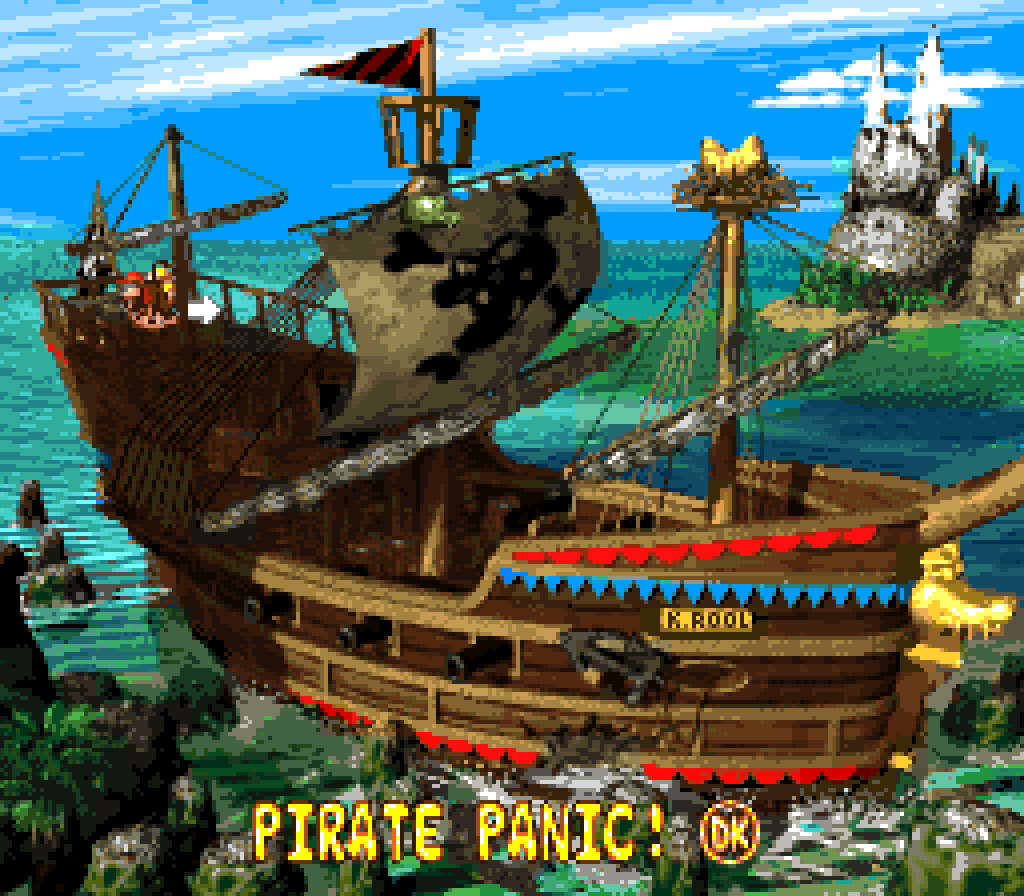
In terms o’ 1st levels, “Pirate Panic” is stronger than DKC3’s “Lakeside Limbo”, but weaker than DKC1’s “Jungle Hijinx”. It does its job o’ introducing mechanics such as throwing your partner up to reach greater heights, holding A to use Rambi’s super charge, & the existence o’ the per-level hero coin, in plain sight for the only time in this level, but it doesn’t do so in particular interesting ways — they just sort o’ put these things in a sequence from left to right, banana formations giving information. One might suspect that the designers wanted to keep this level simple & basic to not o’erwhelm new players, but it comes @ the cost o’ being interesting or memorable; & if you compare to DKC1’s “Jungle Hijinx”, that level had multiple layers, with far mo’ cool collectibles you can grab.
But something this level does copy from DKC1’s “Jungle Hijinx” ( & also like the original Super Mario Bros.’s World 1-1 with its Starman, tho mo’ cool & used for puzzle-solving, too ), this level takes advantage o’ Rambi’s ability to bulldoze o’er everything to offer beginning players an exciting but easy way to play this level. While self-plagiarism is ne’er the best design tool, there is something funny ’bout having Rambi now on a pirate ship, where you usually don’t find rhinos, ’stead o’ in their natural habitat, the jungle.
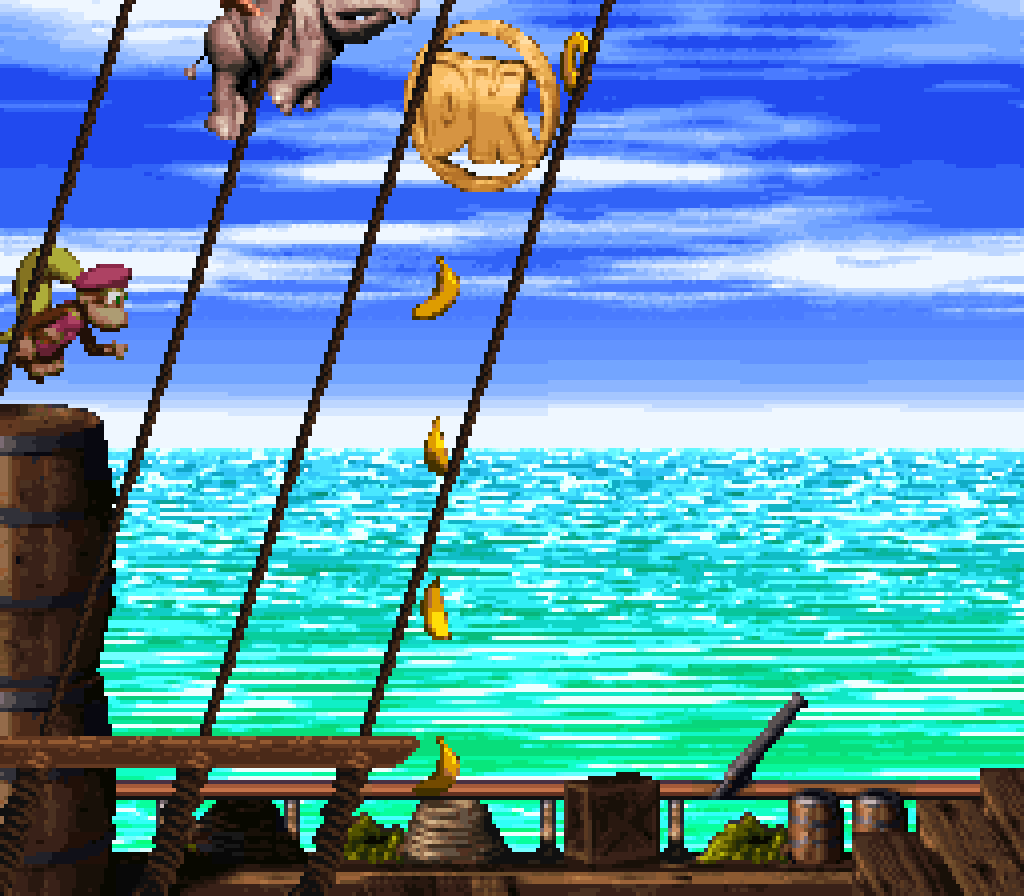
The note in the pirate ship wherein “Kaptain K. Rool” for some reason gives ’way to Diddy & Dixie that he captured DK, rather than delay them by making them figure it out themselves, is much less memorable than the small cutscene o’ DK looking down in shame @ his empty banana hoard.
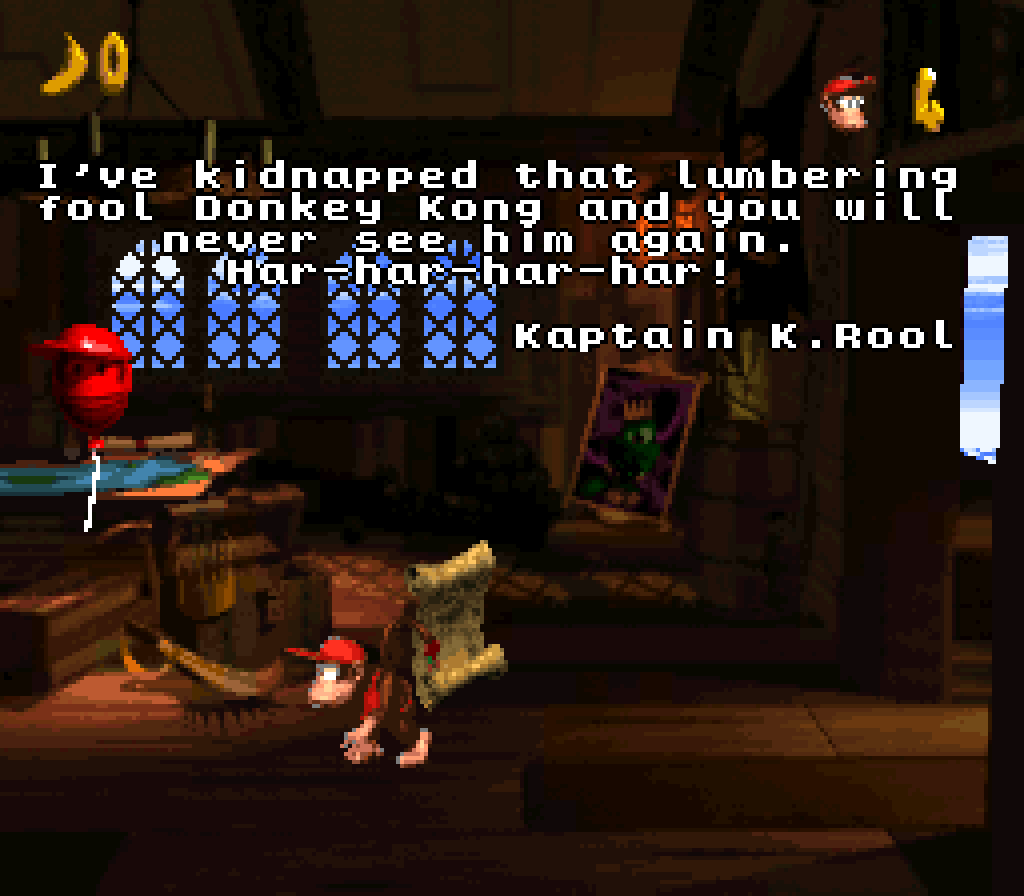
Both bonus challenges work well as introductions to the 2 most common bonus challenge types, getting to the end & defeating all the enemies in time, the latter taking advantage o’ Rambi in the same way the o’erall level does. The 1st bonus, being the 1st, can be forgiven for being so simple, specially when it does add extras like the the banana coin on the lower path & adds a secret reward to players who remember the up-throw move by giving them an easier, faster way to reach the top without making all the barrel jumps.
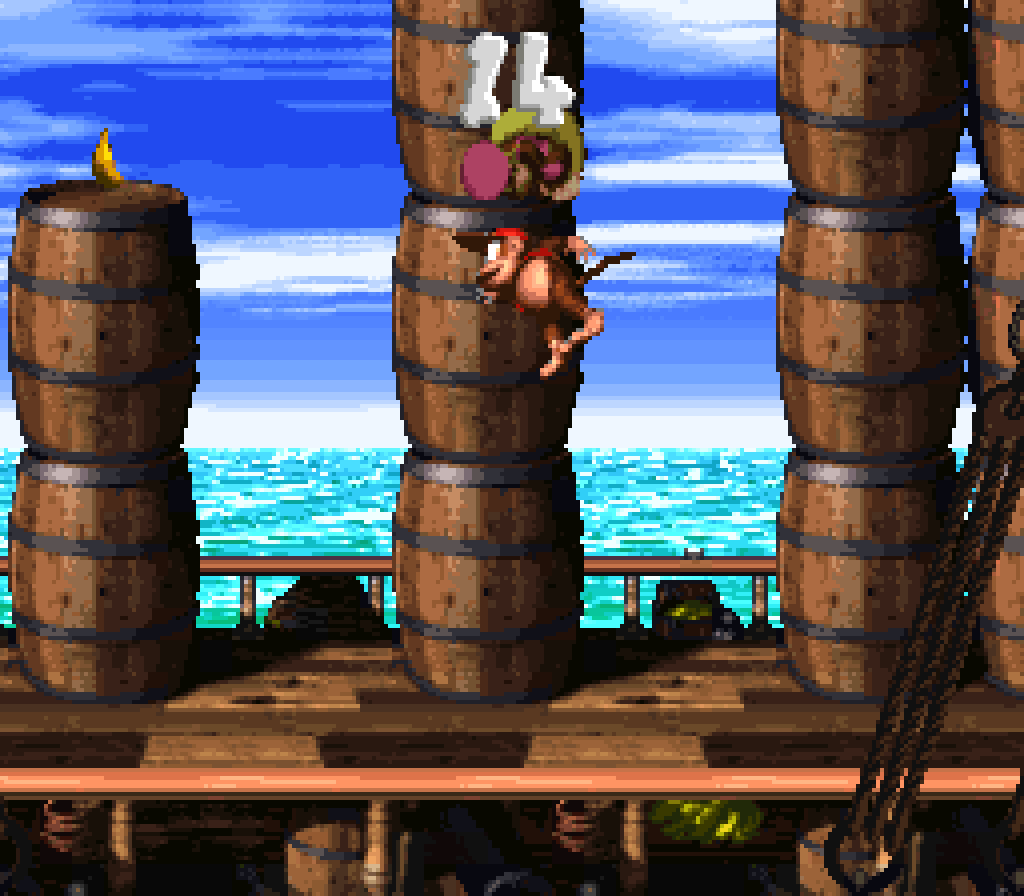
The 2nd bonus is subtly cleverly placed ’hind a door gainst a left wall, forcing you to turn left after running down the barrel stairs ’bove it & making use o’ Rambi’s super charge, tutorialized earlier. The banana arrow not only lets them know that door is there but hammers into the player that that door is important; otherwise, e’en if the player did take the time to check down there ( which they should if they’re curious ), they might mistake the door as mere decoration.

I’m less impressed by the 1st bonus’s location, in a hole with bananas leading down, a bit o’ a cliché from the 1st game. But a’least this game adds a li’l pizazz with having the cannon shoot you up into the sky thru the weird wire window on the floor.
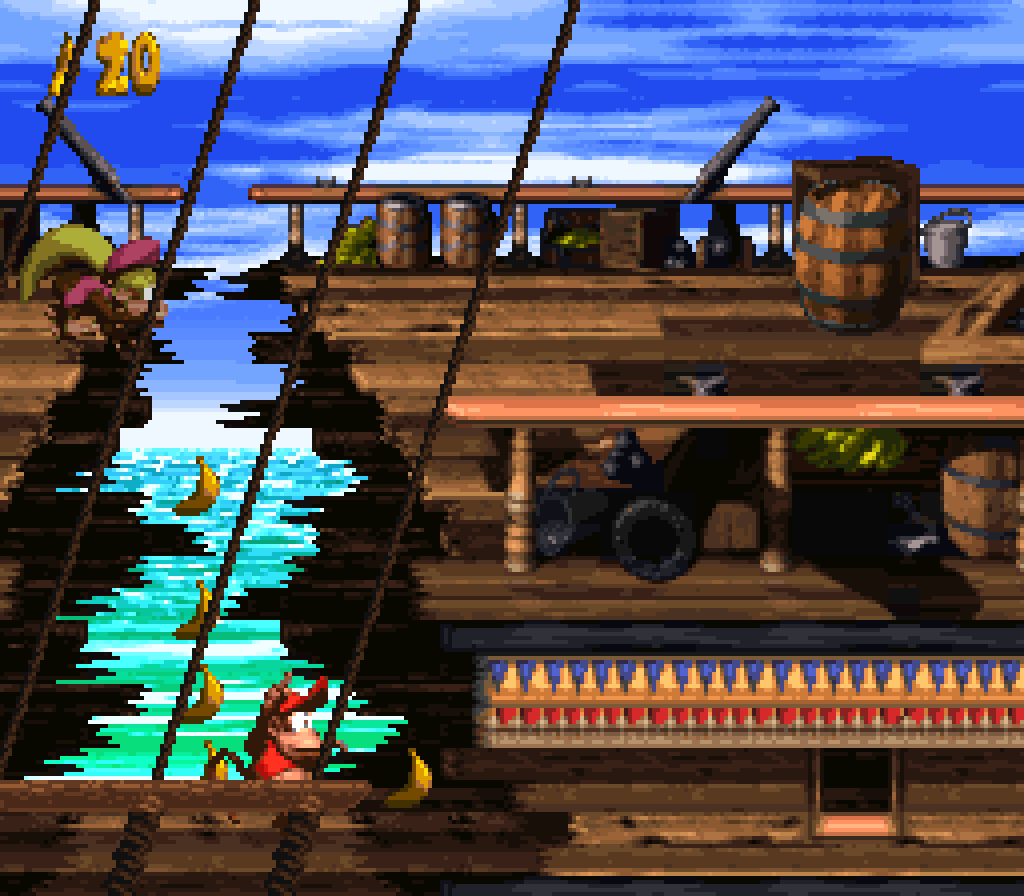
The feather adds a twist to the Kong-throw tutorial for a banana coin by having it on the other side o’ the platform, barely visible.
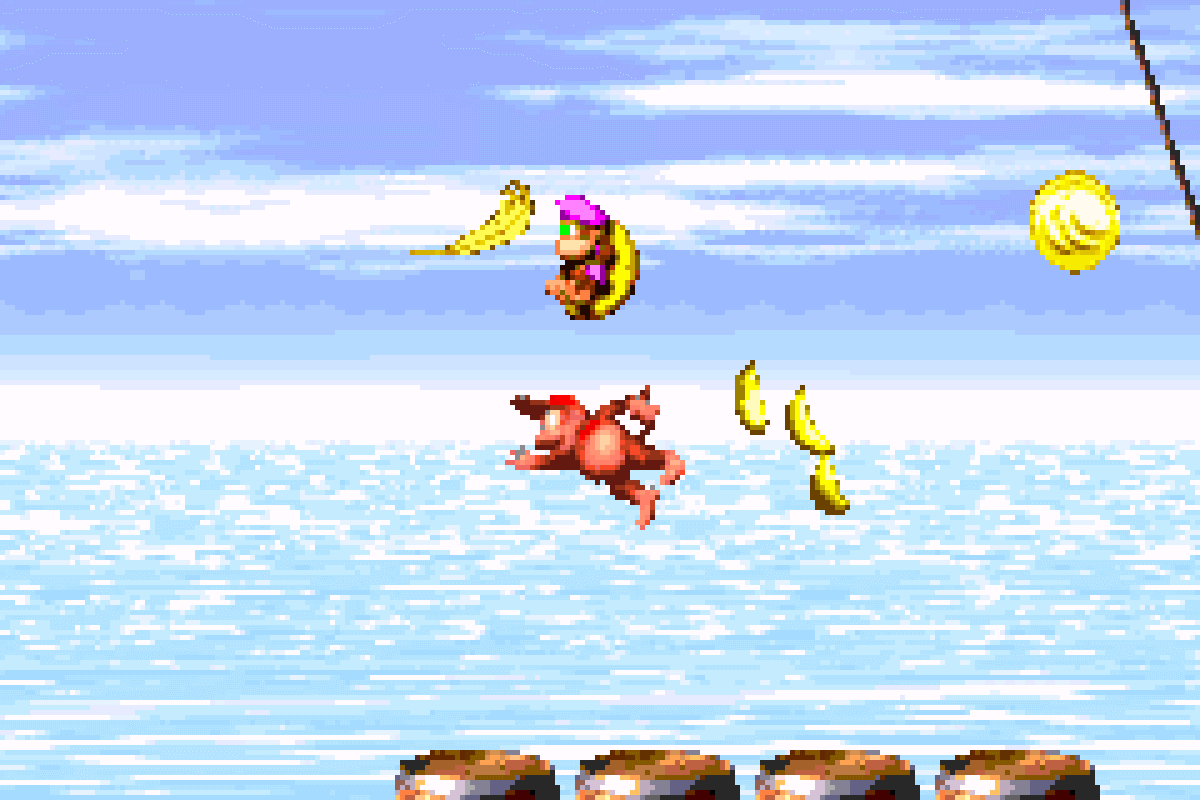
The photo location, meanwhile, is in a devious location: in the Rambi bonus, gotten by plowing the 1st enemy. That may not seem hard to find, since you’re guaranteed to hit that enemy while getting this mandatory bonus; but the twist is that you can’t get the photo till you visit Wrinkly after you beat this level, & it’s unlikely players won’t have gotten this bonus on the 1st run thru. Wrinkly offers the hint that this level’s photo is gotten with Rambi, but nothing mo’ concrete. & yet it’s ’nough o’ a hint that players may ’ventually try it out o’ desperation.
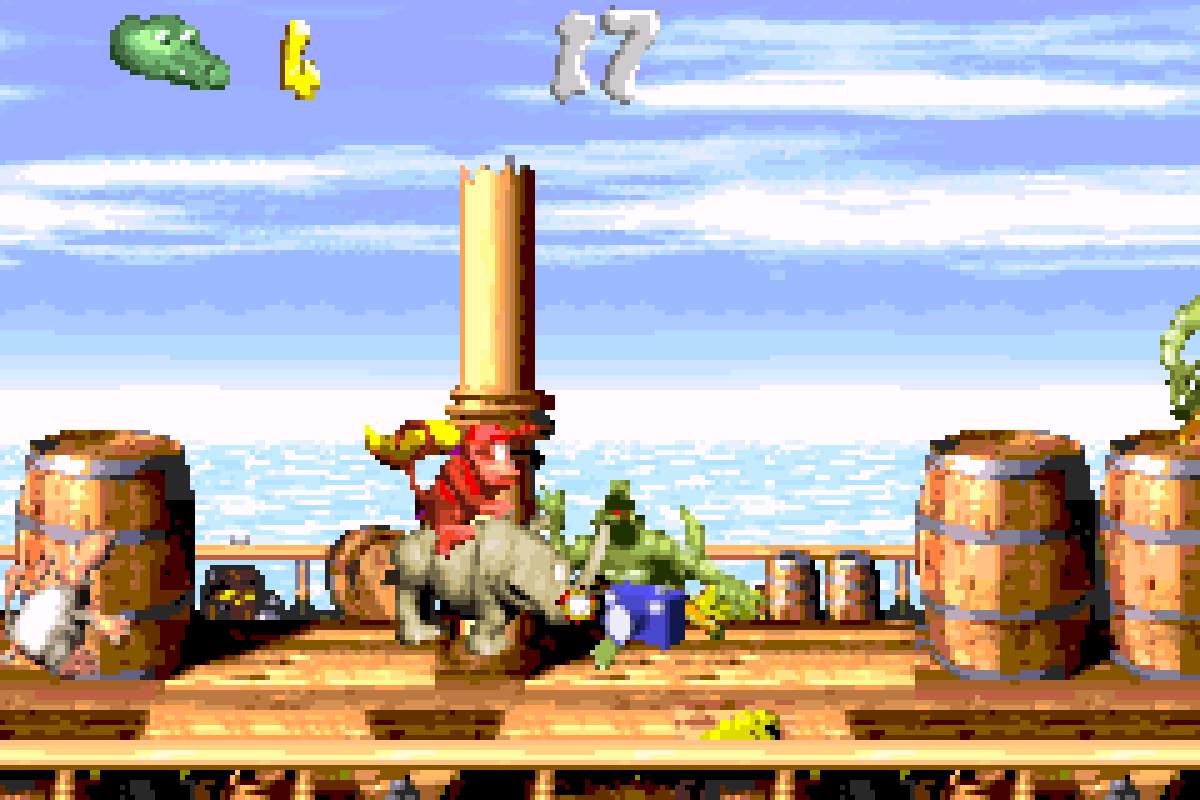
Like “Hot-Head Hop”, this level’s main path is mostly just basic jumps & rolling gainst basic enemies, ’cept this works better for the 1st level than the 6th level, the animal buddy in this level actually contributes to this level’s construction rather than hinders it, & this level’s theme is mo’ refreshing & memorable. “Hot-Head Hop” did have mo’ collectibles, tho: I think it probably would’ve made mo’ sense to have all those chests in this level than in “Hot-Head Hop”, since chests belong more on a pirate ship than in a volcano.

This level does have a weird secret blast barrel right @ the beginning which you can only get by throwing a Kong up @ it — which means that ’less you’re playing on hard mode, you have to backtrack or re-enter the level to get it, as you don’t start with a 2nd Kong on normal mode. This blast barrel only gives you some bananas & a banana coin, so I’m not sure why they placed this here. I guess just as a cool bonus to reward backtracking. It doesn’t hurt the level; it’s just weird.
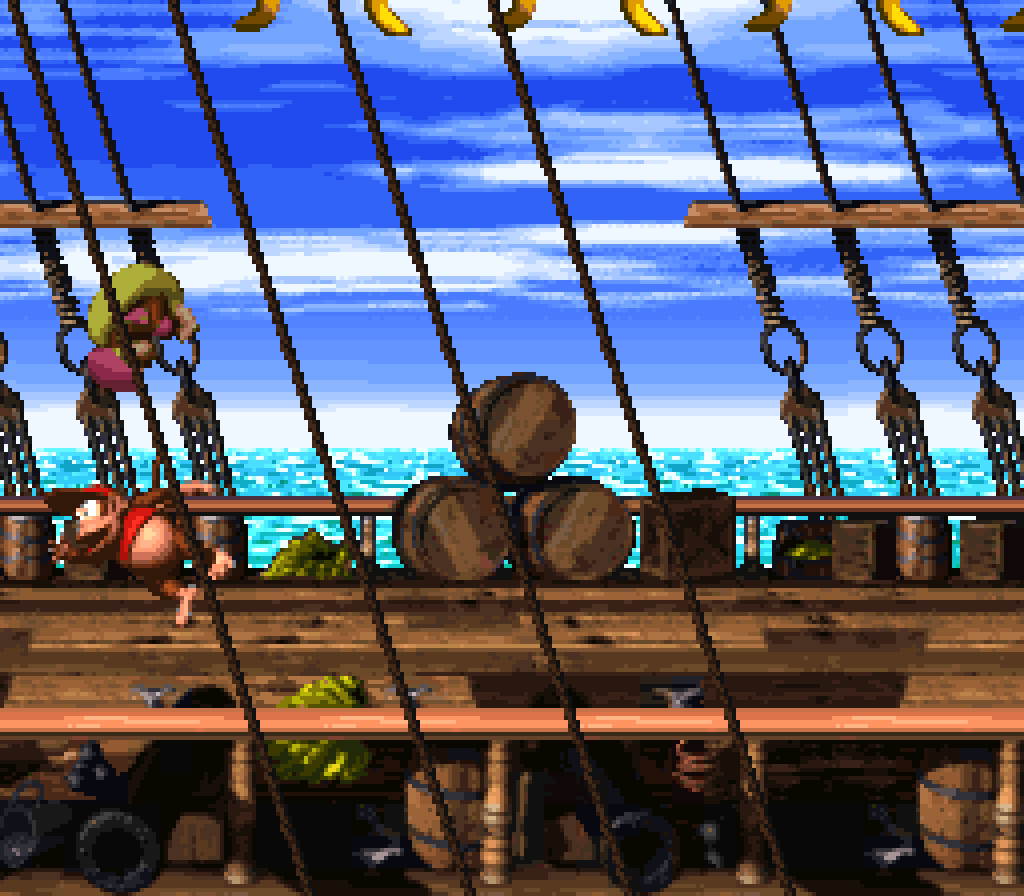
This level deserves a lot o’ points for starting with a pirate theme, which is not only an exotic theme for the beginning o’ the game — certainly a breath o’ fresh air from the common grassland or forests o’ most games — but also ties this game’s beginning with the end o’ the previous game.
This theme’s song, “Klomp’s Romp”, is probably nobody’s favorite, being much mo’ laid back than most other songs, but it fits these easier levels, & the slow build up must’ve been refreshing @ the time. It’s a much mo’ subtle, gradual — & mo’ importantly, faster — build-up than the kind o’ nonsense David Wise would get up to in the GBA DKC3 soundtrack.
30. Hot-Head Hop
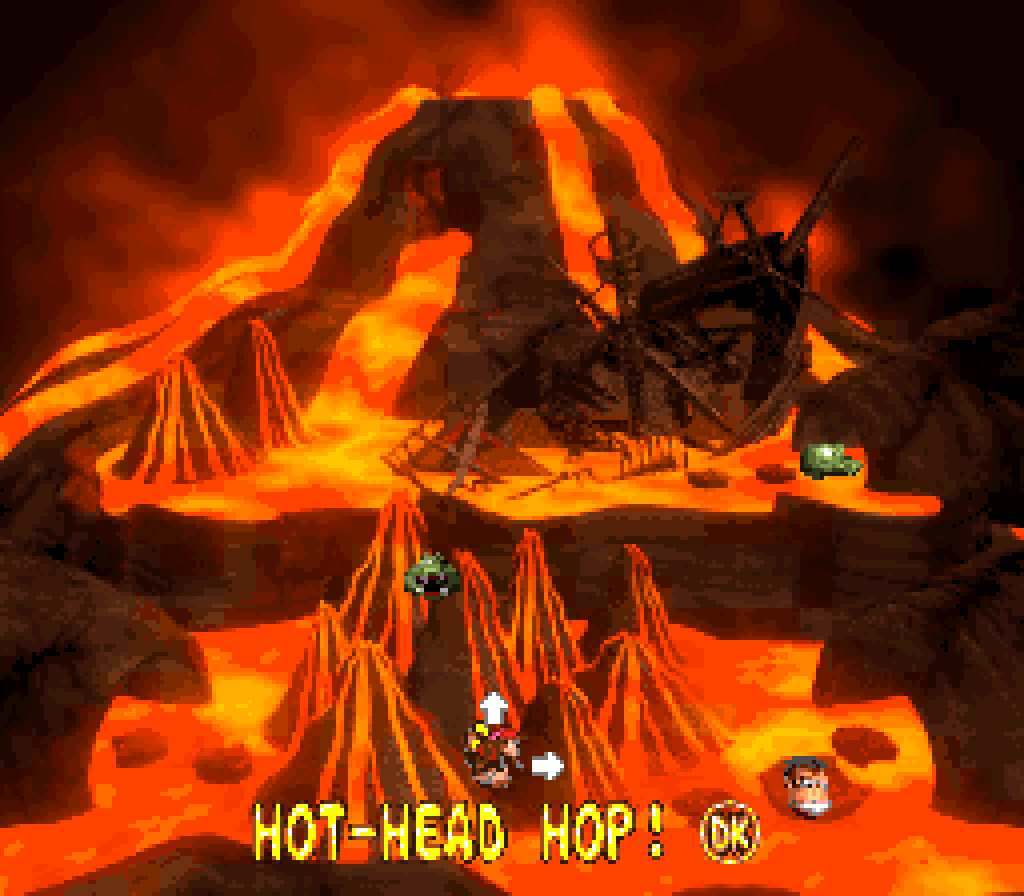
The hardest levels to write ’bout are the levels whose main strength is that there’s nothing much bad to say ’bout them, but whose chief flaws are that they have nothing much good to say ’bout them, either; & “Hot-Head Hop” may fit this criteria the most ’mong Donkey Kong Country 2’s levels.
I think if this level has any true flaw, it’s that minor flaw that its elements don’t feel like they belong together to create any kind o’ coherent theme, but just feel like a bunch o’ stuff thrown together. The closest thing this level has to a gimmick is crock heads floating in lava. The green heads are glorified lower ground while the brown heads bounce you forward. The green heads are a nice paint o’er ordinary ground & the way the brown heads move you forward in a specific way a spring moving that way would makes it a bit mo’ fine-tuned than your basic platformer bouncy block, tho. They then proceed to copypaste these crockheads in a straight path rightward with li’l variation. The most exciting thing they do with them is have a crockhead shoot you up to a high cliff. After that they have you hop ’long 4 heads, & then 4 heads broken up by a short platform. It’s very repetitive.
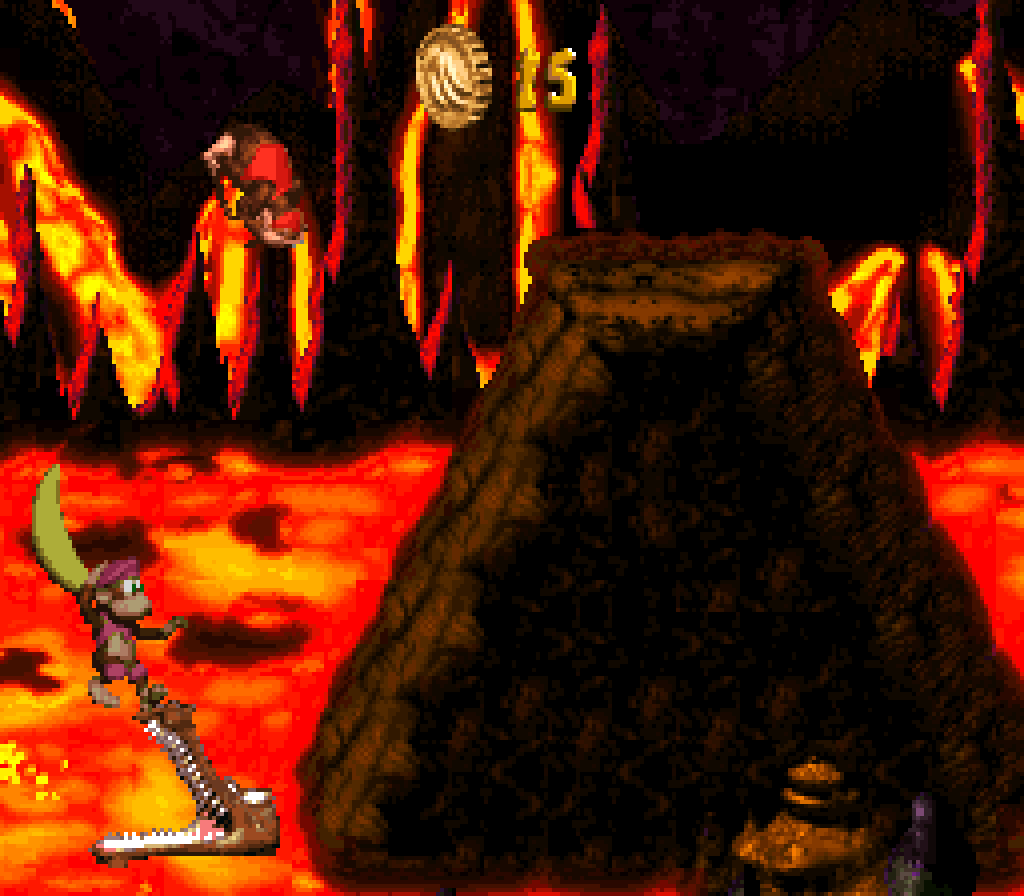
To make this 1st half a li’l less 1-note & basic, they also fill it with plenty o’ chests you can break open on enemies for goodies, which can be fun for newbie or young players who may want to stock up on lives before this games starts getting hard, but can feel slow, with your character stopping for a moment e’ery time you pick up an item & then ’gain e’ery time you break a chest open on an enemy, & specially if you stop to collect the item it gives. Honestly, I rarely bother & will e’en jump o’er crates to avoid the delays. This kind o’ thing feels like it works better for the earlier levels, not only ’cause they’re easier, but also ’cause chests fit better on a pirate ship than in a volcano; but I can appreciate the desire to create a “breather level” to start out the 2nd world, specially after the relatively hard final level o’ the 1st world. The 1st DKC does the same thing. Also, while it delays you e’en mo’ to throw your partner up to get it, I always liked the super dark chest up on the cave opening @ the start o’ the level.
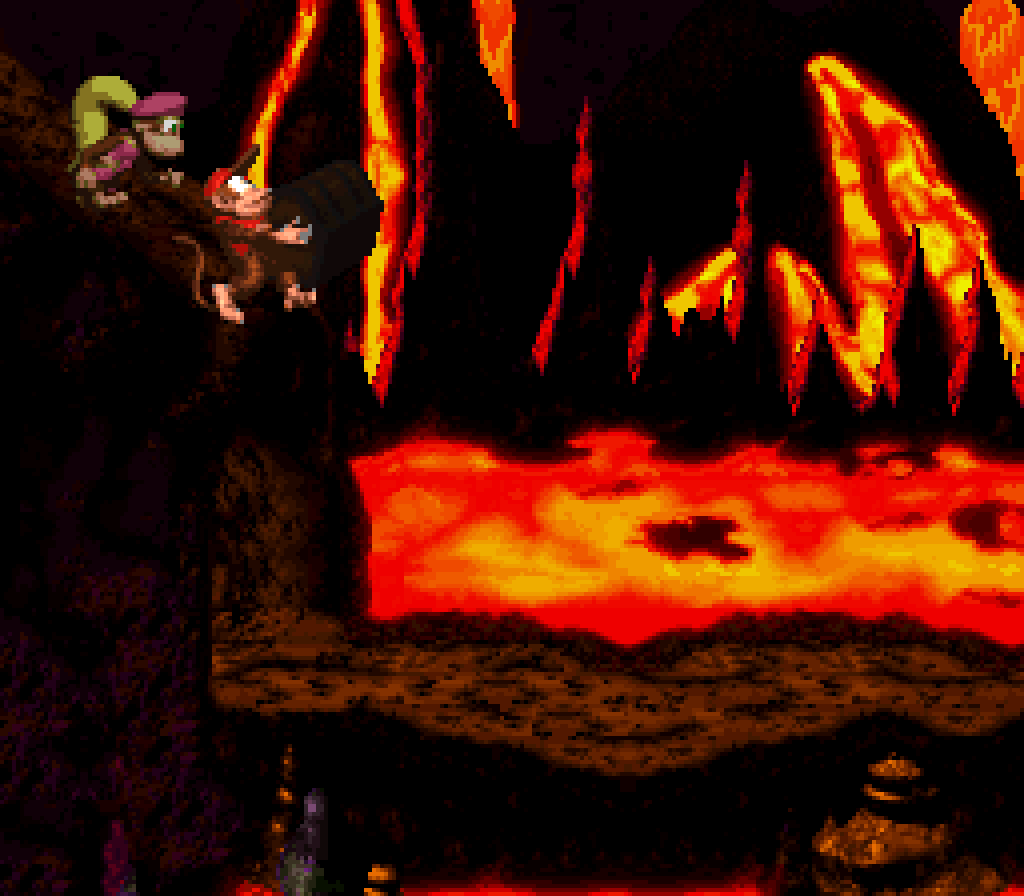
But that’s not interesting ’nough for a full level, either, so the 2nd half o’ this level focuses on the introduction to Squitter, the spider animal buddy, who can shoot webshots & create web platforms you can jump on. There is a logic to employing Squitter here: the vast seas o’ lava would make a perfect danger for Squitter’s web platformers to get past. ’Cept, that’s not what the 2nd half o’ this level entails, so much as mo’ basic platforming, ’cept now you can outright skip most o’ it with Squitter’s web platforms. I s’pose these setpieces work as backup in case you lose Squitter, & it’s not as if you miss anything by skipping them.
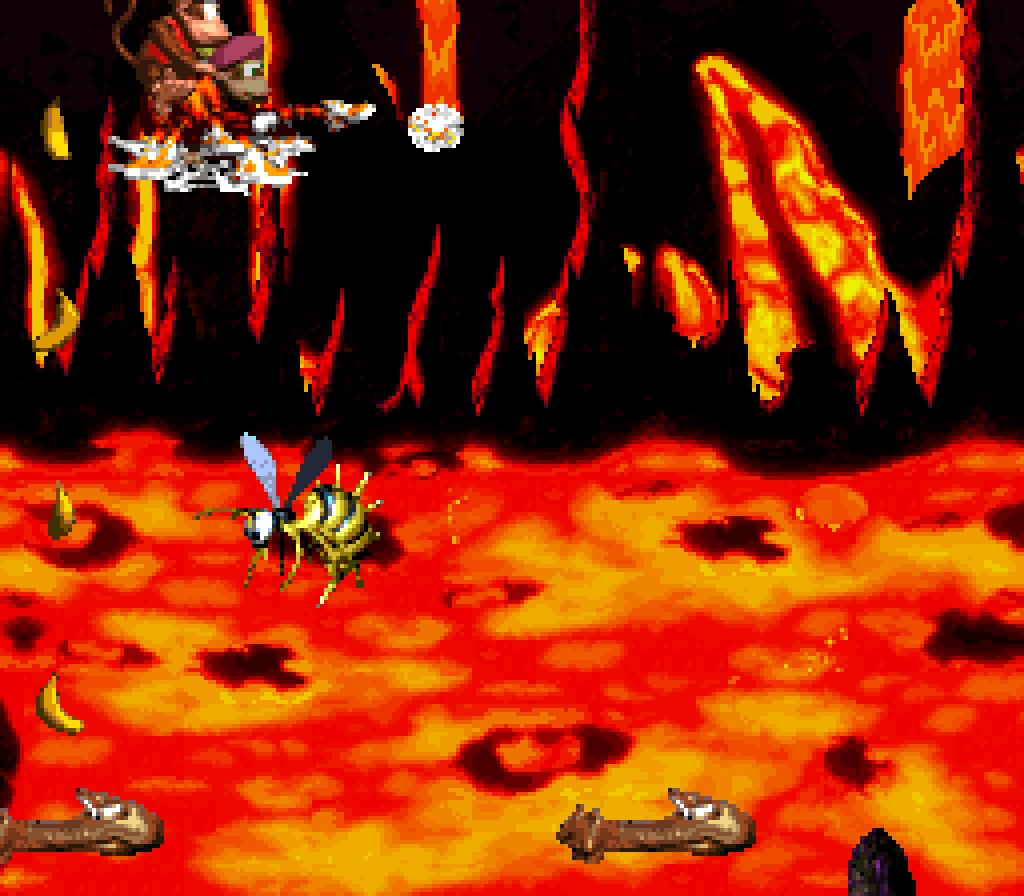
& then there’s that 1 line o’ Zingers you can skip whether or not you still have Squitter thanks to a convenient barrel cannon just ’bove & before, not e’en hidden in the slightest. I guess you could use Squitter to easily dispatch the Zingers & go the long way for some extra bananas & banana coins. Considering this game throws both @ you for doing less, I don’t know why you would bother & have ne’er seen anyone bother.
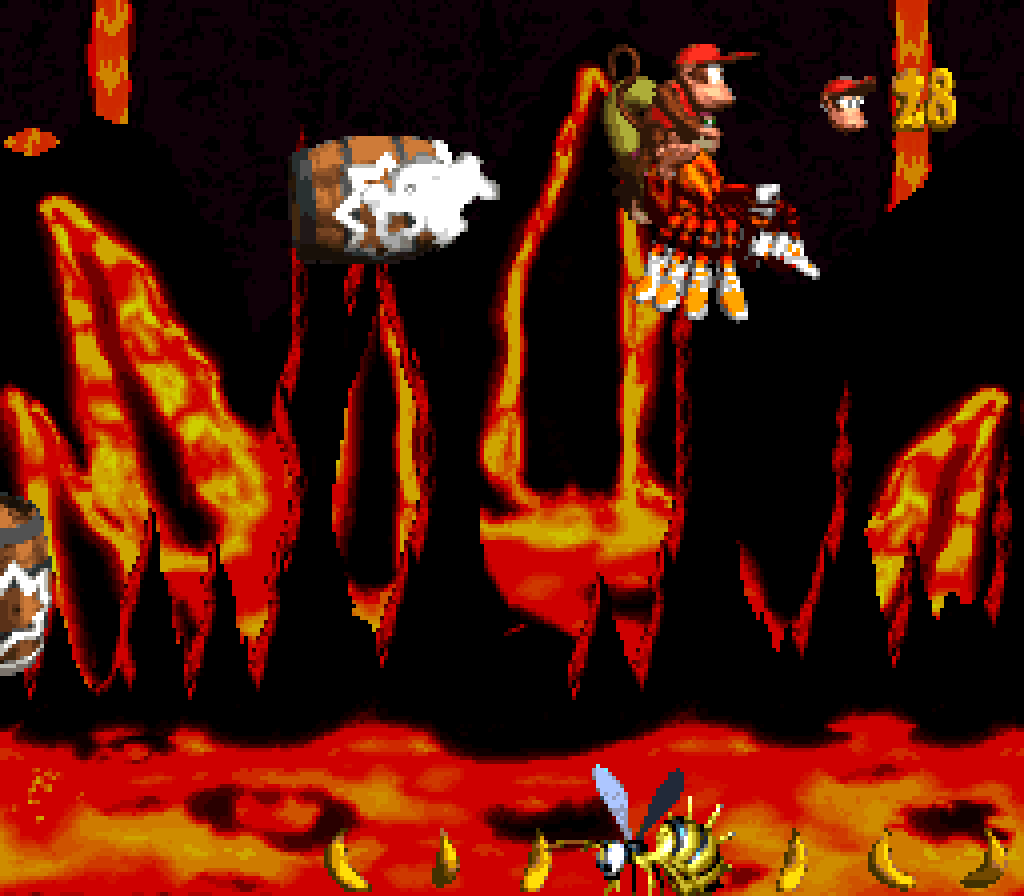
This level’s bonuses are meh, too. 2 o’ the bonuses just involve going higher up with the spider @ various places ’tween when you 1st get Squitter & when you lose them, with the only minor change being that the 2nd o’ these bonuses is low ’nough that you could reach it by just throwing a character up @ it. It’s not e’en hidden. Since this level already has 2 other bonuses, I’m not sure why the developers felt the need to add this 3rd bonus. Surely they didn’t think this lame hiding place was worth the extra effort. The 2 Squitter bonus challenges themselves are just as lame: the 1st involves going upward using Squitter’s webs & the 2nd involves going up & to the right using Squitter’s web. ’Gain, I can’t see the use for that 3rd bonus: it is truly redundant.
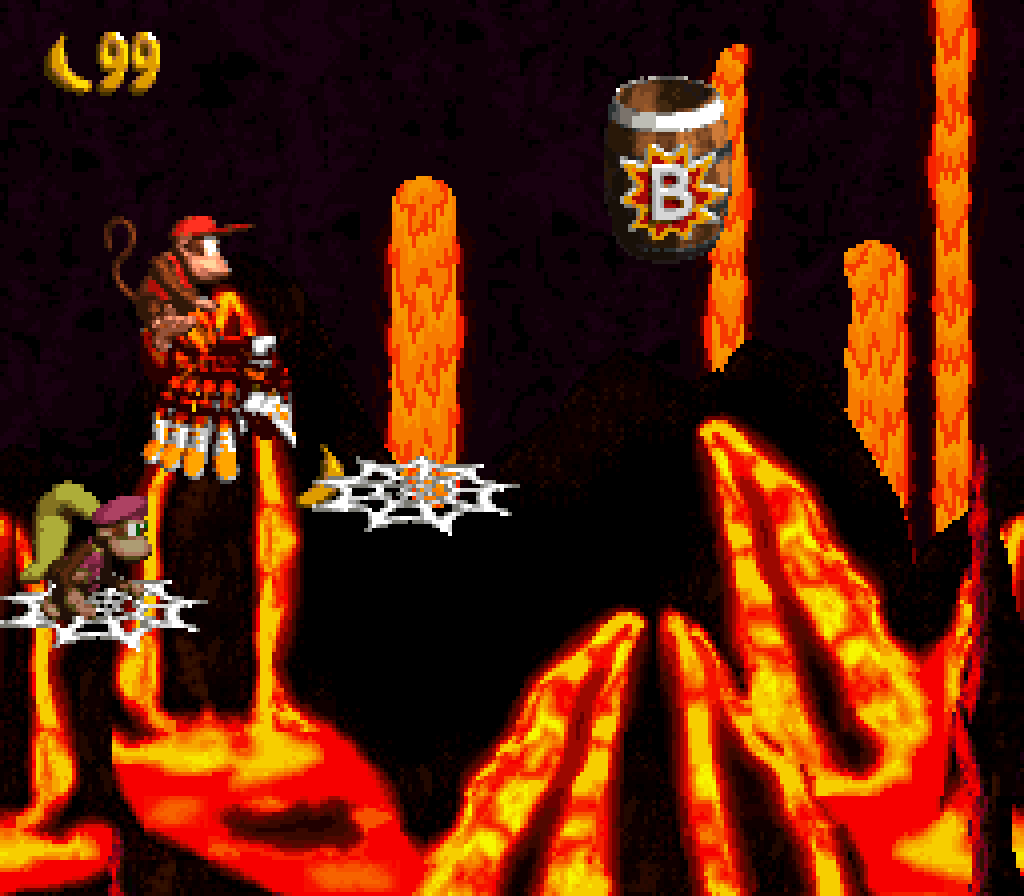
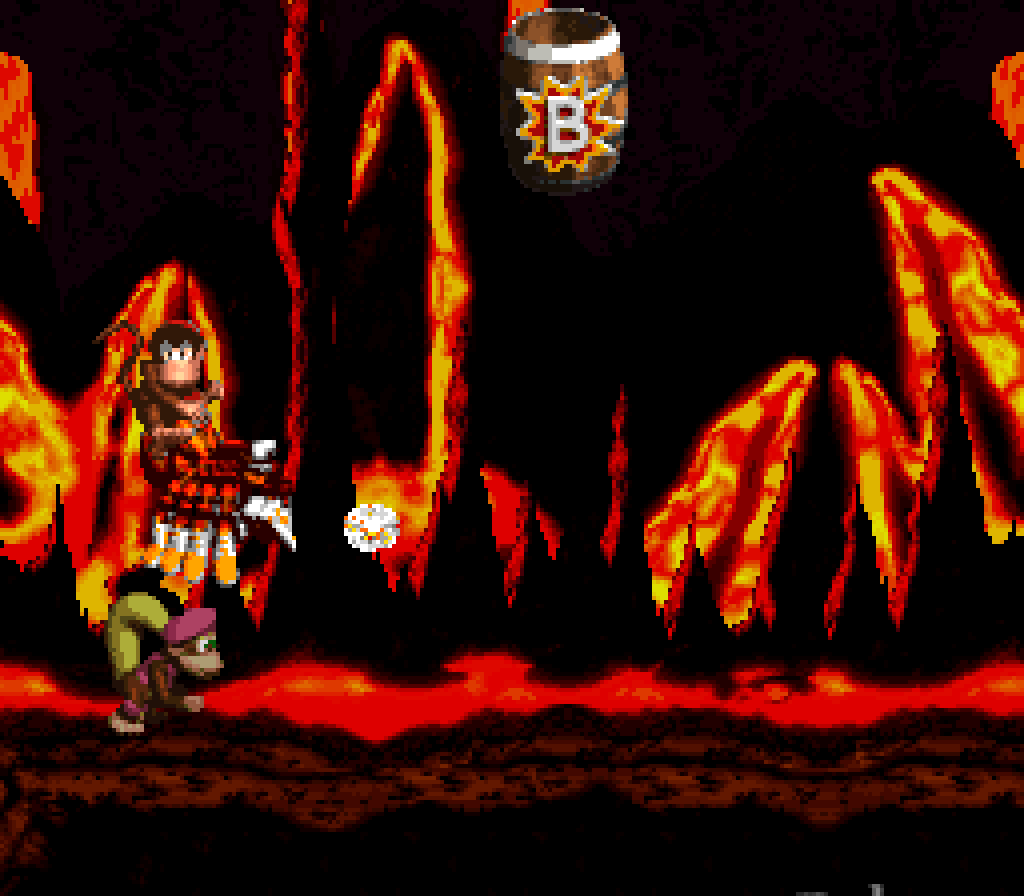
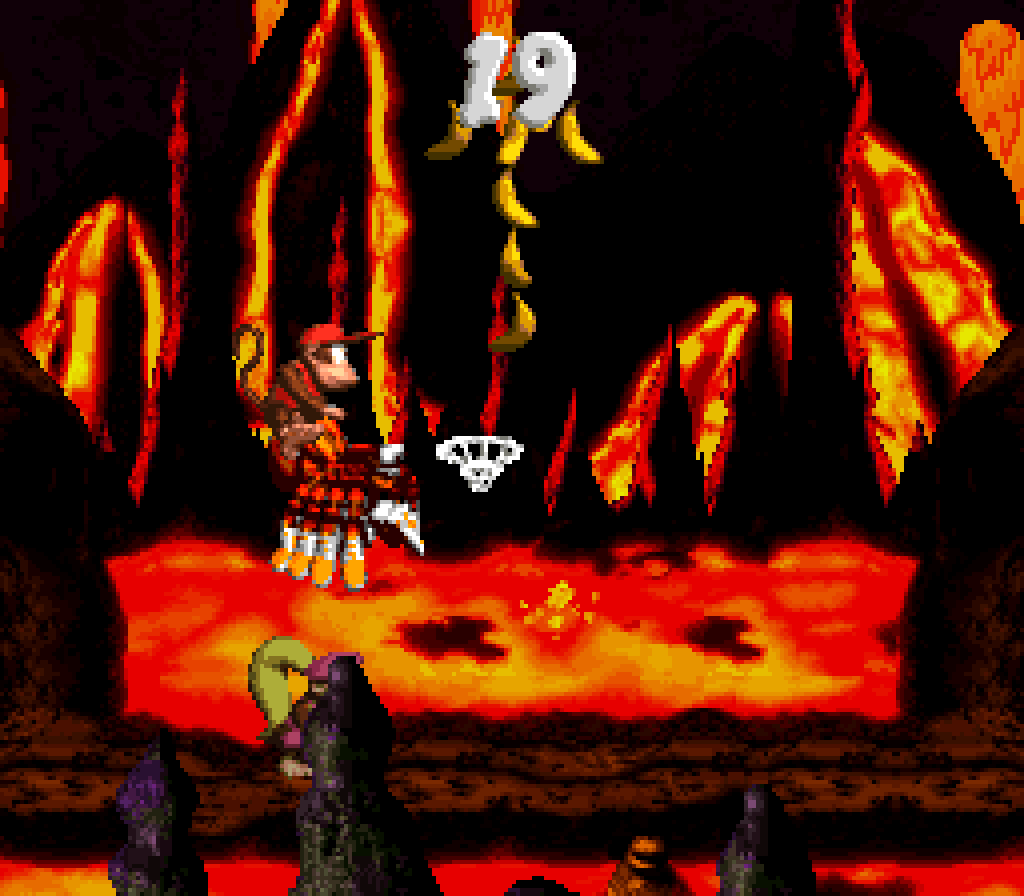
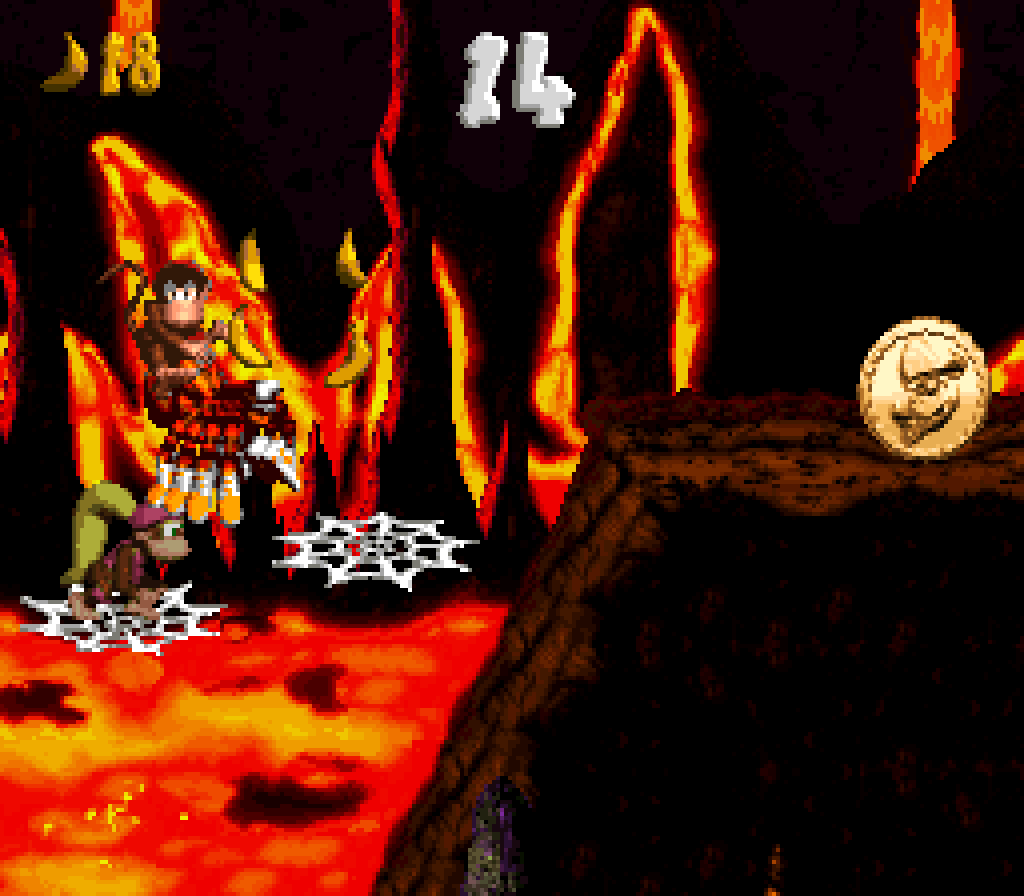
The hero coin is also just up high, accessible the same way as 2/3 o’ the bonus barrels, with the 1 twist being that it’s before the game officially tutorializes the web platform mechanic with the A-button banana formation — which is ’nother reason only 2 bonuses would’ve been better than 3, as 1 mo’ up in the air just makes this hero coin location all the mo’ repetitive. It’s far from the worst hiding place — specially in such a basic level that doesn’t offer many ideas for hiding places.

The 1st bonus is a li’l mo’ interesting, but not particularly impressive. It involves opening 1 o’ this level’s many chests to release a cannonball & carry that cannonball ’cross a few crock heads to the cannon. This is something you already had to do in “Mainbrace Mayhem”, where a cannon fits better, since that was actually a pirate ship. Here it’s also mo’ repetitive, essentially copypasting the same crock heads & small platform with a Klampon on it. The bonus challenge itself, using the bouncy crock heads to collect stars, is 1 o’ the most entertaining bonuses o’ the game, tho, forcing players to use the forward-moving spring effects in a less straightforward manner than the level itself, & meshes well with the initial theme o’ this level.
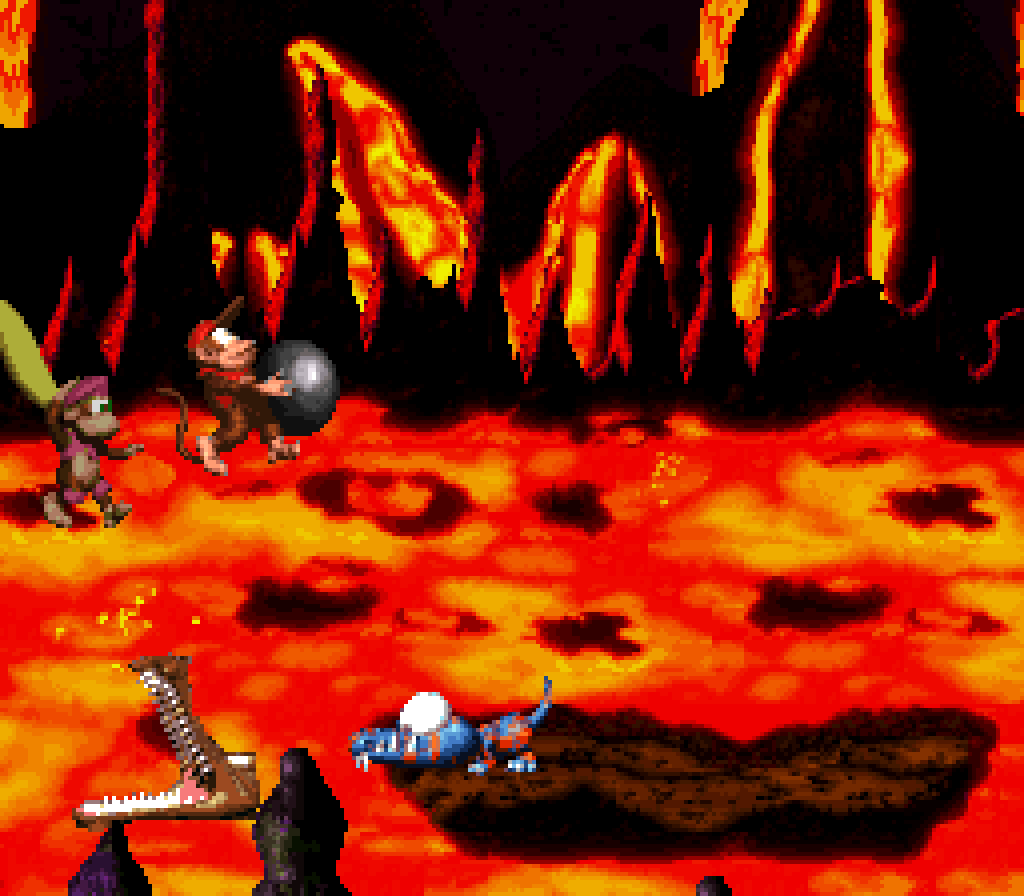
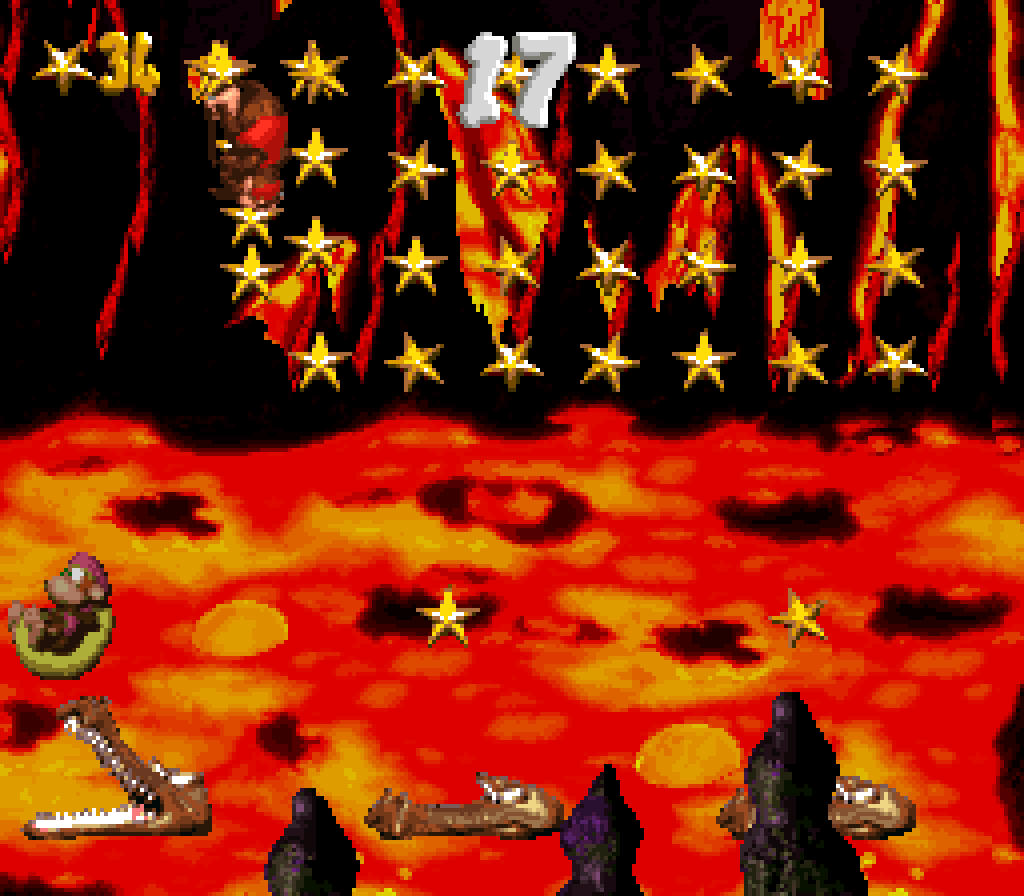
Unsurprisingly, the GBA collectibles aren’t very creative, either, tho they do tie in with what passes for the thematic elements o’ this level. The feather is hidden in 1 o’ the many chests you can break open on enemies, while the photo is gotten by destroying a Klobber in plain sight with Squitter.
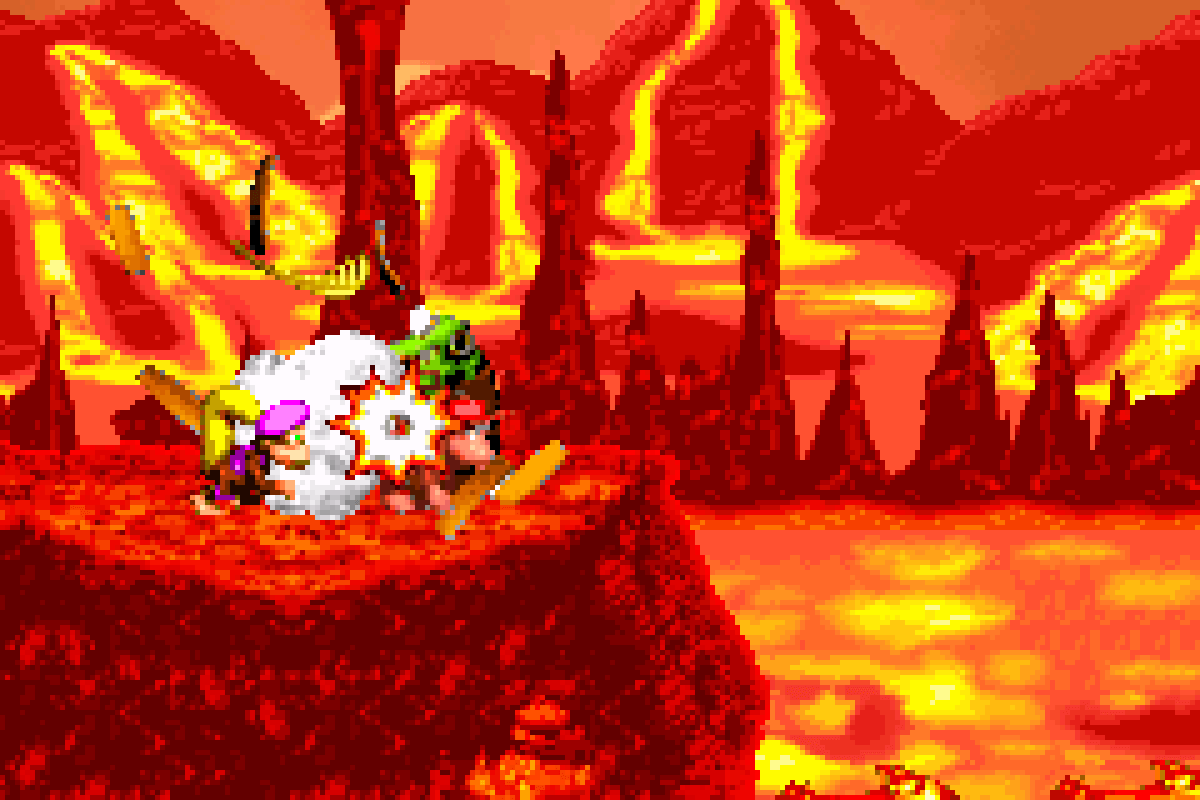
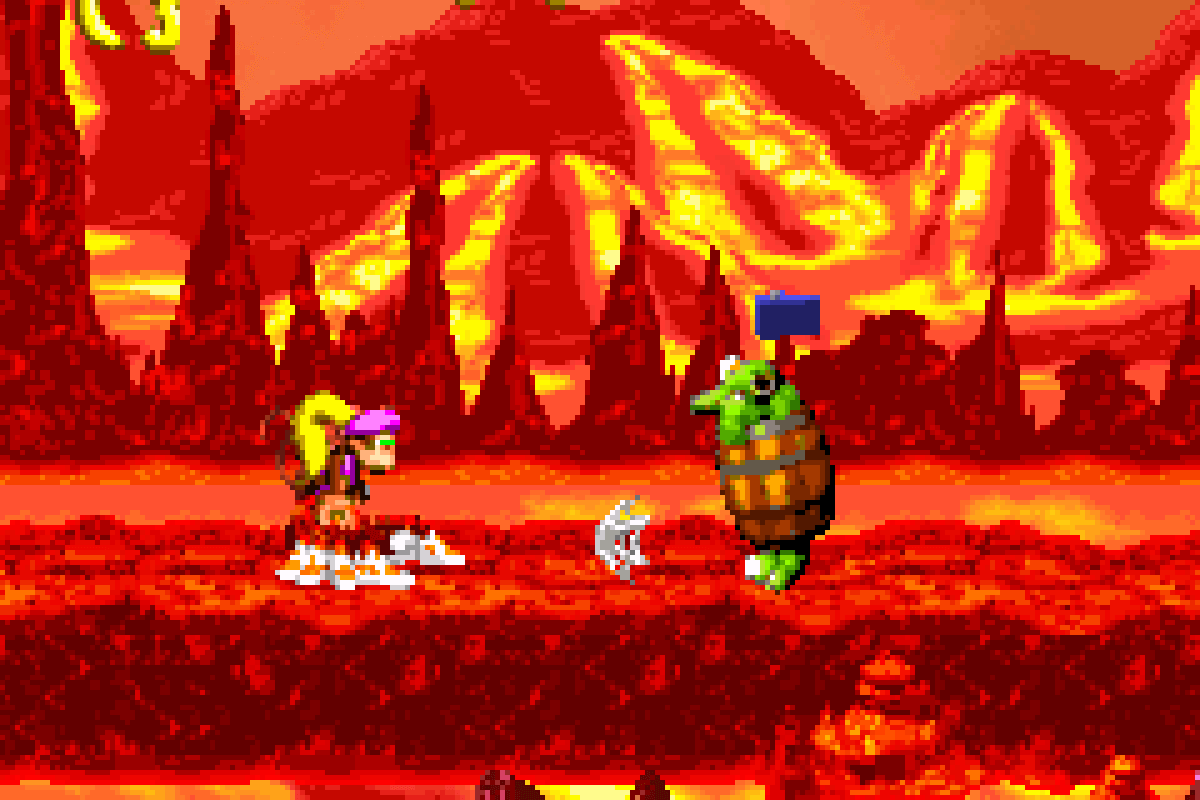
I think a big problem with this level is that it’s too flat, which ’splains why they feel the need to keep making you go upward for bonuses, to make use o’ the otherwise empty top half. Since you’re using a character who can move upward, a greater emphasis on upward movement would’ve made sense, & you could’ve still had platforms as backup. Rattly & Squawks, howe’er controversial they both are as animal buddies, receive much better introductions that do a better job o’ integrating them with their levels. It’s hard not to compare this level to “Winky’s Walkway” from DKC1, also a basic, straightforward level. Howe’er, it shows how much better DKC2’s levels are than DKC1 that this level is much better than that, e’en tho this level is nearer to the bottom than “Winky’s Walkway” was in the DKC1 list.
Still, I can’t help but appreciate that despite this level being so basic, they did think o’ ways to spice it up with hidden goodies, specially near the start, such as with the super dark chest hidden up ’bove the level entrance. Other levels — in both this game & its predecessor — had mo’ interesting rewards & puzzles revolving round going ’bove the start, but it goes to show that e’en 1 o’ the mo’ thrown-together levels in this game had extra touches added to it.
I have mixed feelings ’bout this level’s theme. The lava theme is probably the least exotic theme in this game — which says something nice ’bout this game’s themes, since it’s hardly the most boring theme; but the way they make it the 2nd world rather than the last, as most games do, is something o’ a twist. Plus, the simple, bright, almost-neon lava gainst the black cave background provides a striking contrast to the usual low-saturation, grungier, mo’ detailed backgrounds most levels in the whole trilogy have — tho I am disappointed that there are no palette differences ’tween the 3 lava levels, like most themes have, making them all look similar. Finally, “Hot-Head Bop” is the best DKC song e’er created with the way it smoothly slides from menacing low beats to soulful melodies. It’s much better than “Stickerbrush Symphony”, which lays it on a bit too thick with the sugary symphony music.
29. Mudhole Marsh
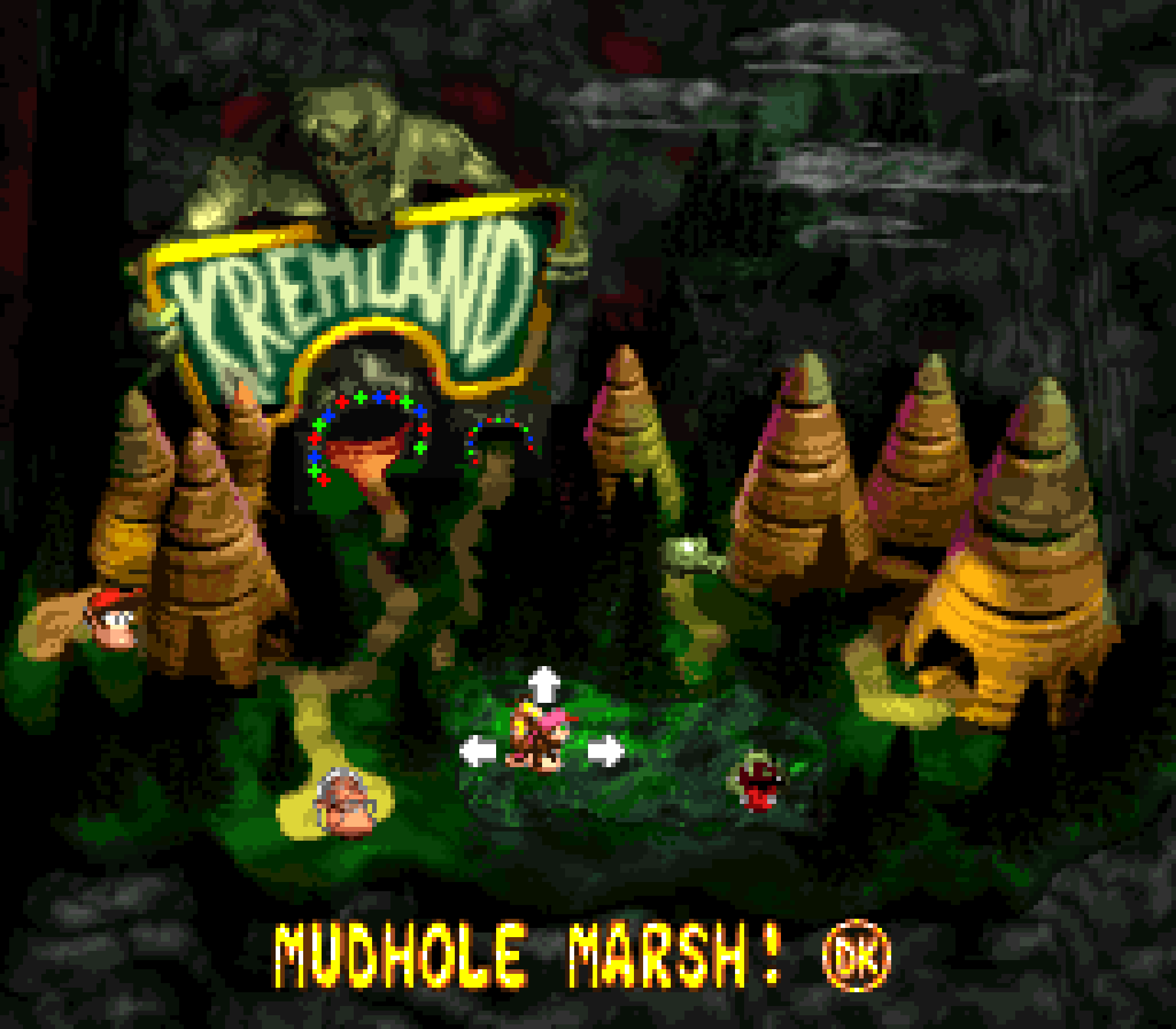
This level just feels like they threw together ideas not good ’nough for other levels, specially the other swamp levels. We have 2 setpieces o’ dodging Zingers on hooks, so short that it feels awkwardly squeezed in, which was already done in much mo’ interesting ways in “Krockhead Klamber”; Click-Clacks just walking round on platforms no different than in the 2nd level o’ this game; & Flitter swarms @ the beginning, also just there — tho there is a banana coin you can bounce up Flitters to get. I guess it is the easiest banana coin to get from the start o’ a level in this world, if the player for some reason is short on banana coins & needs to save.
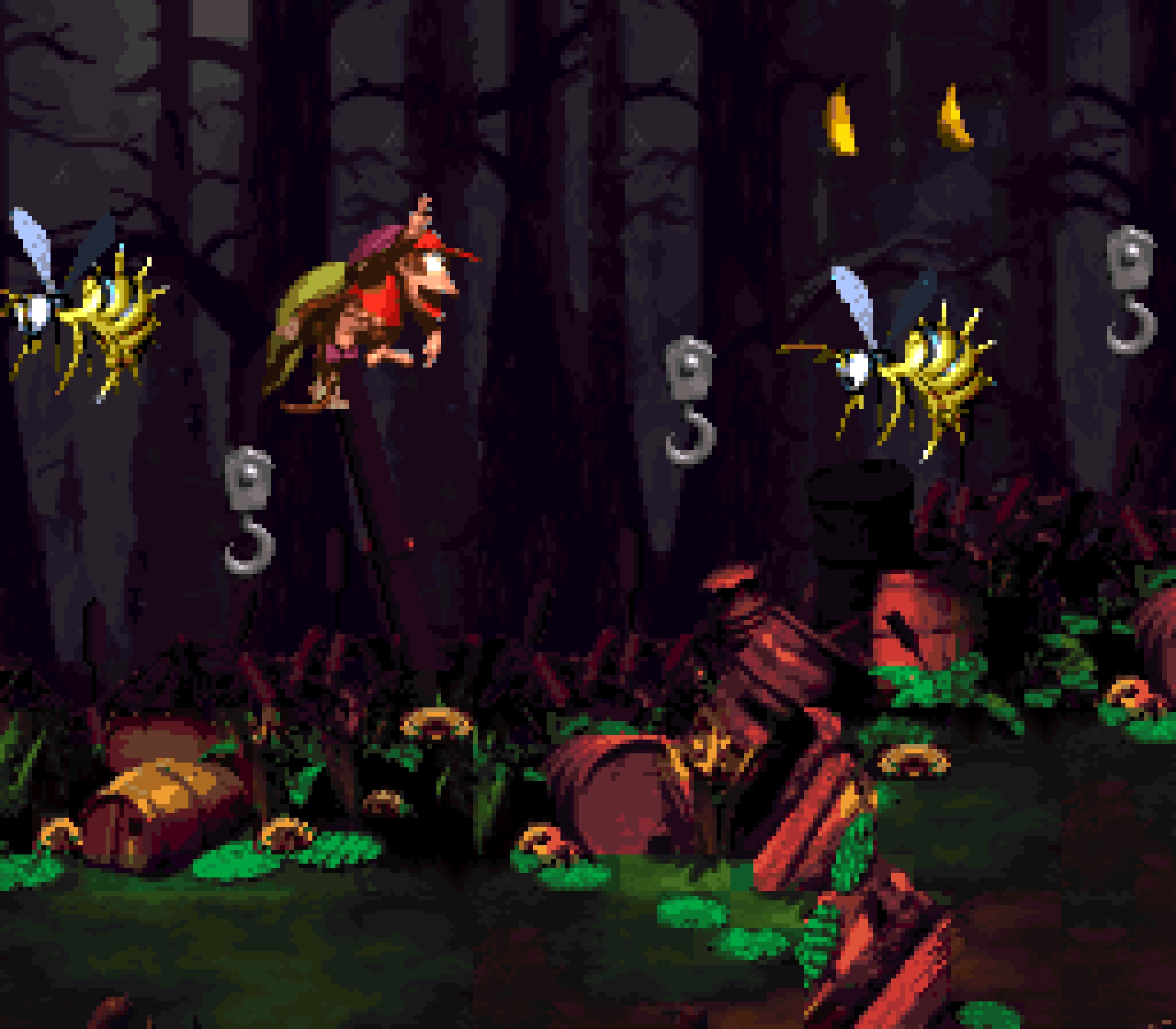

For instance, they bloated this level with Mini-Neckies after Mini-Neckies, with 3 waves o’ them. While the 3rd wave, challenging you to dodge Mini-Neckies while hanging on cattails, meshes well with the swamp theme in way Mini-Neckies hadn’t truly been used before, the other 2 are no different than the onslaughts you’ve dodged in “Kannon’s Klaim” 2 worlds ago. Many o’ them e’en give you a bunch o’ chests to break on them, like @ the end o’ “Kannon’s Klaim”; but whereas that chest was timed so that ’twould break @ just the right # o’ Mini-Neckies, there’s 1 with a banana bunch — such a great prize — that, if you break it gainst all the Mini-Neckies, breaks only on the 3rd Mini-Necky, causing you to fall into the way o’ the 4th Mini-Necky unprotected. You could say this is mo’ challenging, but it’s really mo’ cheap, since it’s unexpected — chests usually break in only 1 hit or several mo’ than 3 — & anyway you can just dodge the Mini-Neckies mo’ easily without bothering with the chests @ all. In a game that went out o’ its way to choreograph e’erything right in a way that helped players mo’ than cheaply screwed them o’er, this awkward section stands out.

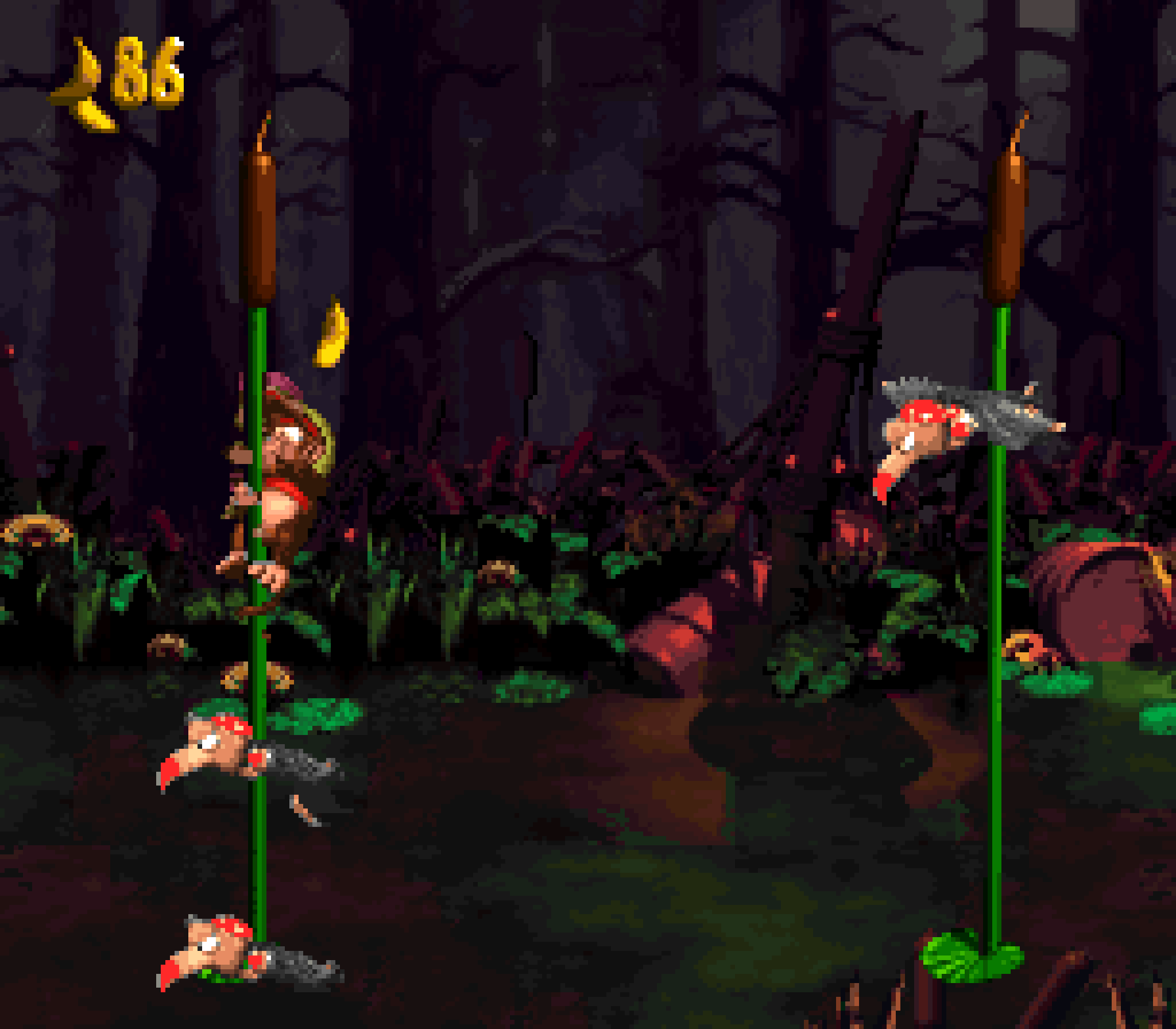
Probably the newest element this level has is a new enemy, the Cat-o’-9-Tails. This is unfortunate, as this enemy sucks: it doesn’t do much but threaten to hurt you or fling you in a seemingly random direction depending on how you touch it — the former if you let it hit you from the side, the latter if you try to jump on it, which makes no sense. There are a few places, such as the 1st bonus or both the K & G, where you can use the Cat-o’-9-Tails to reach it; but anyone who’s smart ’nough to not gamble will throw a Kong up to it ’stead. There is 1 part where there are Zingers ’bove, so you have a harder time timing a jump o’er Cat-o’-9-Tails, but that’s the most they do with this enemy in this level.
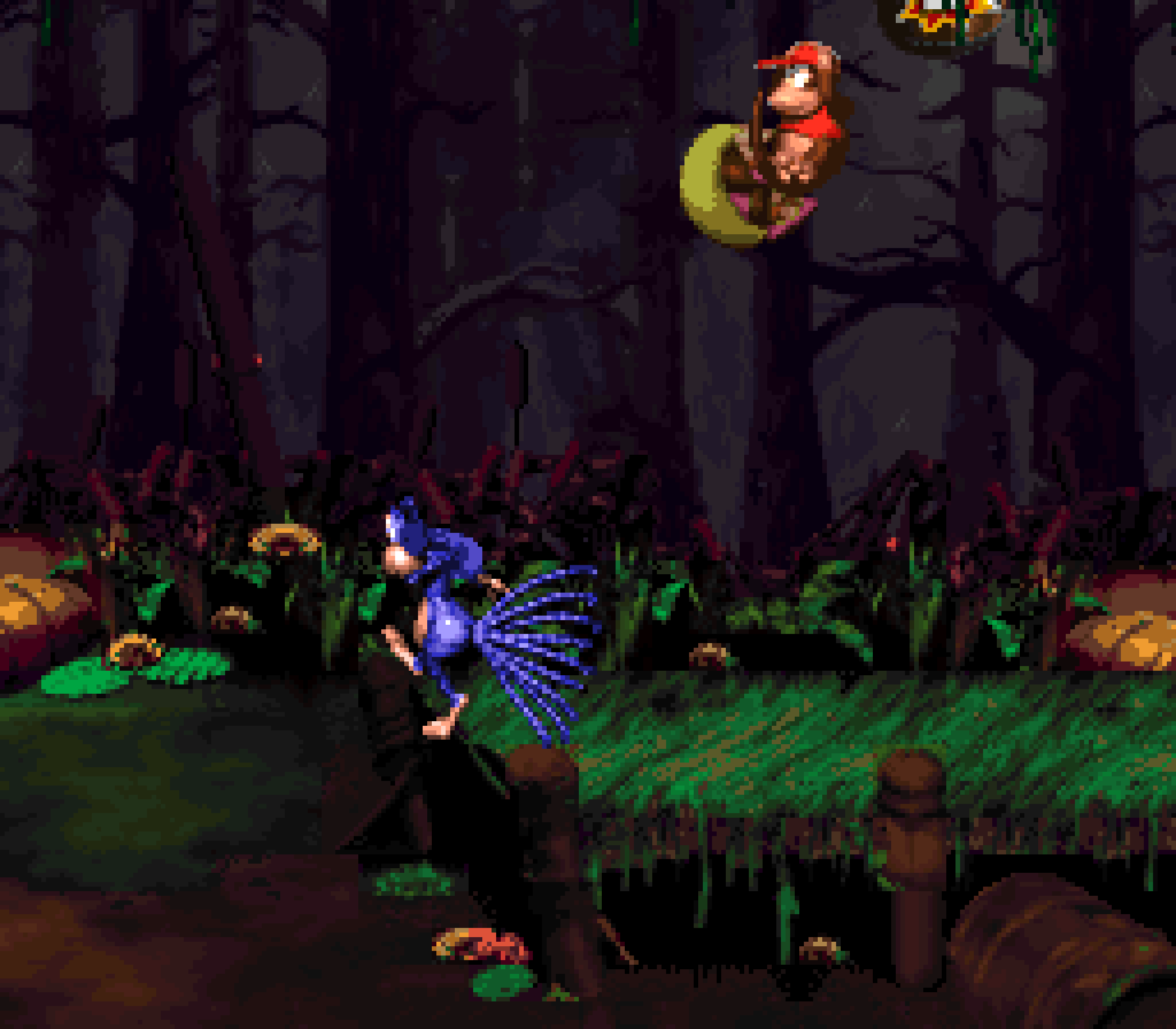
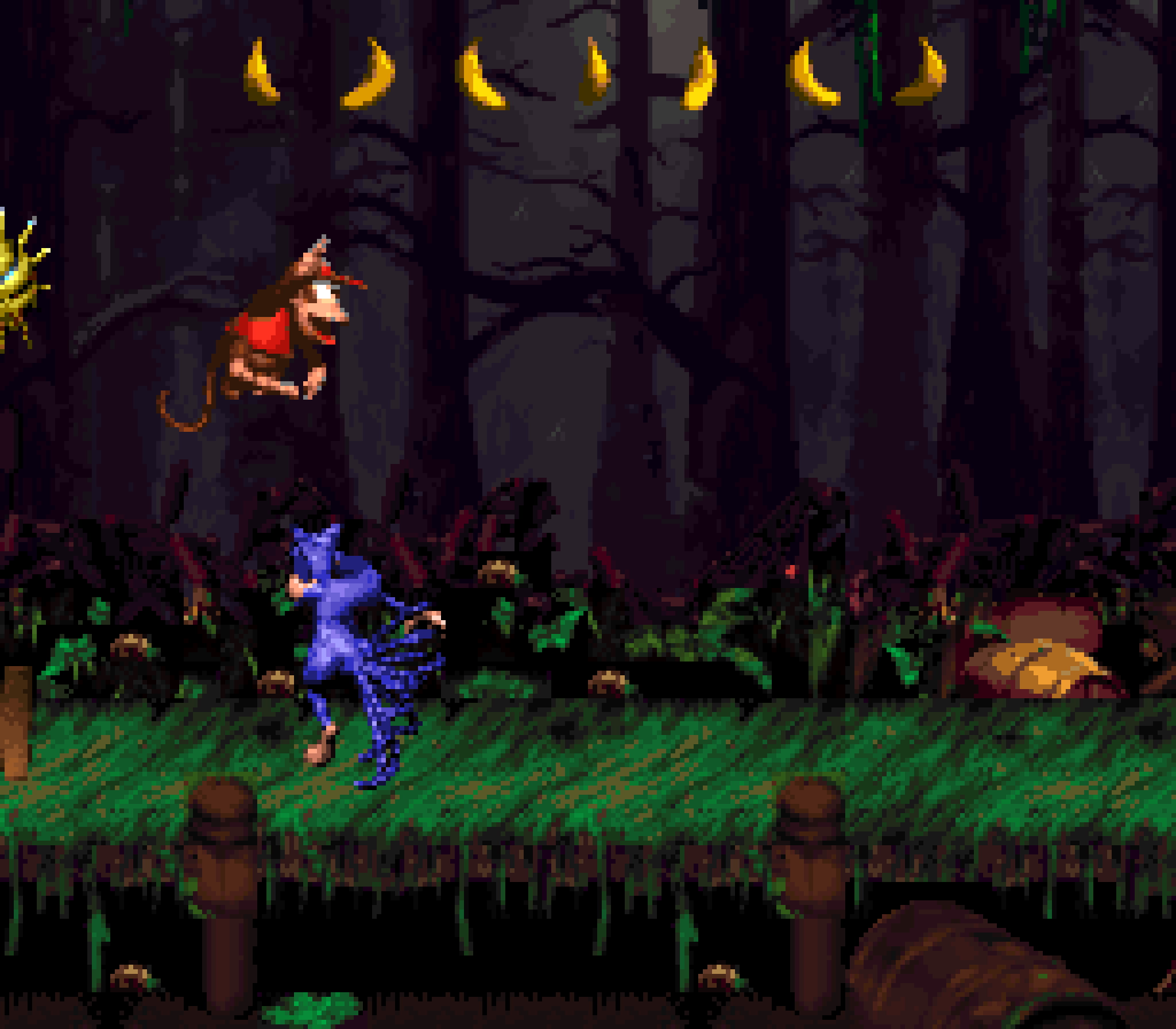
Much mo’ impressive is the use o’ the barrel-shooting Kannons, sadly not till the latter half. There are 2 places where you have to time jumps on barrels to get o’er large gaps, 1st just timing gainst 1 barrel @ a time surrounded by tadpole platforms & Flitters, & later, going ’cross a wide gap bouncing barrel to barrel.
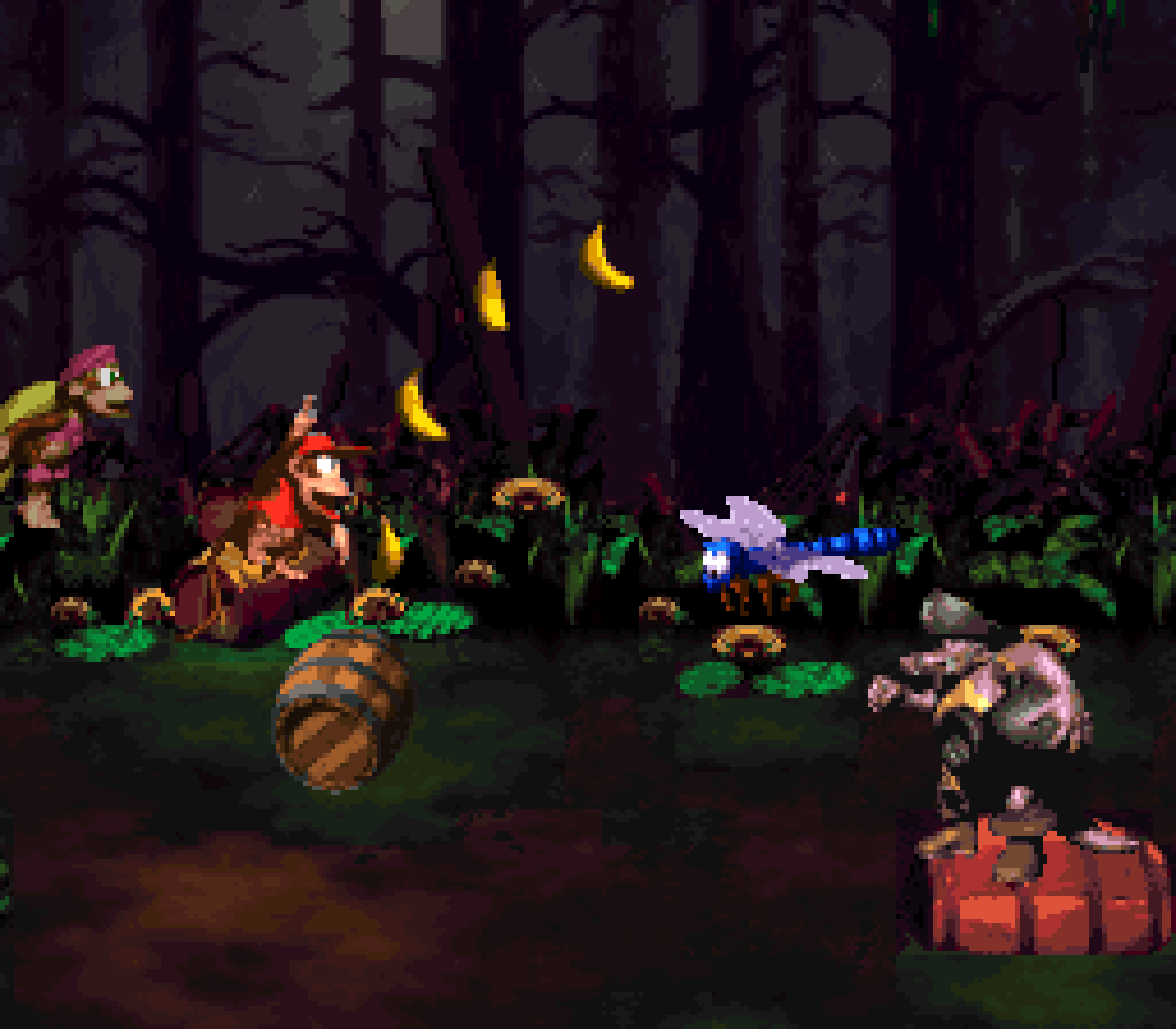
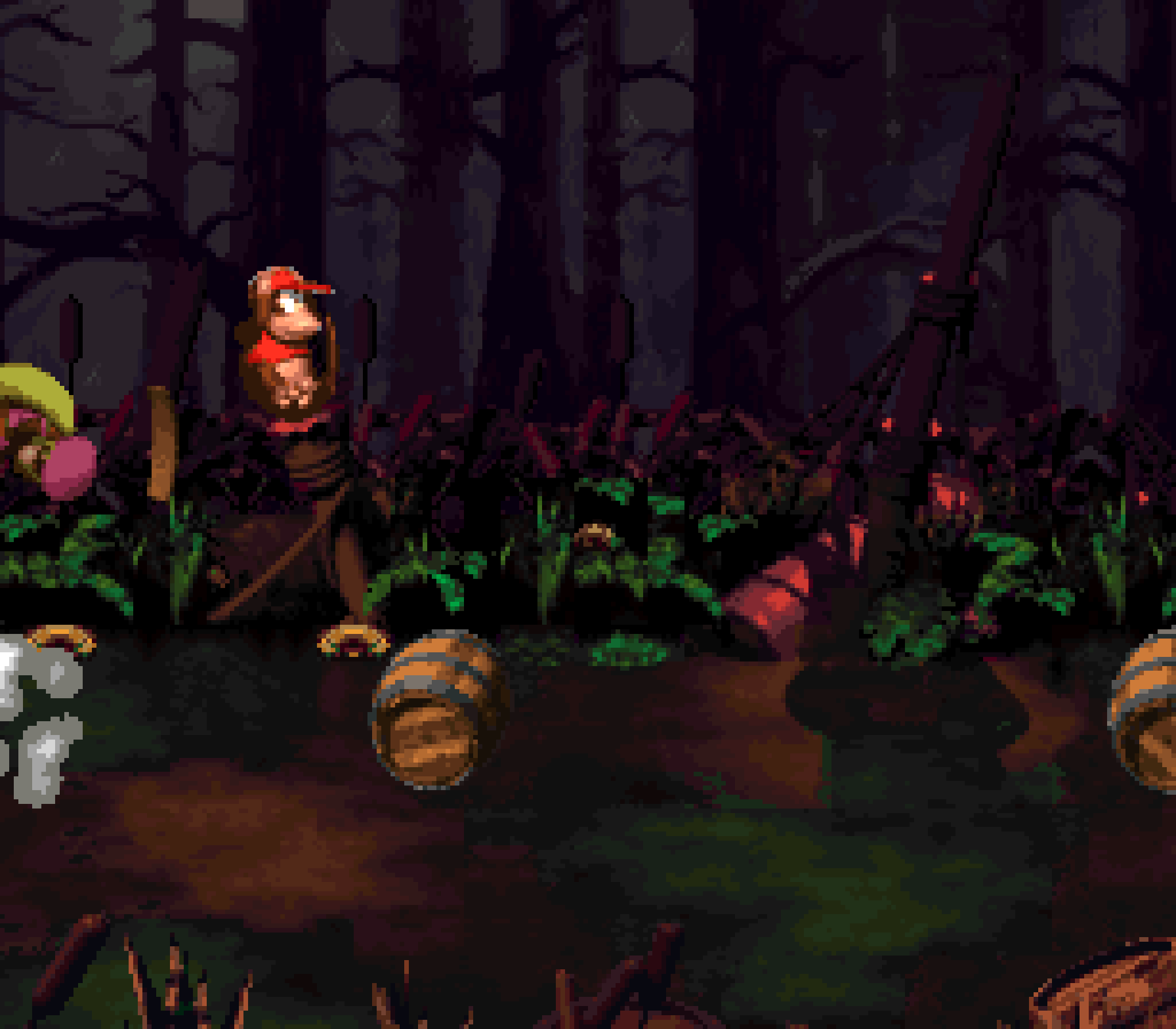
Granted, the part where you have to go from platform to platform while holding a cannon ball for the 2nd bonus while dodging the barrels being shot @ you — or just letting them hit you & get blocked by the cannon ball — is just slow padding, as there’s no challenge to it.
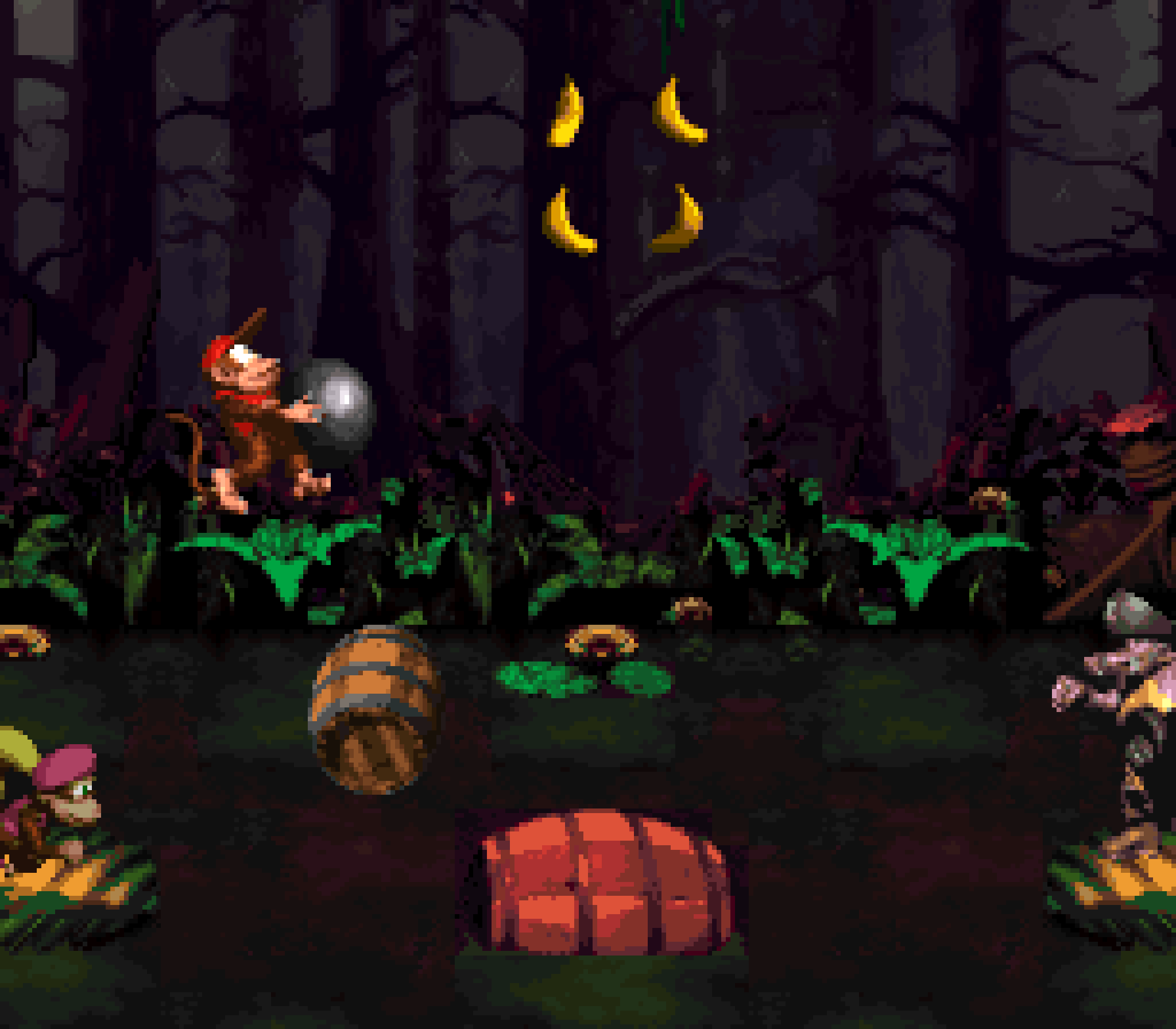
As for the bonuses, the 1st is all right, the 2nd is smelly. The 1st challenges you to get all the stars by throwing your partner up @ them — surprisingly a new concept for a bonus this late in the game. Since this bonus is gotten from the aforementioned Cat-o’-9-Tails bonus, it’s likely that e’en the level designers themselves intended for you to reach that bonus by throwing a Kong & not the useless Cat-o’-9-Tails.
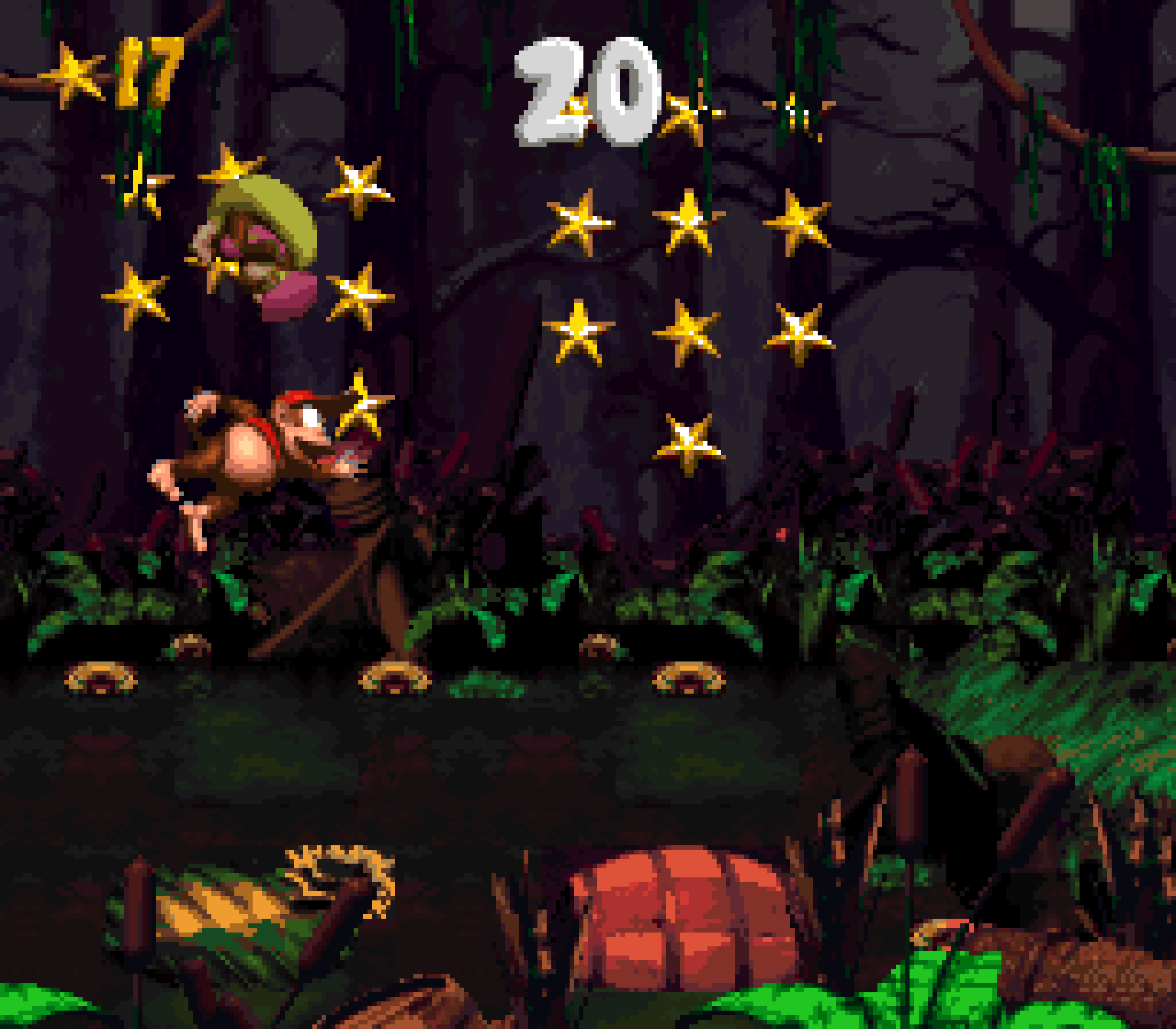
The 2nd bonus is just yet ’nother “throw cannon balls @ enemies”, & it’s e’en mo’ repetitive. The middle section is just a rehash o’ the 1st “Barrel Bayou” bonus minus a Zinger — or rather moved & cloned 2 times round platforms.

& then there’s the hero coin position. It’s odd that “Web Woods”’s hero coin is so infamous, when you consider that its same scheme is used here in this earlier level to a worse effect. Whereas “Web Woods”’s hero coin simply required timing your shot @ the target with precise timing so that you hit the hero coin the millisecond it’s onscreen, this 1 requires you to time an elaborate jump off a barrel being shot from offscreen & landing on the target when the hero coin shows up, which I feel is much harder. & since this is such a long, repetitive level, missing that hero coin & having to slog all the way thru this level is just that much mo’ painful. I guess I should praise the level designers for integrating the Kannons with the hero coin placement in such a clever way, but I think it would’ve been better to just have the hero coin up in a place where you can only reach it by bouncing on a barrel & save the end-goal hero coin for “Web Woods”.
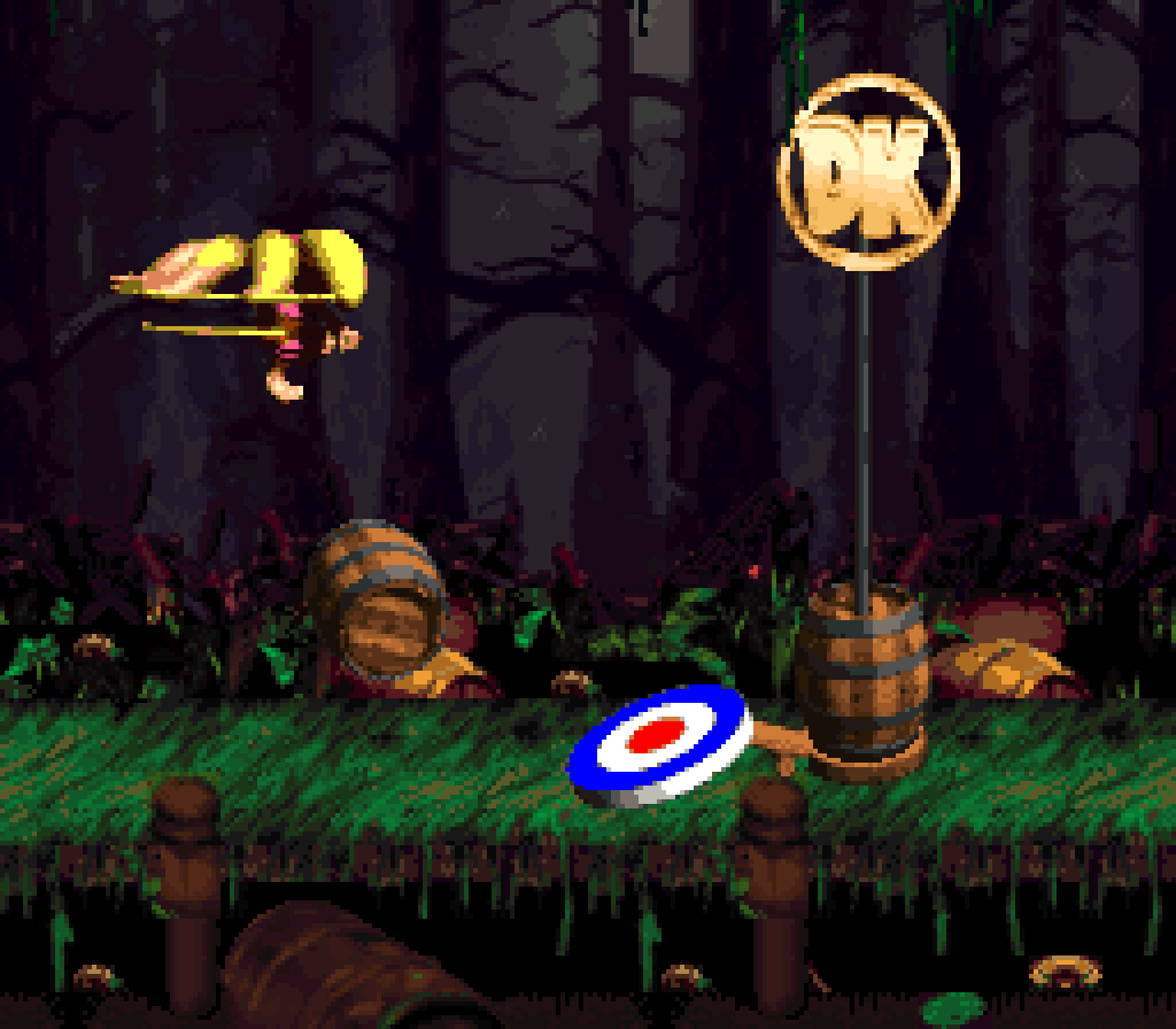
The feather is located to the left o’ a Kannon & below a Flitter, which makes you think you’re s’posed to use either o’ them to get it, but it seems you’re just s’posed to roll jump to get it after dispatching the Kannon. It’s 1 o’ the mo’ jarring placements. The photo, gotten by dispatching 1 o’ the many Mini-Neckies in this level, 1 that is particularly high up on a cattail, is annoying, but fits this level well & requires some quick thinking.
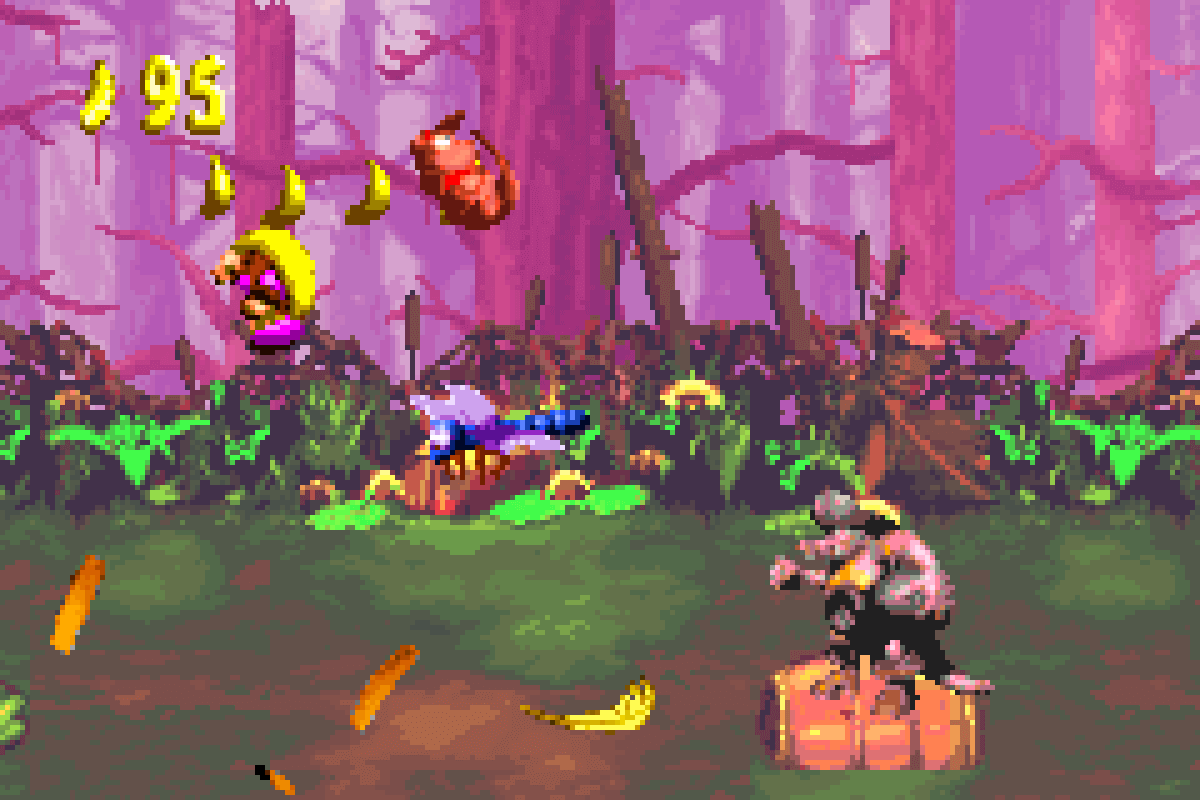
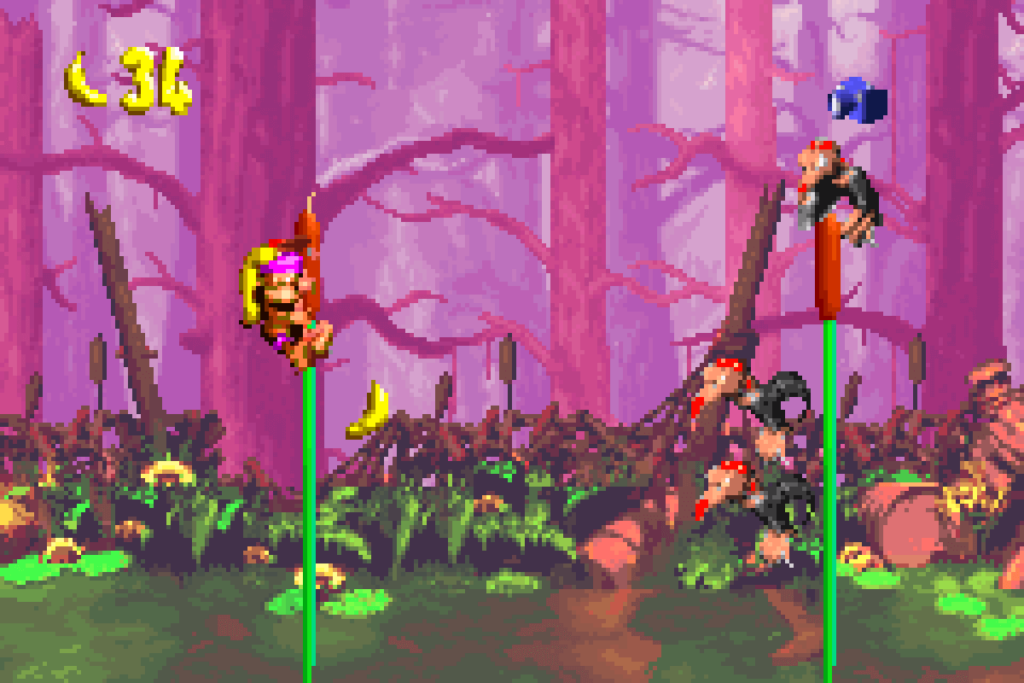
Aesthetically, the swamp levels are underrated. I love all the details they added to the background & foreground, specially the oil drums, which emphasize how polluted & wretched these swamps are. This level with its nighttime purple skies has the best palette ’mong the 3 swamp levels. The background music, “Bayou Boogie”, while arguably o’erly derivative o’ a certain Phil Collins song, is a great song only slept on ’cause it has the misfortune o’ being in a game full o’ excellent music. It fits the slower-paced, gloomier vibe o’ these levels perfectly.
My only complaint is that this level doesn’t feel like it fits in “Krazy Kremland” @ all. While I like that they spread levels o’ the same theme a bit to improve variety, I feel like this level would’ve fit better in, say, “Gloomy Gulch”, since this level has a gloomy background & a swamp wouldn’t fit too badly in a forest. Since ”Krazy Kremland” has 6 levels & “Gloomy Gulch” for some reason only has 5, it wouldn’t be any less fair if the former lost a level & the latter gained 1. Maybe they could’ve made ’nother rollercoaster level, since having “Haunted Hall” count as 1 o’ the 3 coaster level feels like cheating — specially since it doesn’t have the “Disco Train” song — & it does feel weird that the amusement-park-themed world only has 2 amusement-park levels.
28. Jungle Jinx
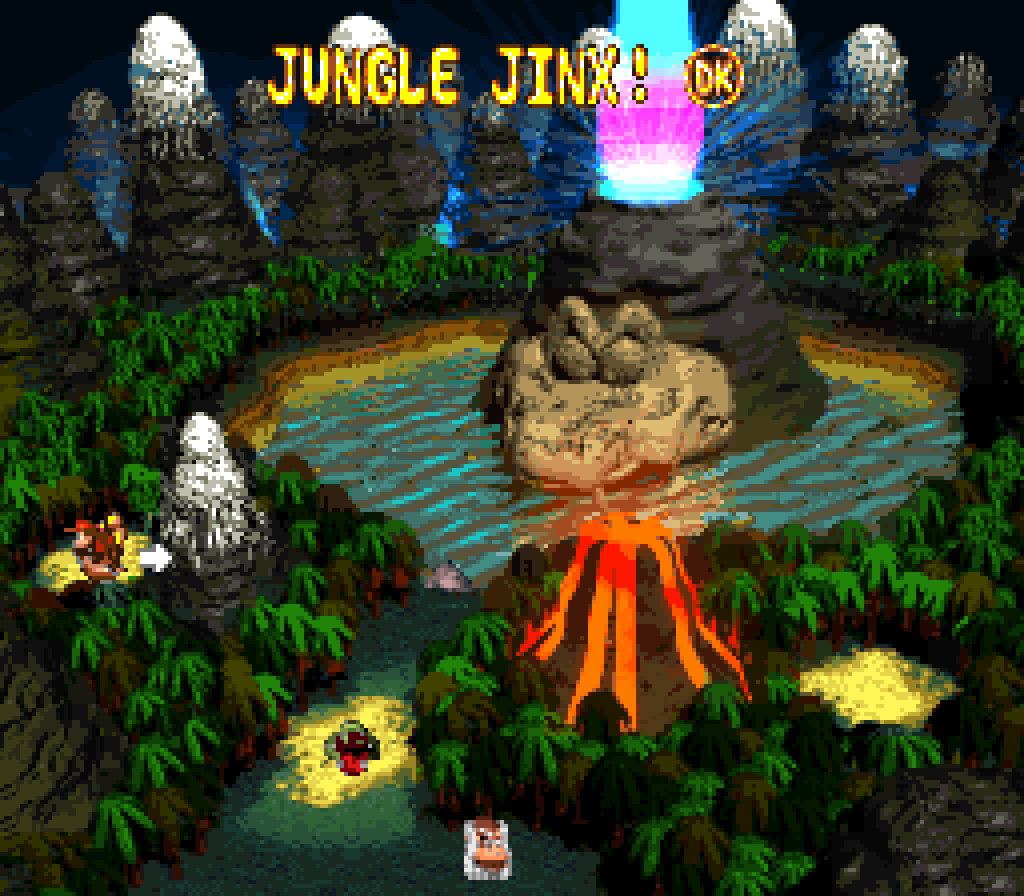
I don’t know if it’s clever or a mistake to make the 1st level o’ the bonus world so… normal. If “Slipslide Ride” was the most DKC2 level in DKC1, this is the most DKC1 o’ DKC2 levels with its hyperrealistic industrial tires bouncing back & forth with eerily deep & quiet bounce noises e’ery time the tire bounces off walls or floors. But the gameplay itself is very simple: time jumps onto the tires to bounce off them & don’t let yourself get squished into a wall by 1.

The way this level is laid out is perfectly competent, with standard difficulty elevation as the level goes on, — 1st dealing with tires o’er safe ground as a fallback & then later o’er spikes with pits strewn ’tween them — & breaking up the main gimmick with straight paths with regular enemies. There are a few semi-interesting setpieces, like having to weave under a wall o’ Zingers & round a tire bouncing back & forth when its on the leftmost end, with the alternate way round being to aim a bounce off the tire ’tween the upper & lower Zingers that make up the wall. The 1 interesting use o’ regular enemies is having to time a bounce off a Flitter who flies back & forth o’er spikes. But there’s not much else to talk ’bout, other than that the lack o’ excitement in this level is balanced by its shortness. This level is notably much, much easier than the other bonus levels. Players who go after bonuses as soon as they can won’t feel any extra heat playing this after “Hot-Head Hop”, but will be surprised when they try the same for later worlds’ bonus levels, where the difficulty leaps.
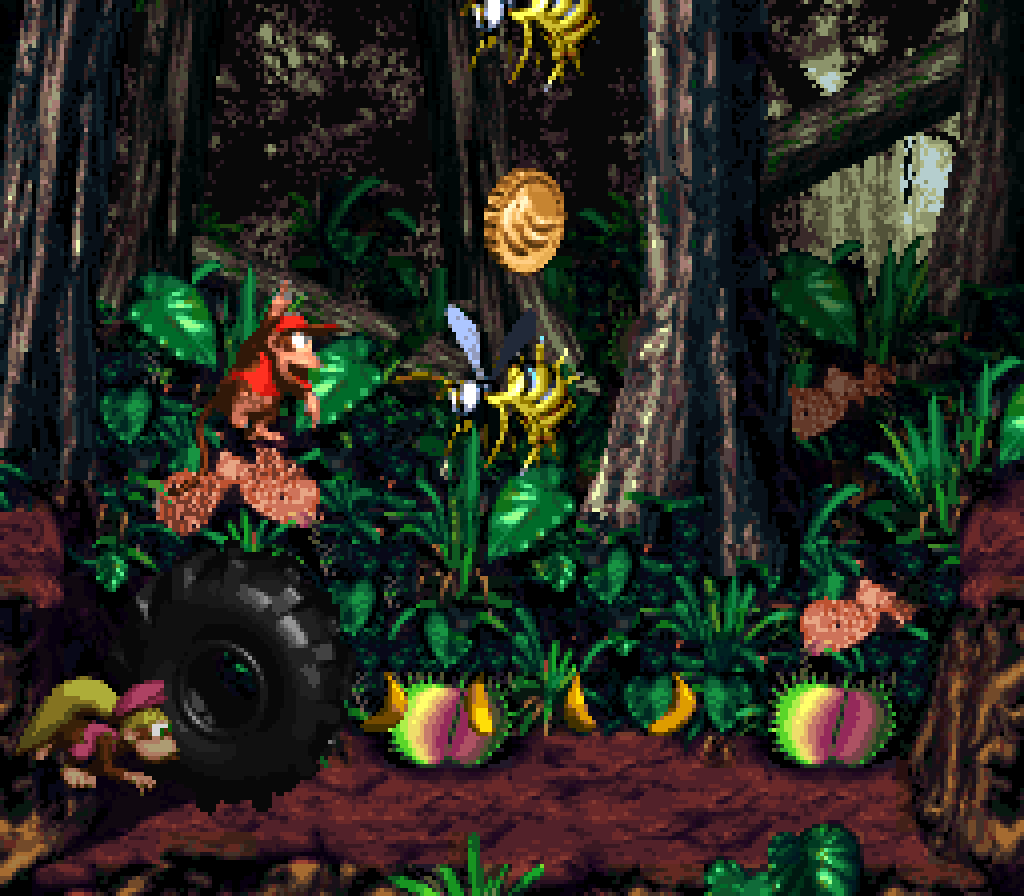
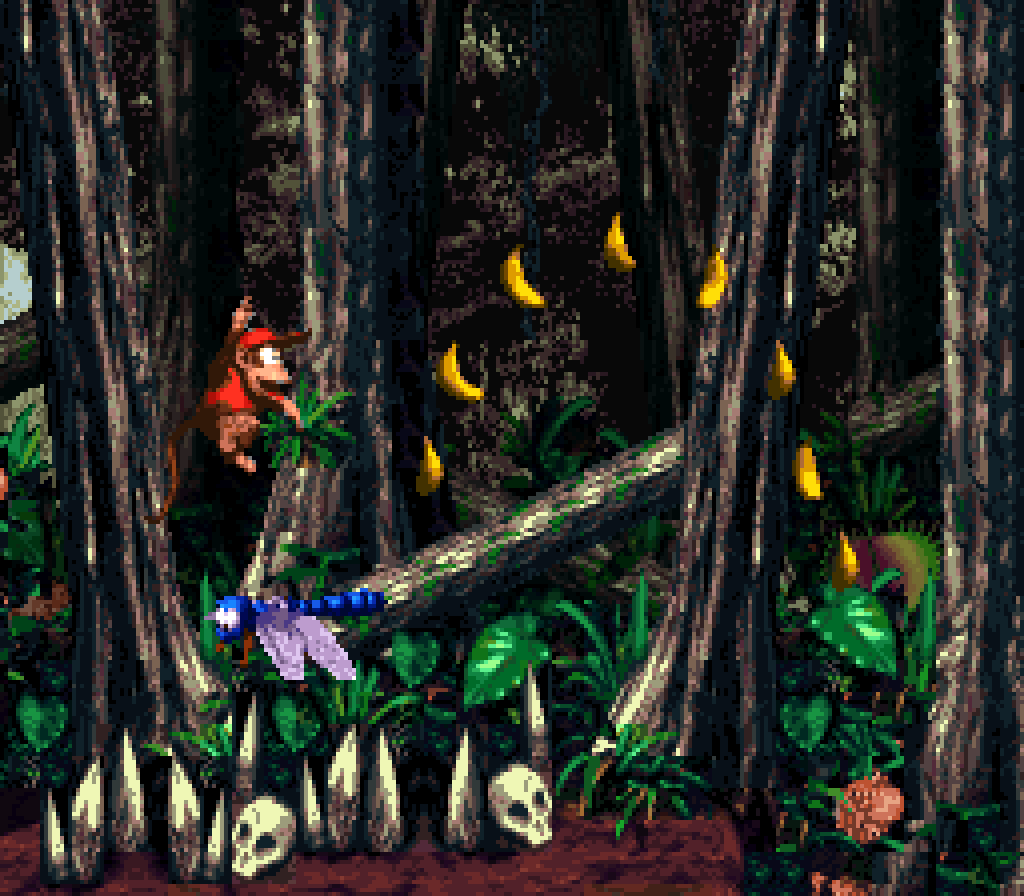
The hero-coin bonus is, similarly, competent, but not spectacular: just before the aforementioned spikepit with the Flitter, there’s a small space where you can drop down a cliff & go left to find the bonus barrel. It’s pretty well hidden, but doesn’t particularly mesh with this level’s gimmick, which is understandable, since moving bouncy tires isn’t big ’nough o’ a gimmick to warrant too much focus. That said, I’m e’en less impressed by putting the O here, as well. The bonus itself requires you to use your team up move & throw a Kong up @ the Flitters, which is not a new idea, but is much harder here than in other places, as you have to time it round Zingers quickly moving round the Flitters. It’s OK.
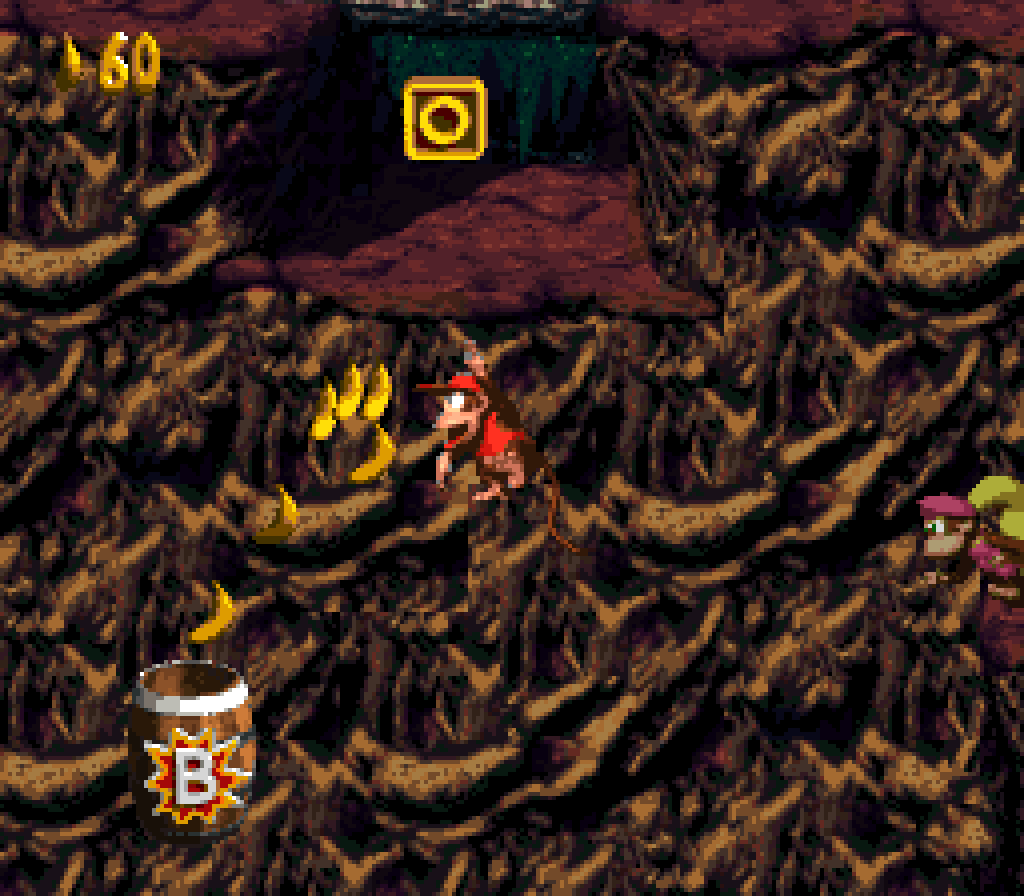

The photo contrives to add in a Dixie-only barrel that wasn’t there before so they have the ’scuse to add in a Dixie photo — I guess ’cause this is the 1st bonus level, & therefore special. There’s no other reason to choose this particular level, since there’s nothing ’bout it that particularly makes me think o’ Dixie.
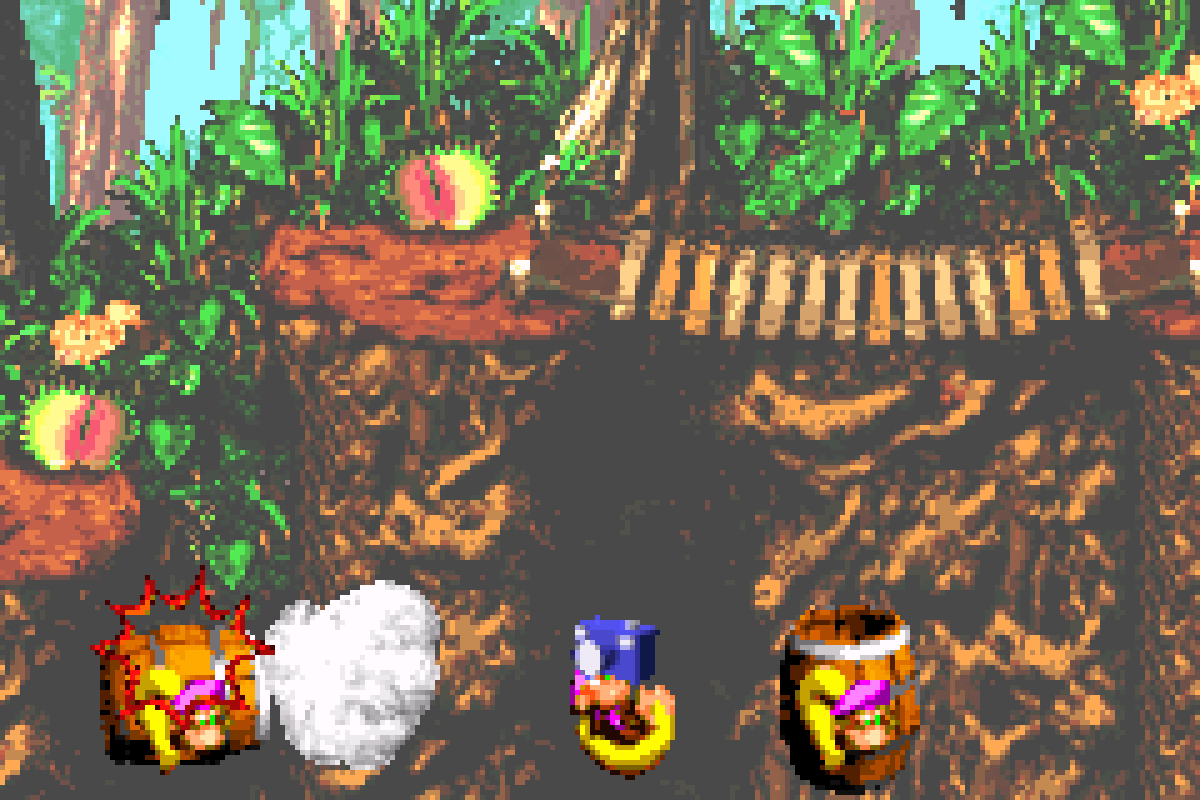
The feather, howe’er, is lame: it’s just in a pit somewhere. I think you can maybe bounce off a tire that’s just ’bove to fall offscreen, but I’ve ne’er been able to do it, since you get so li’l time to time it before the tire despawns but after the tire’s low ’nough to be below the feather. There were probably much mo’ interesting places to put this, like ’tween Zingers requiring a bounce on a tire to reach it.
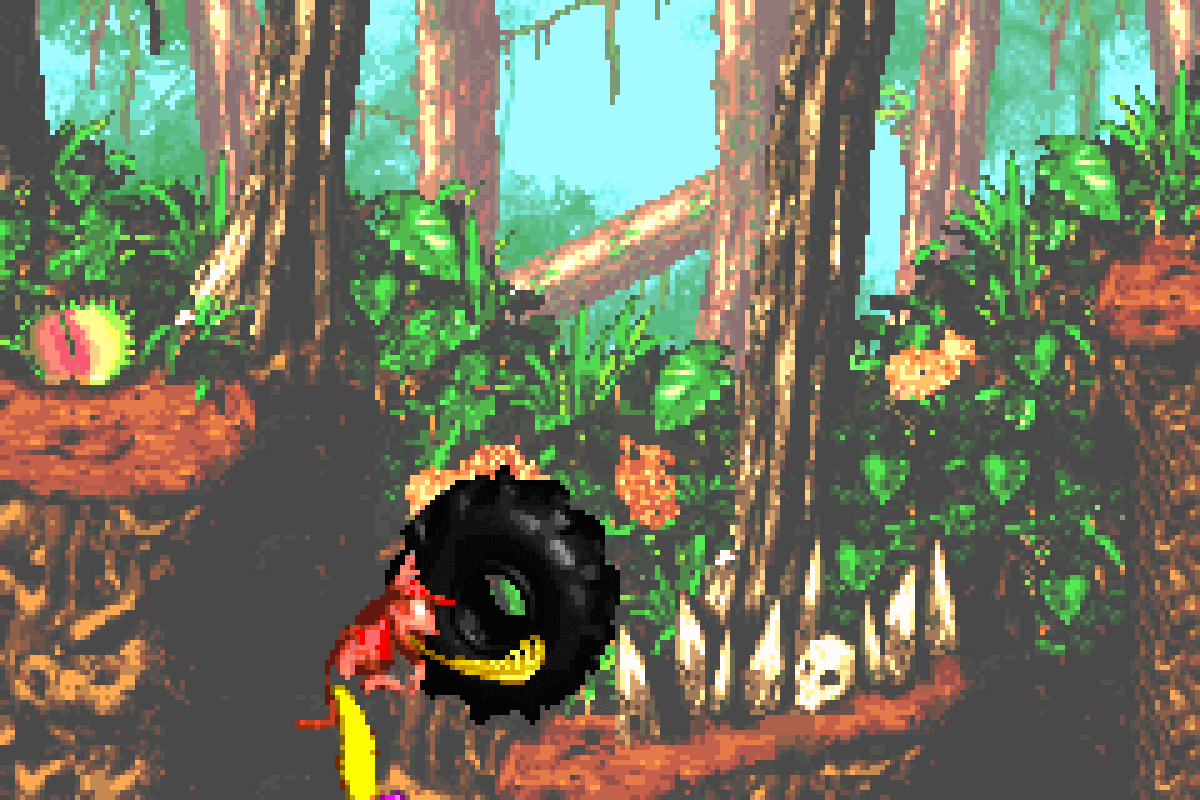
As you can tell, this level didn’t inspire me much, but it also wasn’t too bad or annoying, & like I said, it is short, so it feels mo’ like a mild romp than a drag.
The decision to have most o’ the bonus levels be jungle levels ( tho “Animal Antics”, the 3rd “jungle level”, if we assume the 3-levels-per-theme is in play, is only half jungle & half other themes ) is an interesting 1, considering how integral jungle levels are to the series, being the 1st theme o’ the 1st game. Being a rare theme isn’t too off, either, since the 1st game, weirdly ’nough, had only 4 jungle levels & had way mo’ cave & mine levels. That said, I find this 1 o’ the less-interesting themes, not the least ’cause this theme doesn’t look all that much mo’ like a jungle than a forest & lacks the mo’ specific, iconic elements o’ the 1st game’s jungle levels, like the palm trees. I guess there is something different ’bout the cold, autumnal or e’en wintery gray cast, & I do like the skull-strewn wooden spikes. I also like the templelike arcs @ the beginning in end, but wish they implemented mo’ temple elements, since what is here is easy to miss. While the music is OK, it admittedly has hard competition from the iconic “DK Island Swing” from the 1st game, or e’en “Jungle Jitters” from both the SNES & GBA versions o’ DKC3. While those songs subvert expectations with their jazz elements, “Primal Rave” sounds like typical jungle music, with cliché monkey noises.
27. Animal Antics
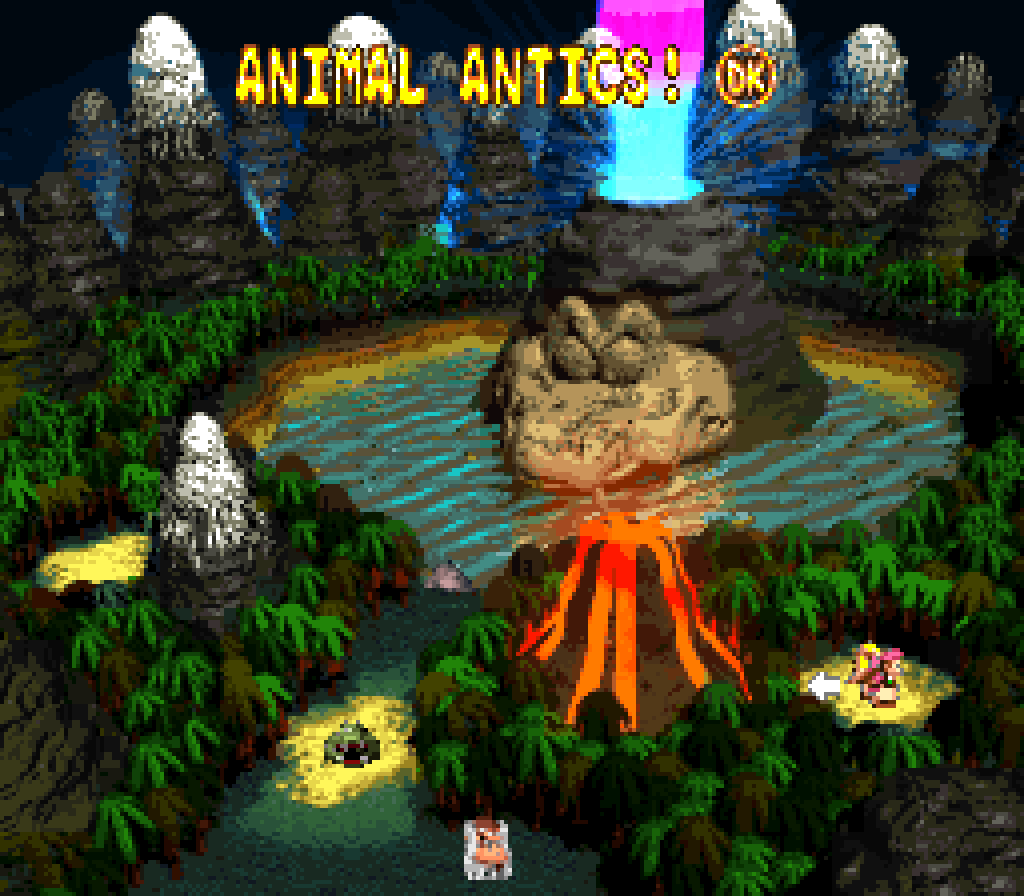
Let me start by saying that this level is not this low ’cause o’ the infamous Squawks wind section. In fact, that’s the highlight o’ this level & this level would’ve been better if ’twere just an expanded version o’ the Squawks wind section, with perhaps some other mechanics weaved in for variety. It maybe could’ve e’en kept the gimmick o’ having you play as all the animal buddies while keeping the wind gimmick consistent ( maybe have Enguarde play thru currents ). Granted, you already had to play thru a windy level with Rattly in “Gusty Glade”. It surprises me that this wind section is so hated: this wind section is the least bad iteration o’ 3 wind gimmicks this game has. I would take this section any day o’er “Gusty Glade”’s erratic changes without warning & whate’er nonsense “Windy Wells”’s wind is s’posed to be. The wind here alternates @ consistent intervals, allowing you to anticipate when it will change & adjust, making it feel less like janky arbitrariness & mo’ like a mechanic you can learn.
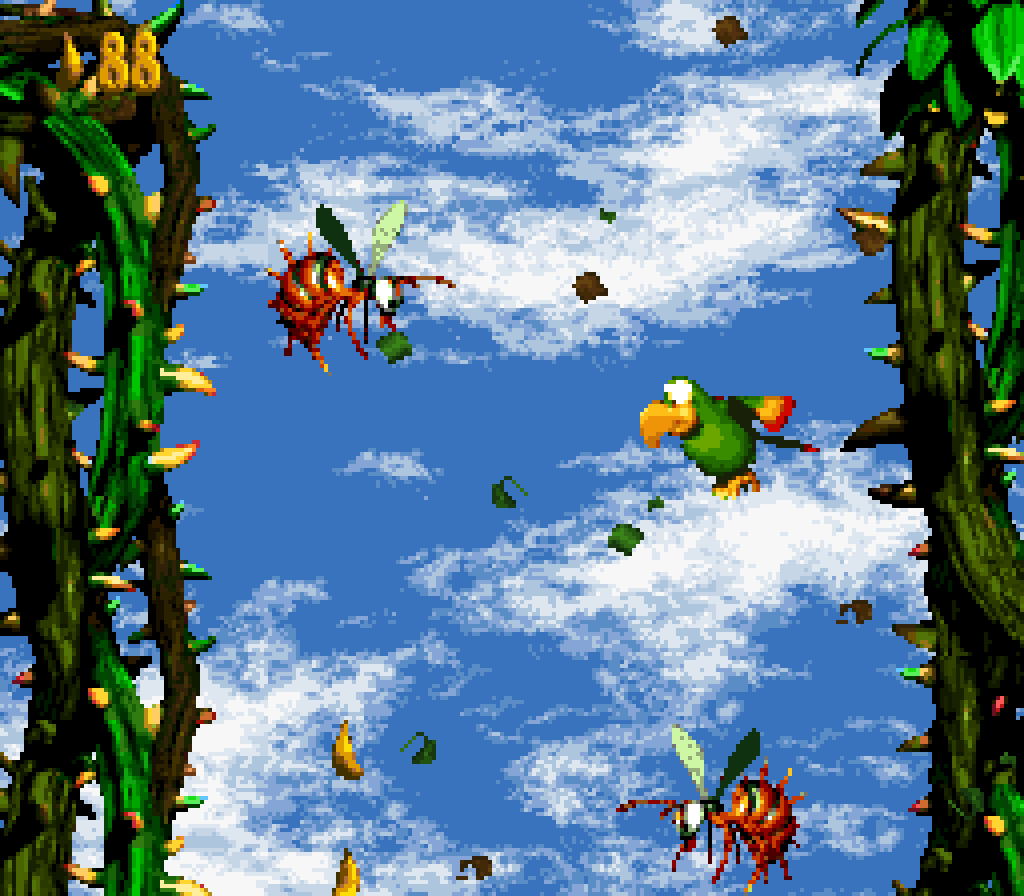
The various arrangements o’ Zingers & Flitters thruout this section, tho not all that complex by themselves, work to make an interesting challenge with the extra complexity o’ the wind, specially since while most o’ the area you want to go slowly & carefully so you don’t go back & forth too much in the wind, there are parts, like the Zingers going up & down near the beginning or going in circles @ the end, where you can just rush thru & avoid them if you know where you’re going ( ’course, you can rush thru the whole thing if you’re very good @ aiming & timing eggshots so that you dispatch Zingers just before you run into them ). I should add that I don’t e’en think this wind section, as infamous as it is, is anywhere close to the hardest part o’ this game. When I 1st played this level I beat it on my 3rd try, which is fewer tries than it took to beat “Klobber Karnage” ( &, believe it or not, fewer tries than it took to beat the Rattly section in this level ).
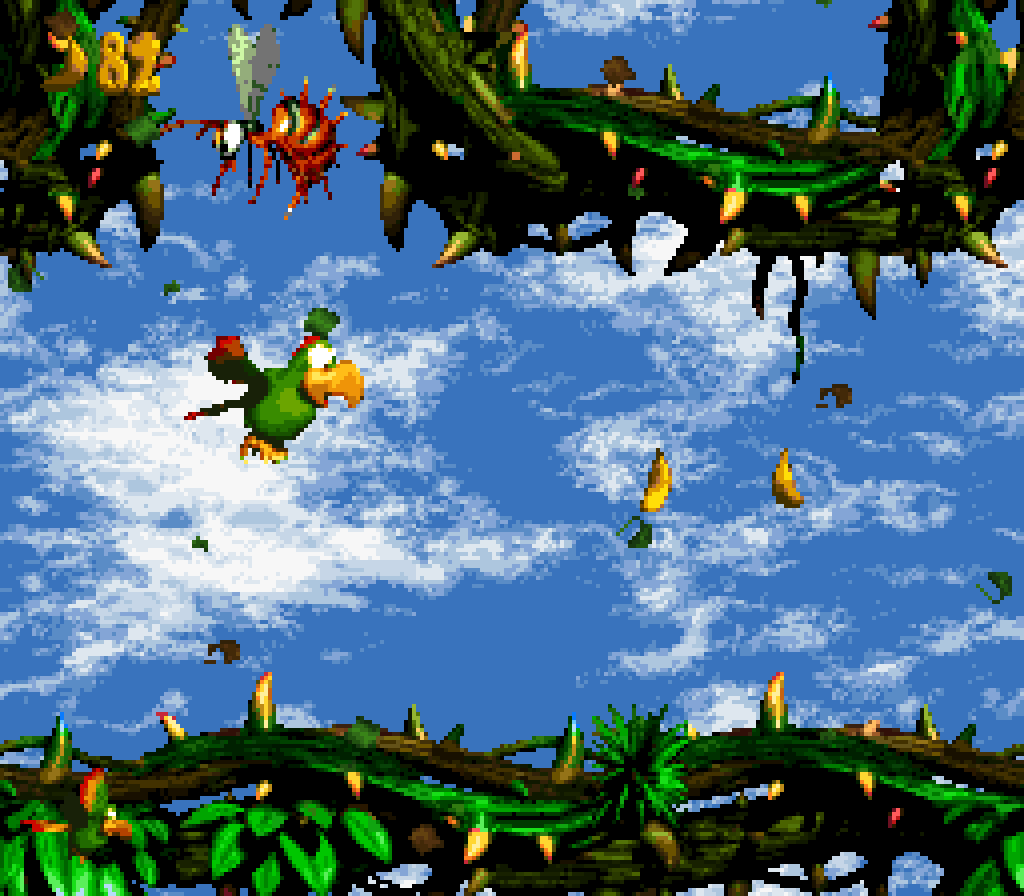

I’m also not going to complain ’bout the Rattly section just after it, other than that it’s a bit too short. While nowhere near as good as “Rattle Battle” or e’en “Toxic Tower”’s Rattly section, the timed jumps off the moving red Zingers o’er the stakes is a fun challenge, as well as the charged jump you need to do @ the start & aim without getting hit by the Klampon guarding the high-up platform.
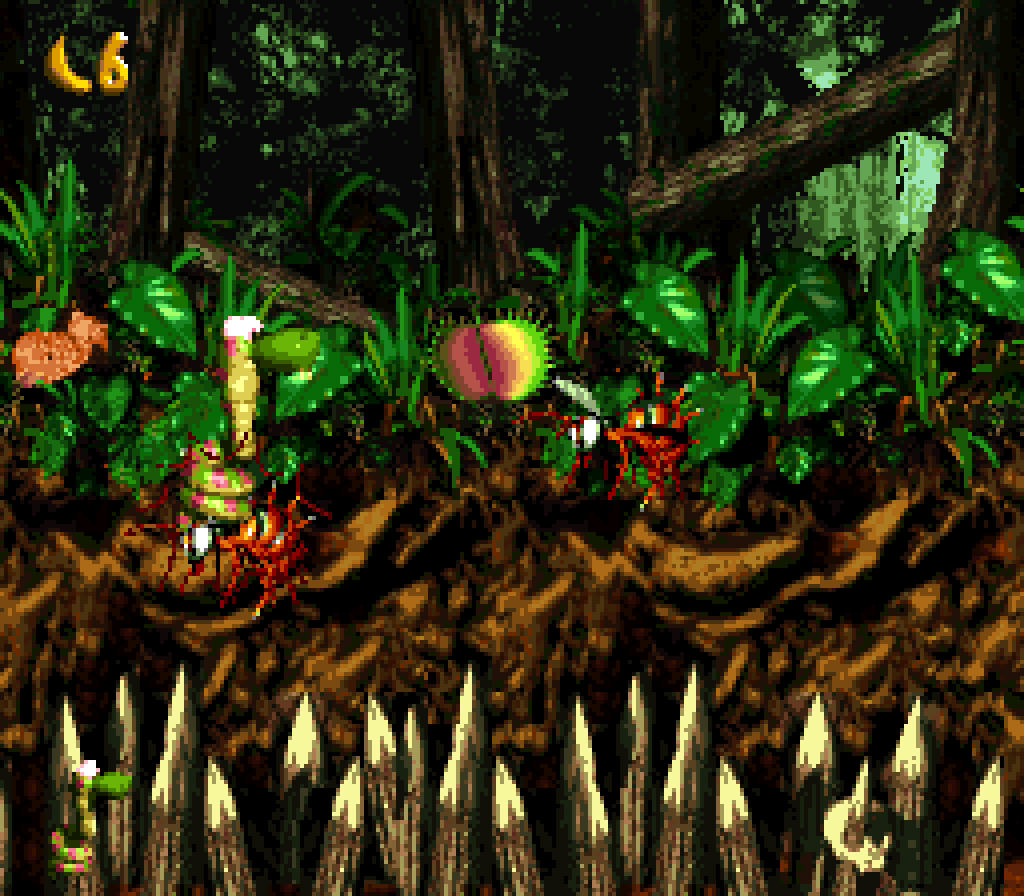
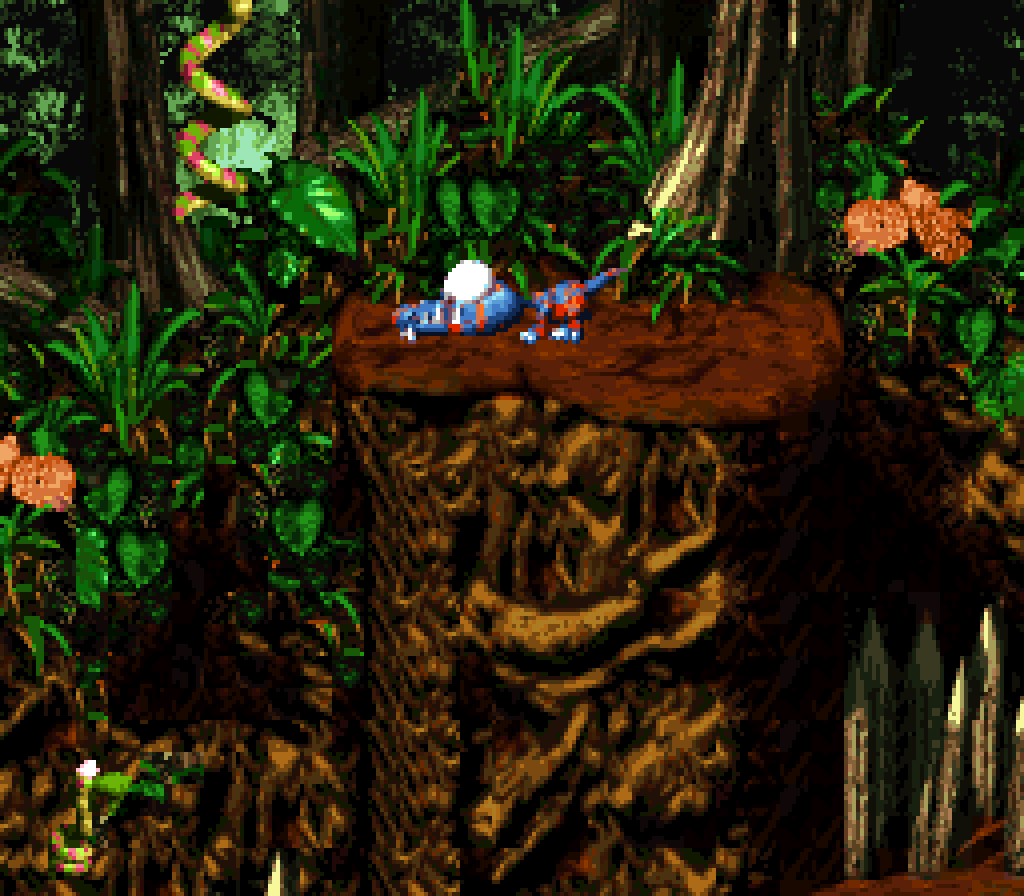
No, I’m going to complain ’bout the parts that most people don’t complain ’bout, the other sections, not ’cause they’re too hard, — they’re trivial, in fact, which works for an early-game level, but not for a bonus world level that’s ironically s’posed to be infamously hard — but ’cause they don’t have anything new to offer. For example, Rambi’s section for the most part is just a watered-down version o’ “Rambi Rumble”, which is weird, since that was a world 4 level, & wasn’t e’en a hard level for world 4, to boot. There is this interesting part in the 2nd icy room where you have to dodge Kannon’s cannonball shots as Rambi, which is a bit mo’ challenging with Rambi’s slower, less precise jumps, but it’s o’er before I e’en finished this sentence.


Meanwhile, Enguarde’s section is just the 4th time you rammed thru water enemies as Enguarde, leading me to ask why Rare used Enguarde so much when they clearly had the fewest ideas o’ what to use with him than with any other animal buddy. There is 1 section where they copy-pasted a bunch o’ Puftups, who are not the most common underwater enemy, & challenge you to dodge their spines, but they don’t e’en vary the projectory o’ their spines & they take a full second to explode, so you can easily telegraph their attacks, making it a slow waiting game, which has neither challenge nor the stress release o’ just plowing thru e’erything like the Rambi section a’least had.

& then there’s the Squitter section, which is so laughably easy you can just skip o’er everything by just sticking to the top o’ the screen, making it just a slow trip creating & jumping from platform to platform. Worse, in the original SNES version you have to redo this redundant slog e’ery time you die @ the Squawks or Rattly sections, which is probably the real reason those sections are notorious. The movement o’ this level’s midway point to just before the Squawks section is 1 o’ the few changes in the GBA version that fans unanimously agree is an improvement.
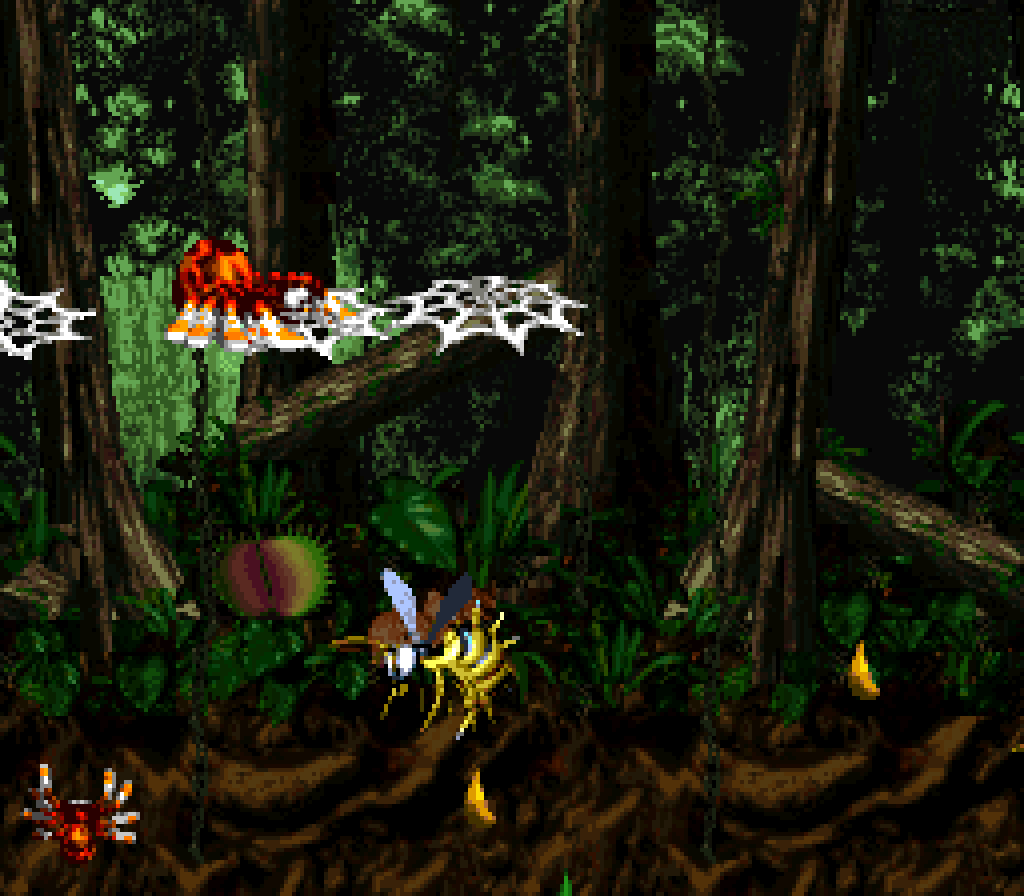
The hero-coin bonus isn’t all that great, either: you just go o’er the top o’ the right wall @ the end o’ the Squitter section, which has a bonus barrel on the other side. A’least it’s not move-thru ground. The bonus challenge itself is just killing Zingers with Squitter & Squawks. It’s cool that you have to use both, but having you defeat enemies in a bramble patch with either animal buddy isn’t all that fresh @ this point, & this bonus seems to have a particularly simple arrangement where you can just go straight up & just turn a bit left & right. “Bramble Scramble”, which is halfway thru the game, has a mo’ complex bonus where you have to both defeat Zingers & collect their stars, & they’re all o’er the place & in precarious niches. ¿Why is this postgame bonus level bonus so simple in comparison?
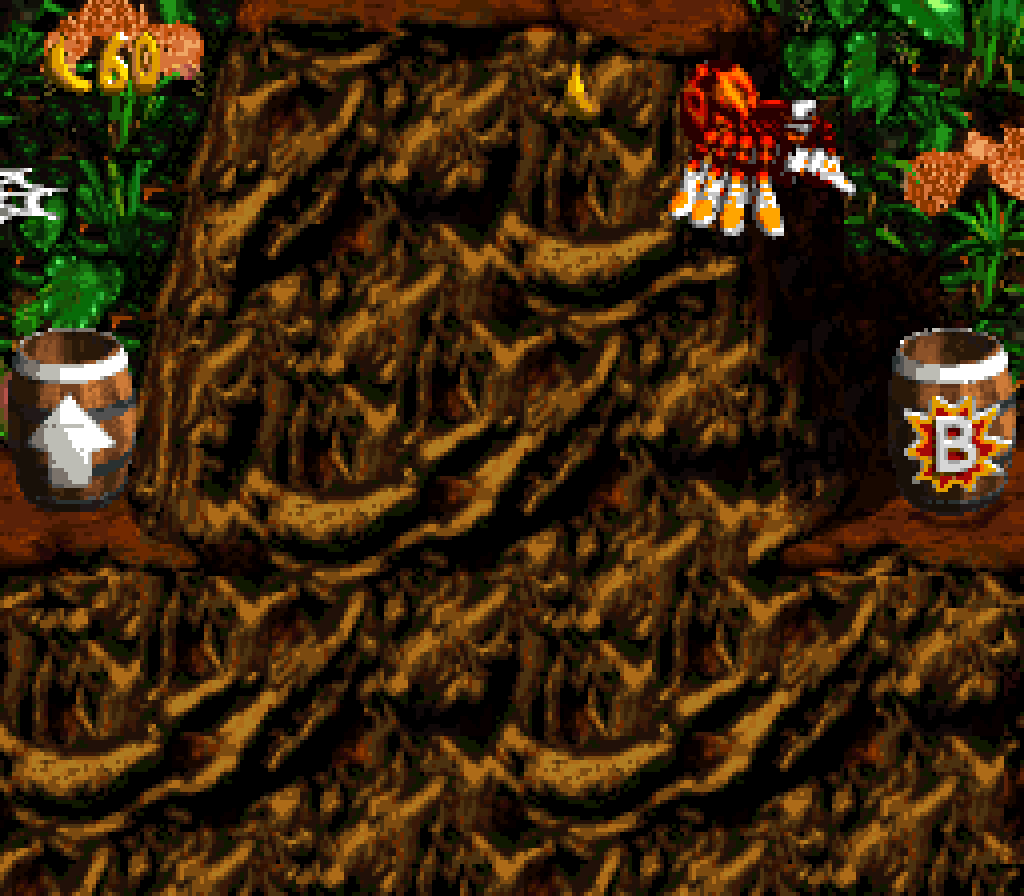
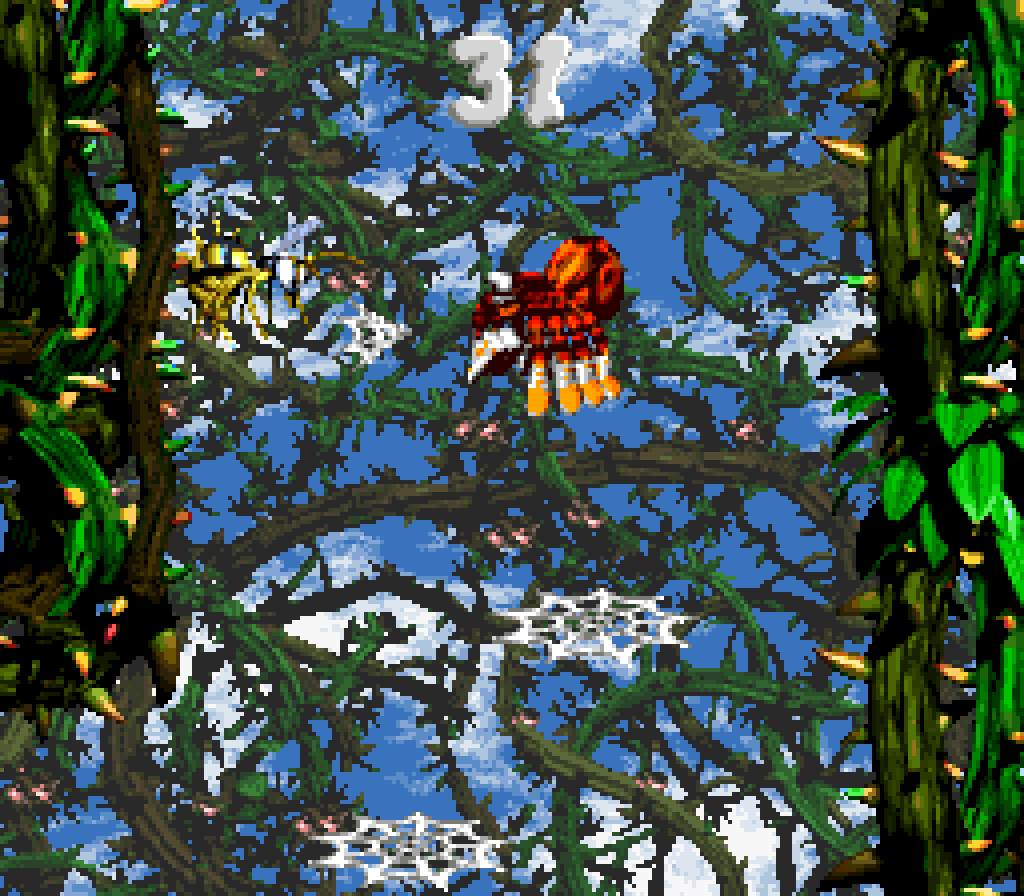
In contrast, the GBA collectibles are much mo’ inspired, taking advantage o’ this level’s many extraneous side areas to hide them. For instance, the photo, which fittingly gives you the photo for Squawks, who is most associated with this level, is in an otherwise useless niche guarded by Zingers, while the feather is to the left o’ the start o’ the Rattly section, which existed in the SNES version, but only offered a few banana coins for your trouble.
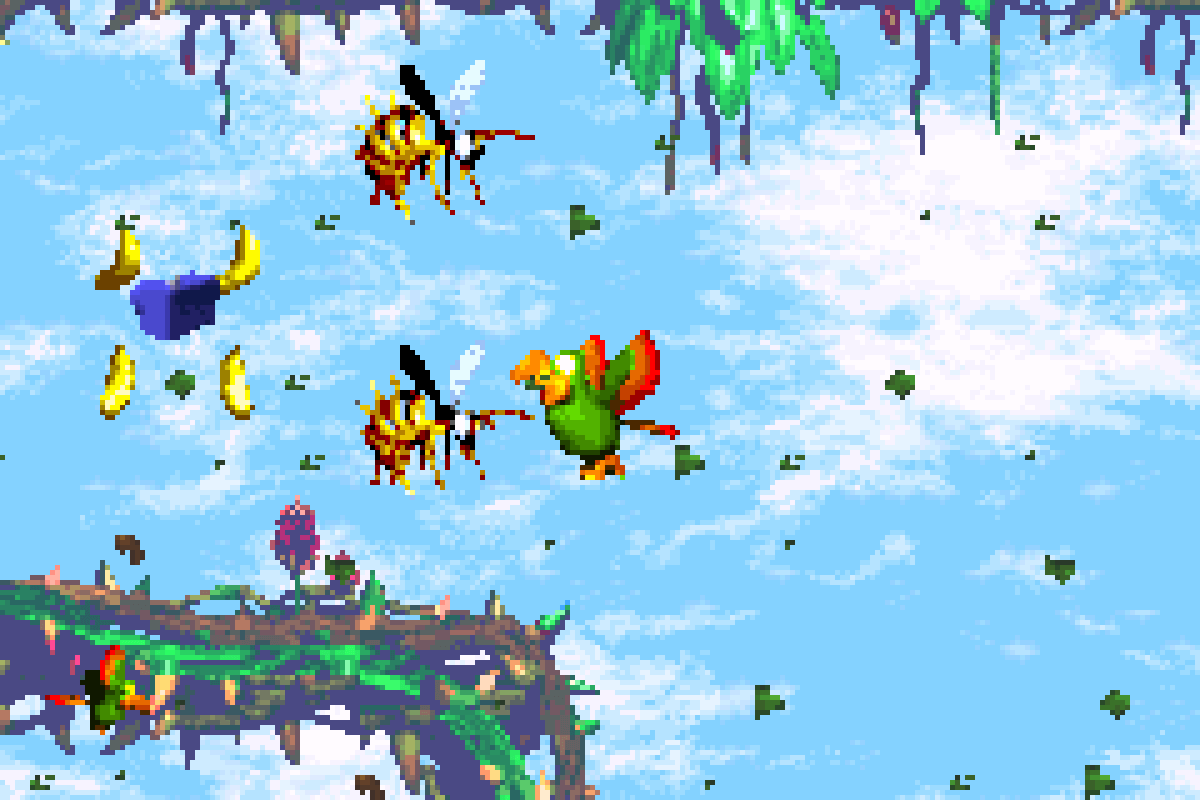
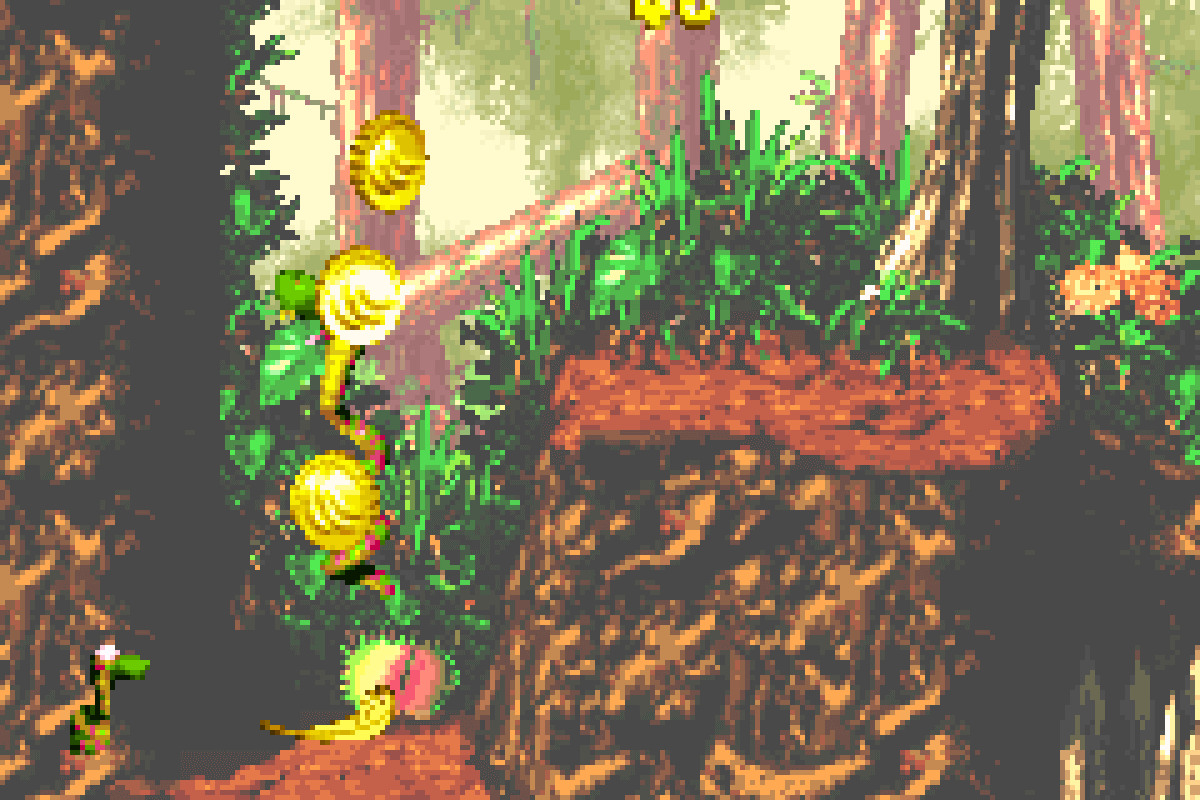
The main problem with this level is that after playing several levels that focus on each animal buddy individually & used them to their full extent for their whole levels or most o’ their levels, a level where you play as each animal buddy for small snippets that mostly feel like rejects from other levels feels very underwhelming, specially for the final bonus level, a level that should be special. Playing as e’ery animal buddy by itself isn’t a compelling ’nough “gimmick” to base an entire level round. I s’pose, to be fair, there is also the minor gimmick o’ having you go thru different level themes, but e’en that is done halfheartedly, since you don’t e’en go thru a 3rd o’ themes, choose the ice theme as 1 o’ the few other themes they choose, e’en tho it’s the least interesting theme in this game, & mostly go thru the jungle theme. Furthermo’, it kind o’ messes with the thematic #s o’ this game, where you technically have 3 levels for e’ery theme, but only if you count this level as a jungle level, e’en tho it’s not wholly a jungle level. It would’ve been better either to have this go thru all the level themes or just stick to the jungle theme; having you randomly enter an ice area & a bramble area feels arbitrary & jarring, but not in an interesting way.
26. Ghostly Grove

“Ghostly Grove” is a solid but unremarkable level, which may be a fitting way to start the 5th world, “Gloomy Gulch”, after all o’ the crazy levels in “Krazy Kremland”. Tho this level does have a unique gimmick, the ropes that disappear & reappear, it’s a very basic, straightforward gimmick, the gist o’ which can be found in many other games, such as the disappearing & reappearing clouds in Wario Land 3’s “Above the Clouds”. A’least they don’t involve barrels — tho DKC3 does have a ghostly barrel gimmick that, in terms o’ gameplay, is actually mo’ interesting. They do build up the difficulty o’ these ghost ropes a bit by making you waste time moving for a better vantage to aim round Zingers placed in the way, but only the penultimate series o’ ghost ropes does anything beyond just having you go to the top, having you go lower down @ the end & forcing you to make a jump under a Zinger. They also have a bunch o’ ropes that you have to jump ’cross in succession @ the end, which is a fitting climax, but not mindblowing. I feel like they could’ve done mo’ with this gimmick, like maybe adding Mini-Neckies, or a’least some Flitters.
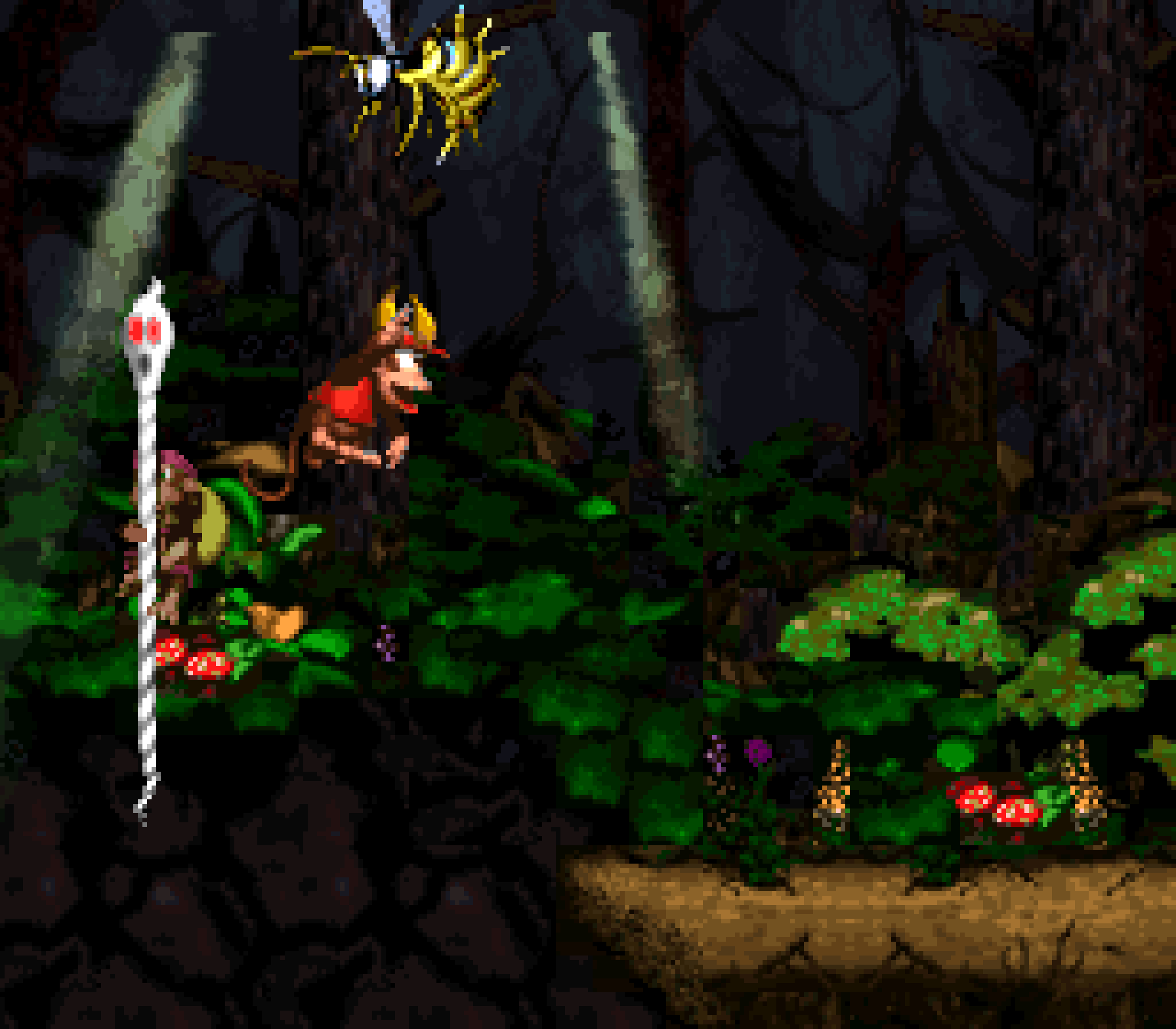
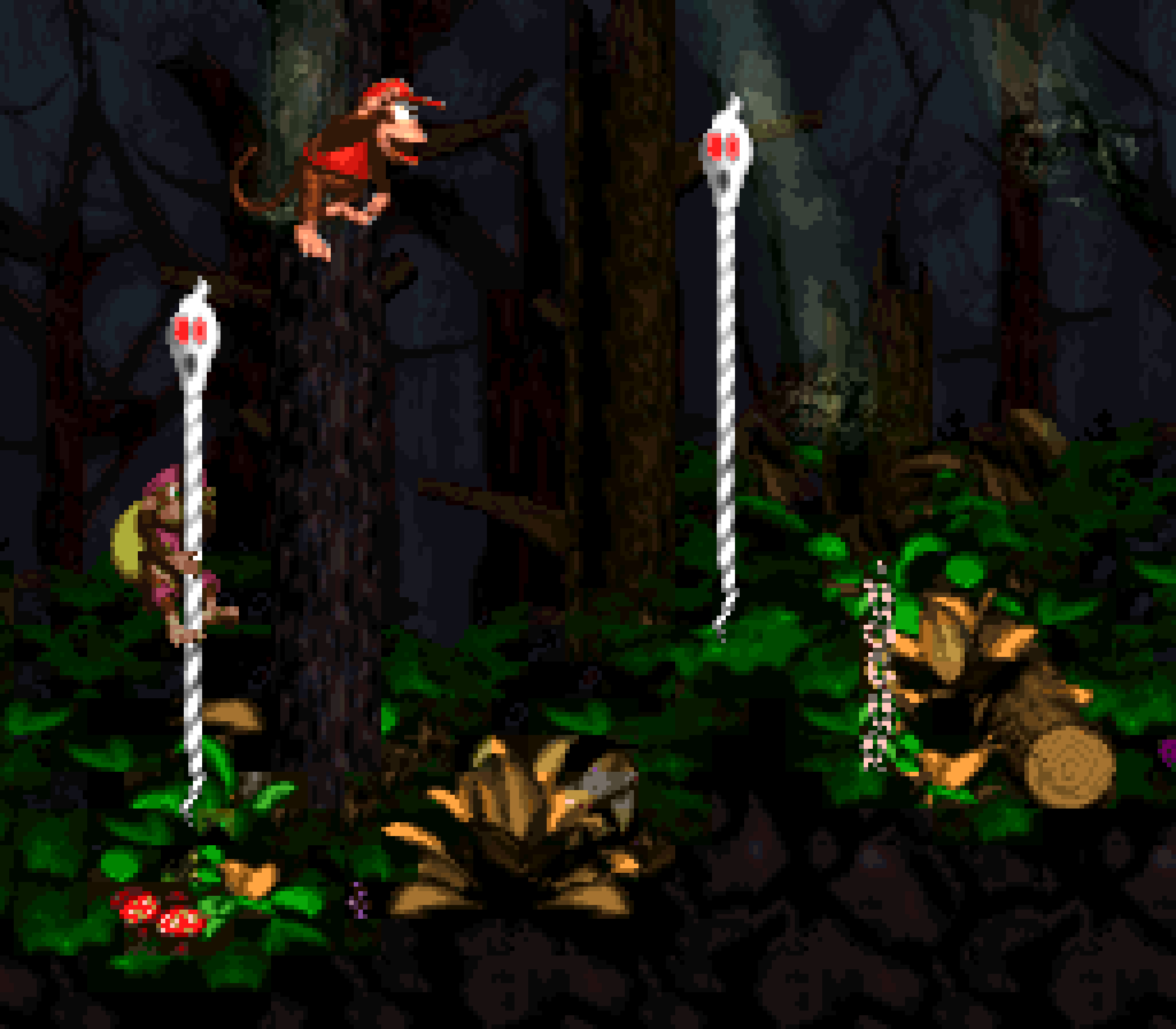
This level also oddly focuses on Klobbers & Kabooms, the latter o’ whom are introduced in this stage, but doesn’t do anything interesting with them beyond having 2 @ a time & the kinda cool way you can reveal the 1st bonus by rolling a Klobber’s barrel down steps guarded by Krunchas & breaking on the wall @ the end.
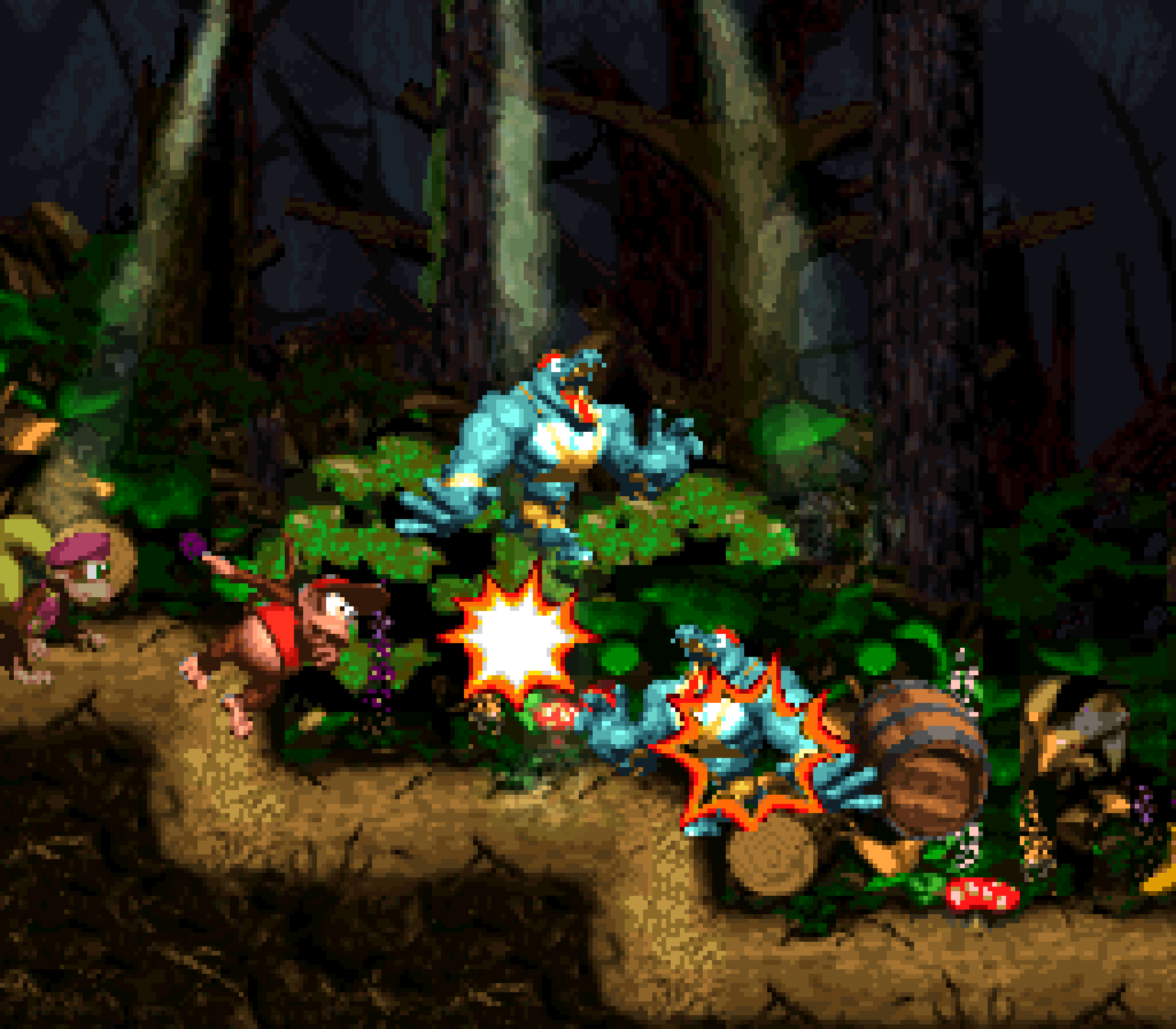
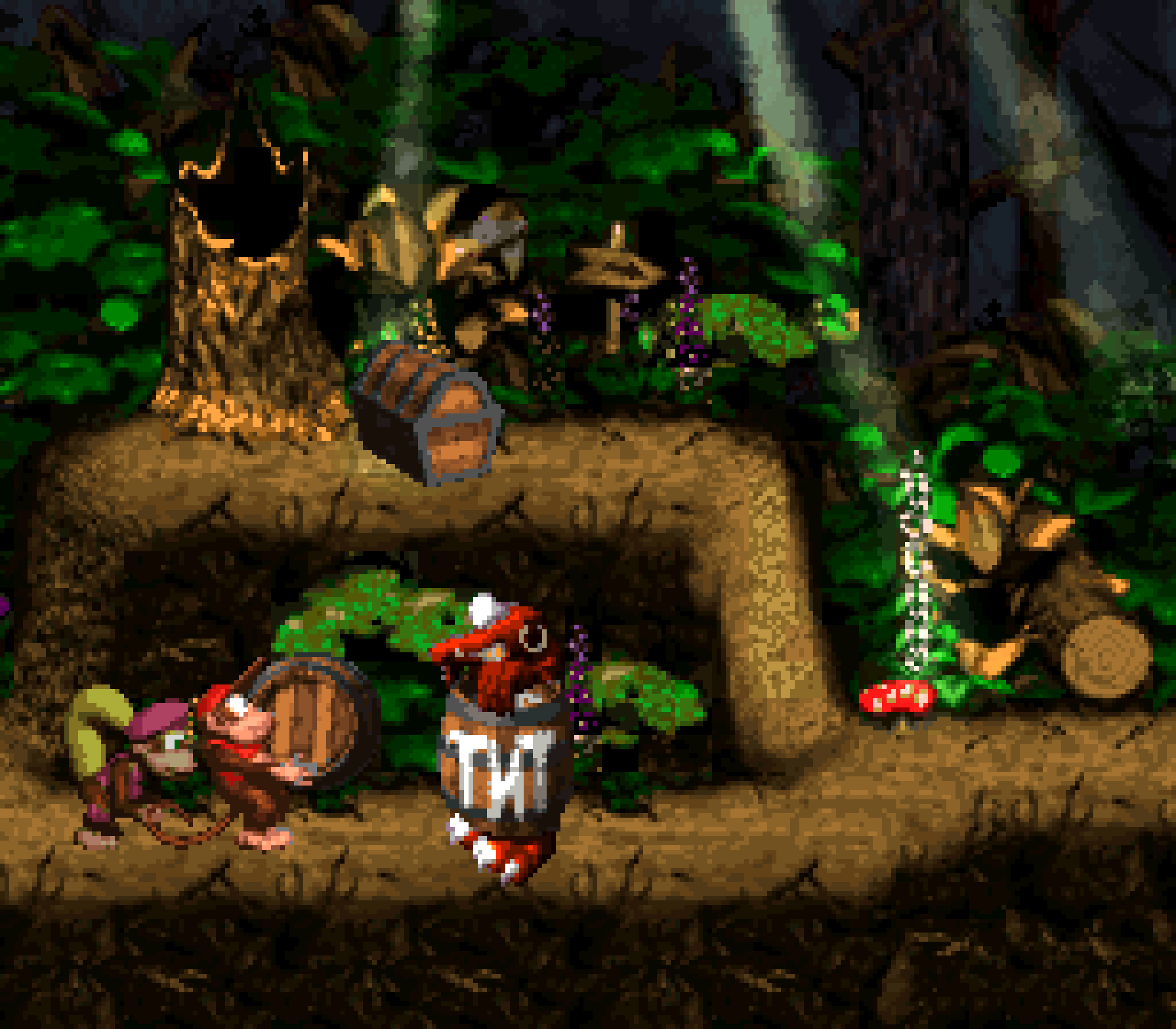
Unsurprisingly, the 2nd bonus is found by jumping up 2 ghost ropes before they disappear to reach it, ’cept these ropes disappear quickly, requiring tight timing, making these the hardest ropes to maneuver thru, which is fitting for bonus content.
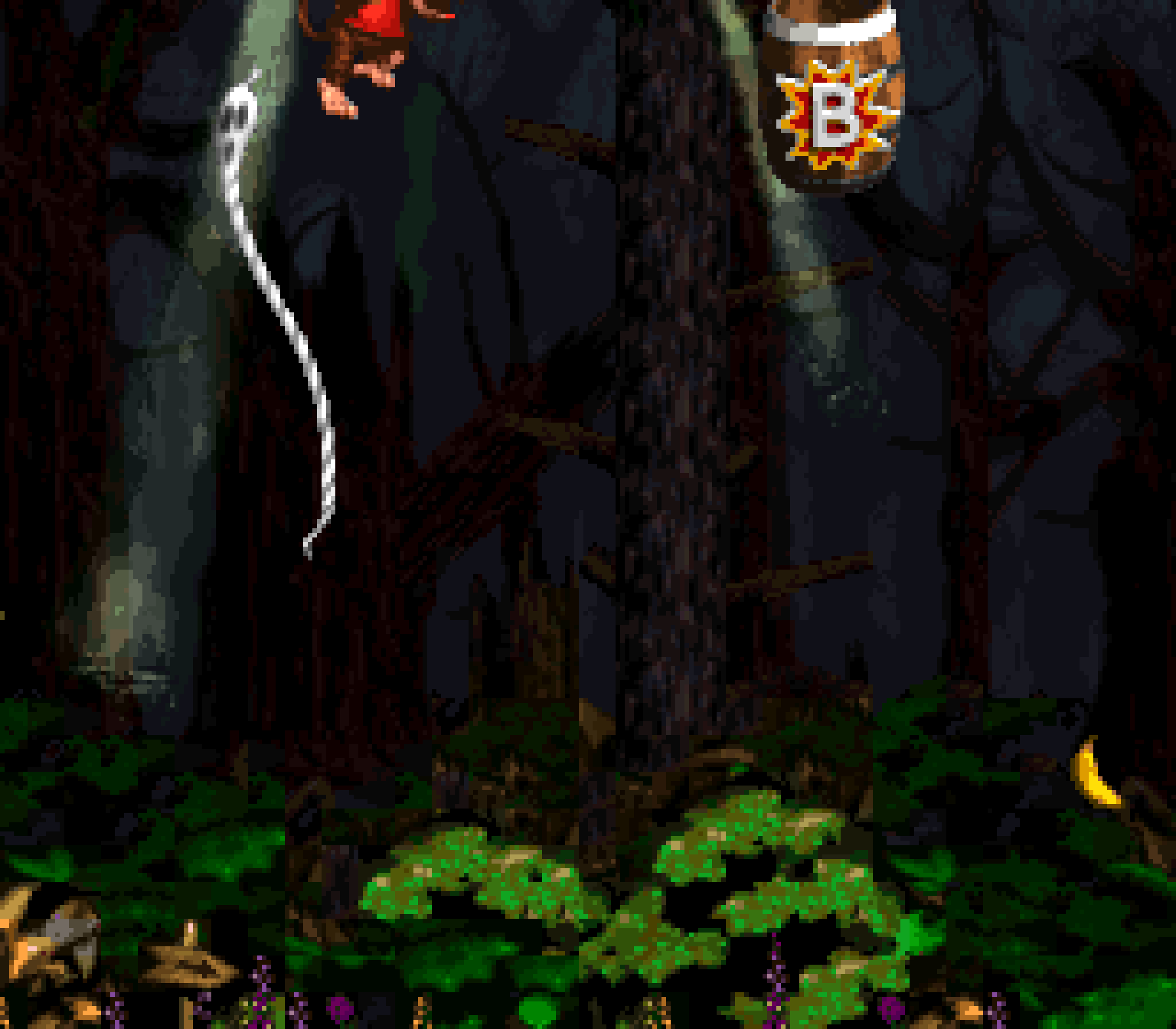
The bonuses themselves are lackluster, tho. The 2nd bonus itself is just jumping ’cross ghost ropes without any twists & is, like all too many bonuses in this game, much easier than getting to the bonus barrel itself.

Meanwhile, the 1st bonus is just throwing a chest up @ a moving red Zinger repeatedly, which we already saw in 2 swamp levels, “Gangplank Galley”, & probably many other levels I’m forgetting, & was ne’er fun or interesting or challenging in the 1st place, much less this many times.
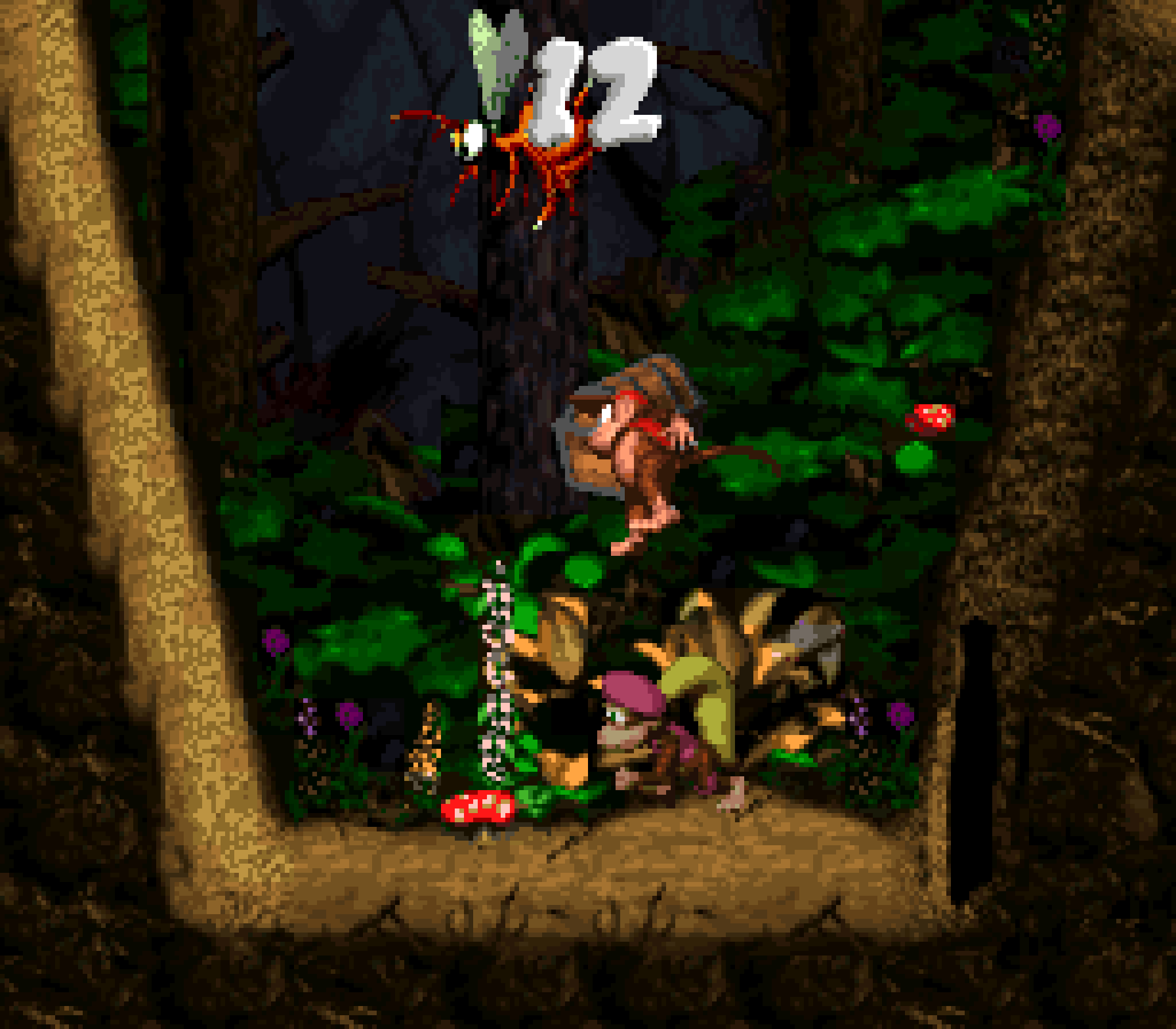
But the best proof that the level designers didn’t have many ideas o’ what to do with this level is the hero coin location: it’s under a seemingly random plot o’ land, accessible only by helicoptergliding with Dixie. You can see them poking up from the bottom o’ the screen, but I found this only happens if you go back, which you’d have li’l reason to do. Moreo’er, this location just feels tacked on — it could fit just as well in any other level.
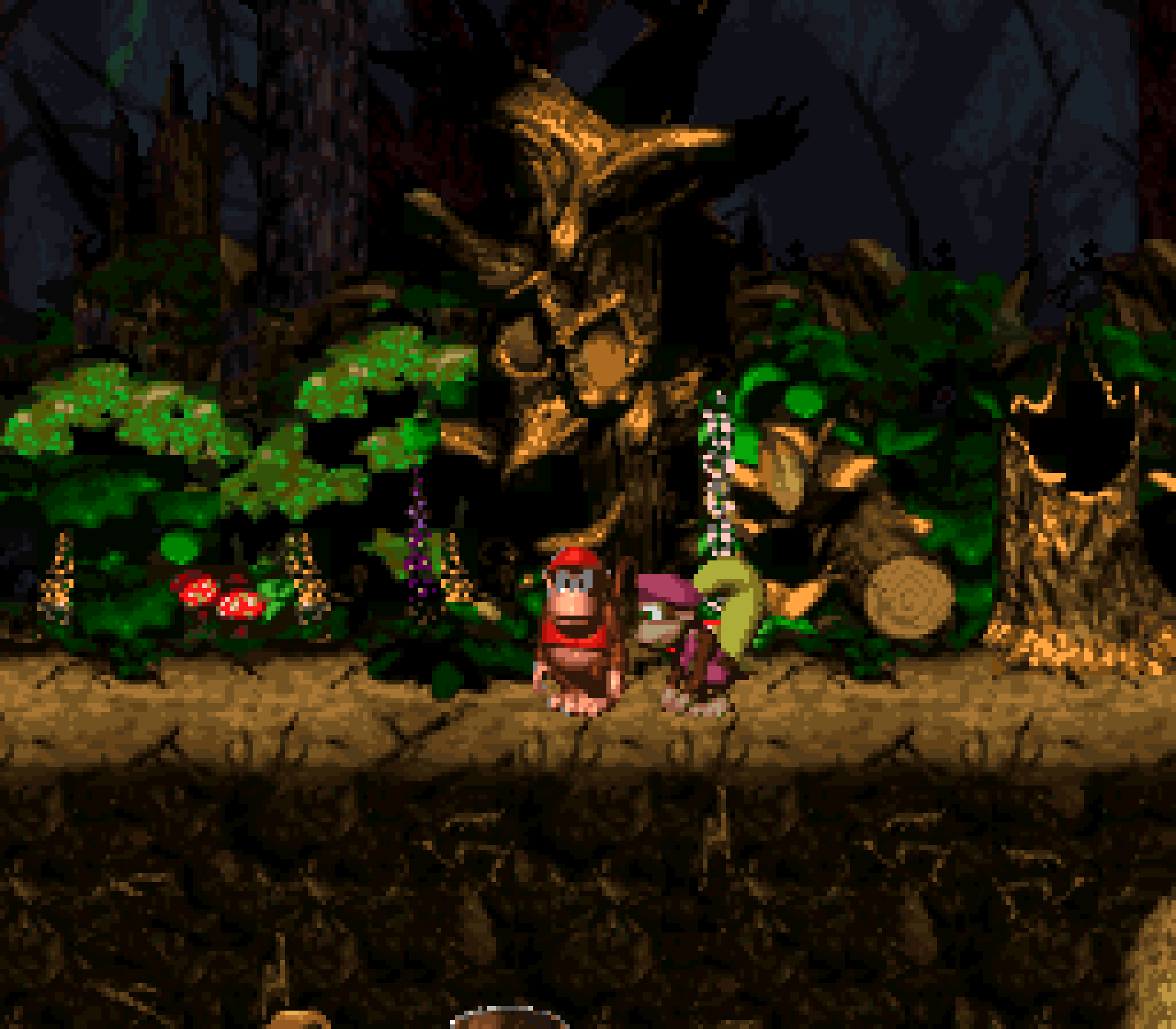
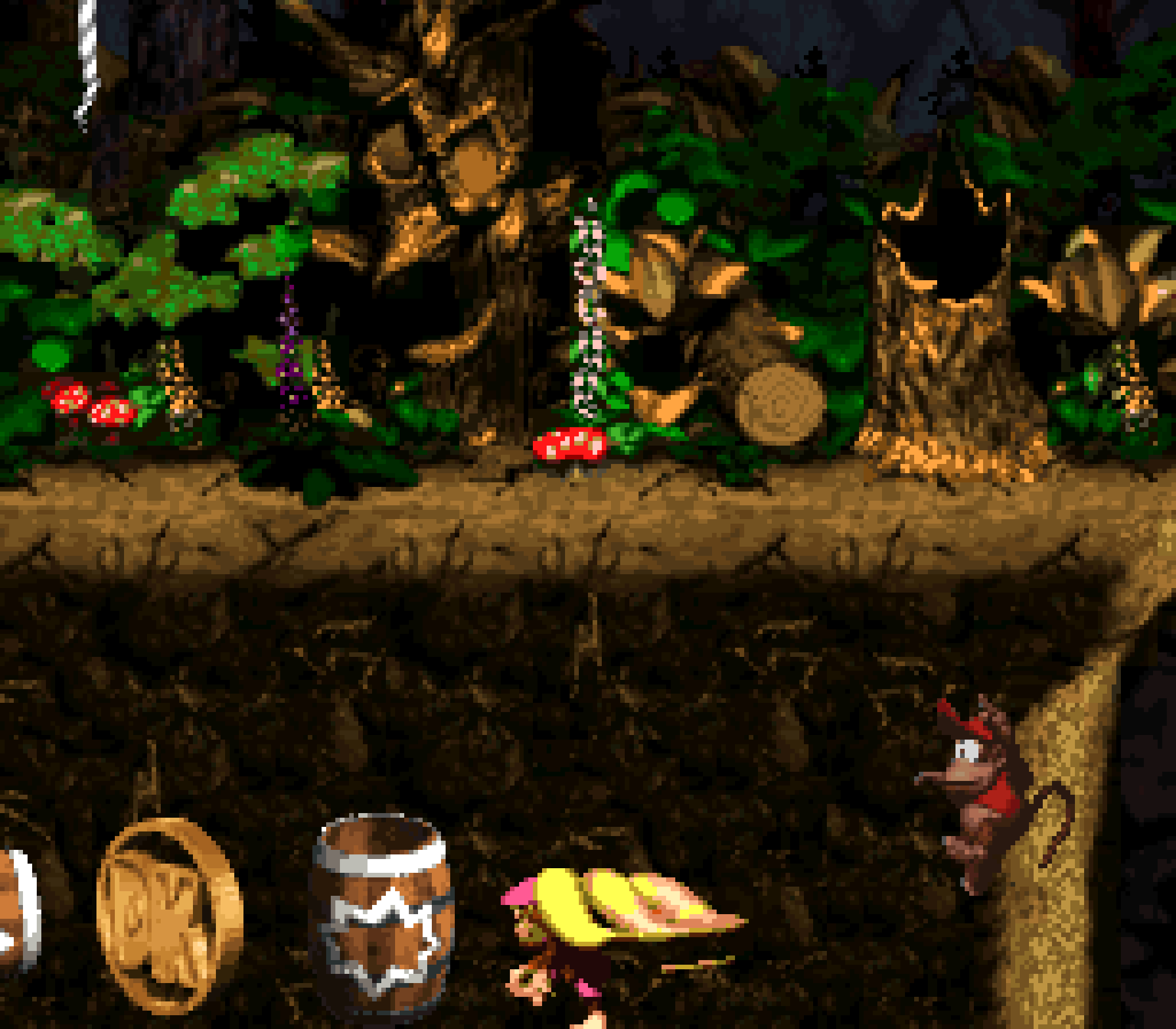
Also, for some reason, there’s a Krook with a glitched palette flying just ’bove the screen @ the start o’ the level, with only the bottom o’ its cloak visible. He doesn’t do anything in the original SNES version, but you can interact with him like any other Kloak.
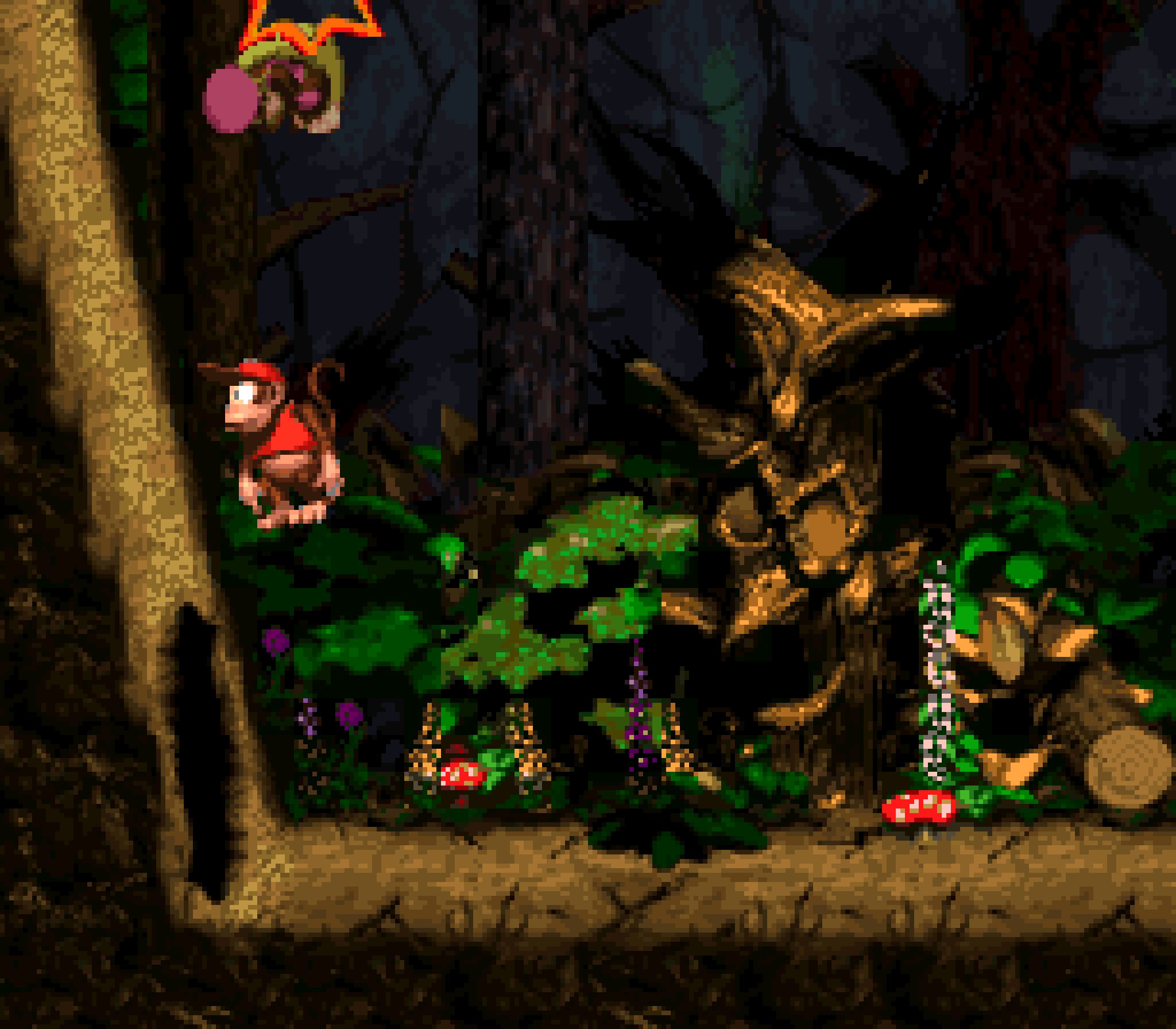
In the GBA version, they repurpose this Kloak by giving you its photo for defeating it ( while also fixing its weird palette bug & having it actually move down & be a real threat ).
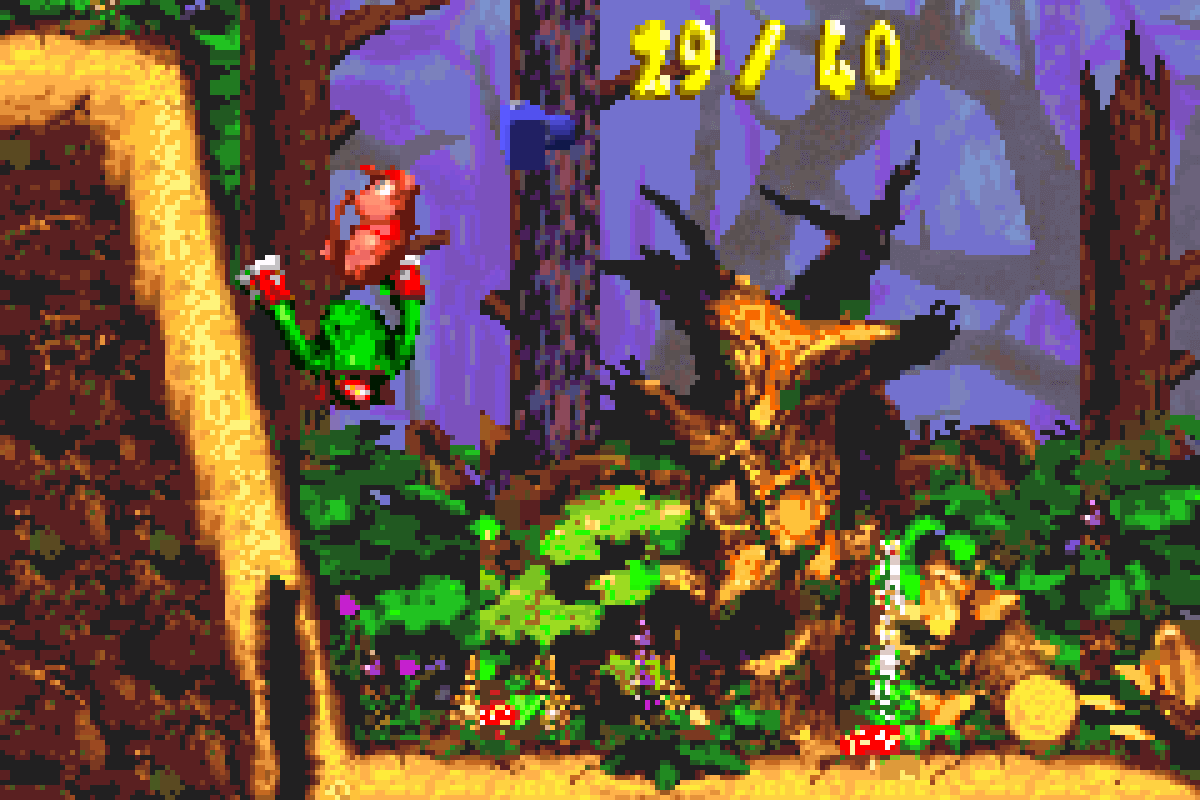
The feather is much less clever: once ’gain, you just fall into a random hole where you can maybe barely see the top o’ the feather from the bottom o’ the screen, where it turns out there’s an invisible hook.
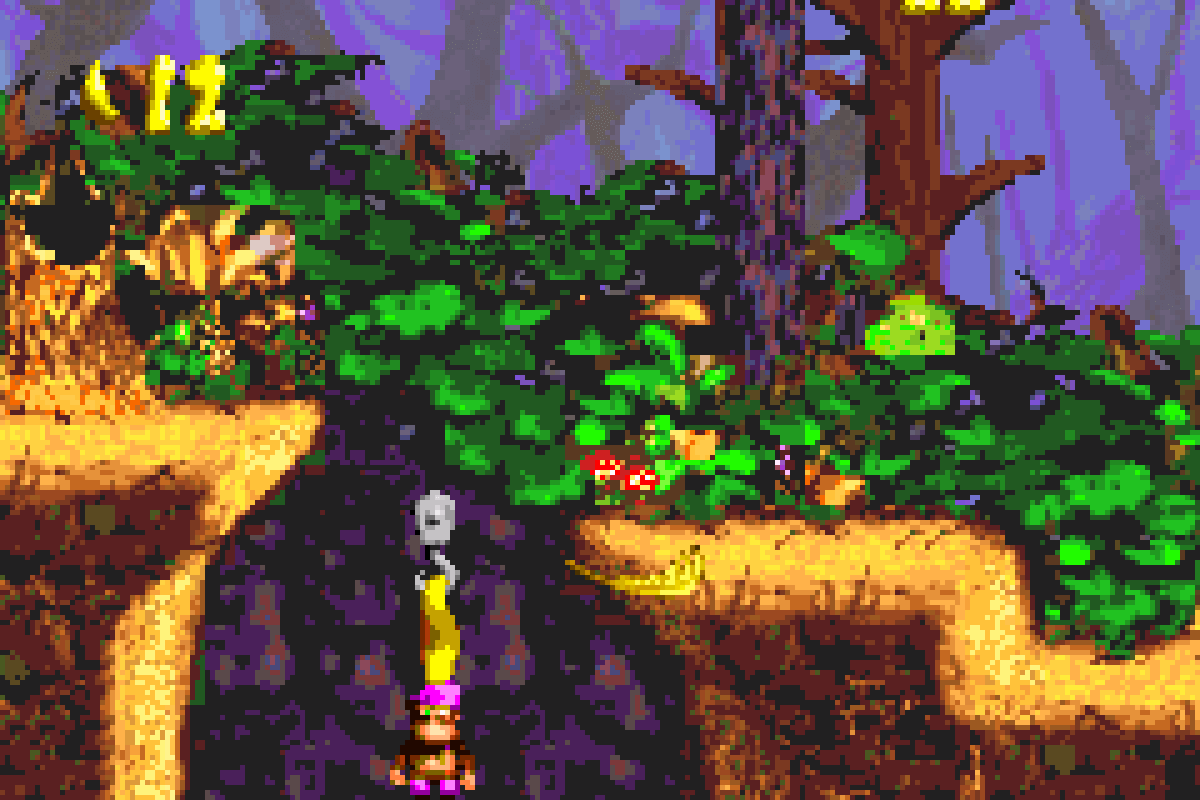
25. Lava Lagoon
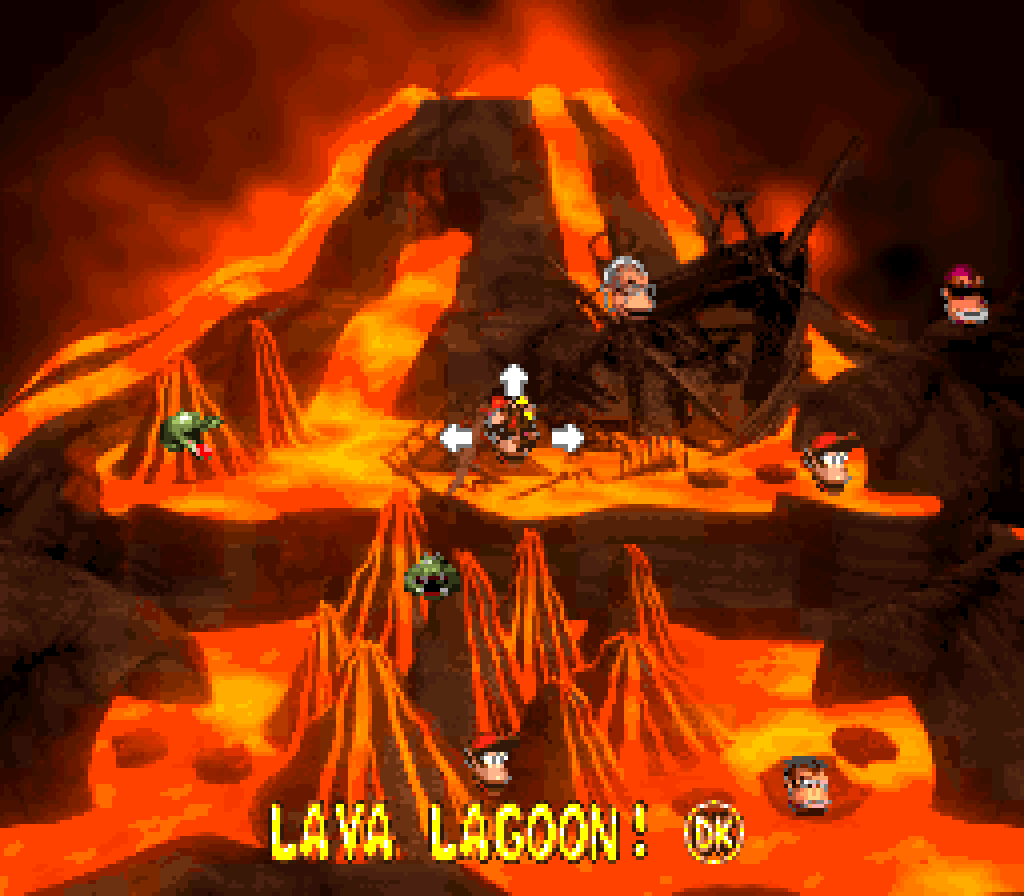
1 o’ the many cool things this game does is that when it repeats level themes it oft twists them & blends them with other themes to make them better fit in with the newer o’erarching theme o’ the world this new level is in. Here we get the best example: a water theme seamlessly integrated into a lava world thru a red palette & a unique gimmick wherein you change dangerous lava ( which looks suspiciously like just water with red dye ) to safe water. Whereas a Mario game would have this done by hitting a switch from below, in typical DKC fashion, this game has you do this by abusing seals so that they squirt water into the lava. It makes no sense, but neither does a monkey using blonde ponytails to glide.
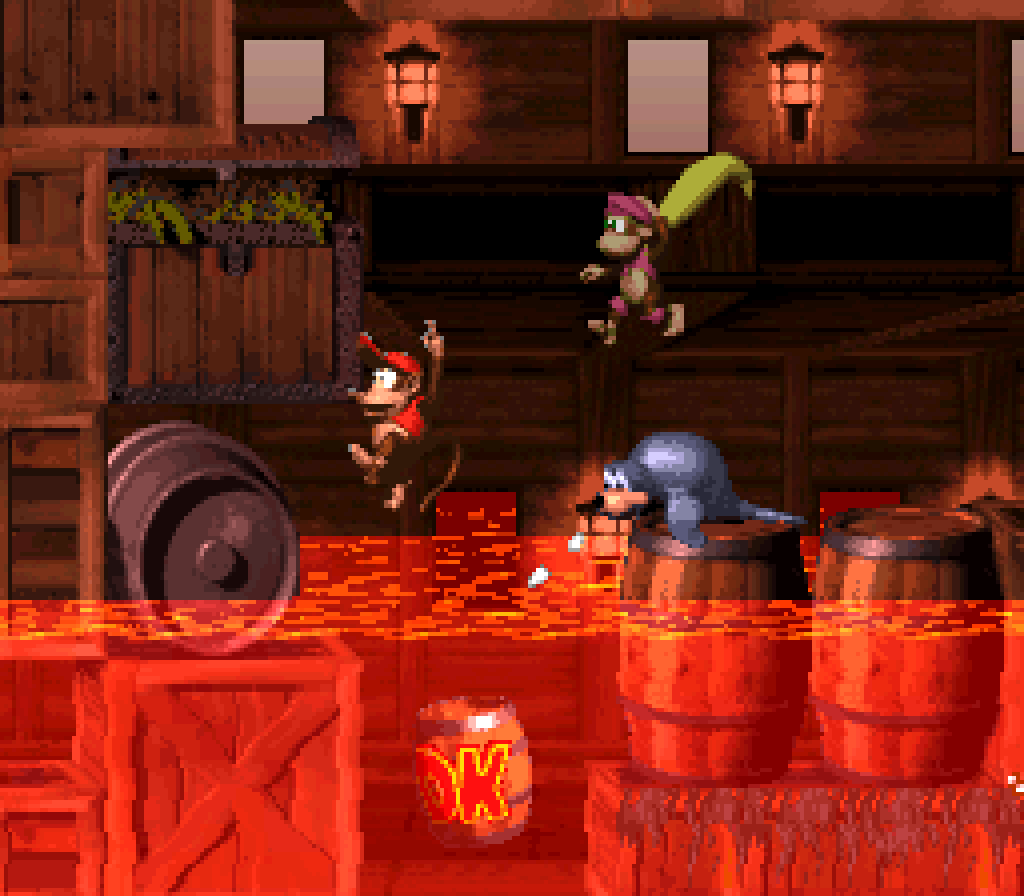
That said, the level doesn’t do anything mo’ with this gimmick than have you turn lava to water right before entering it & then go thru a short water section full o’ enemies without taking too long & letting the water warm back up to lava. The pool after the 1st Clapper doesn’t e’en have anything worth diving in to get & there’s no need to go down there, since there’s platforms you can jump ’cross ’bove. ¿I guess this section is meant as training wheels? ’Cept there’s no danger in the water after it’s been cooled & I think it’d be harder to jump from where the Clapper is to the next platform & completely miss Clapper than to hit Clapper.
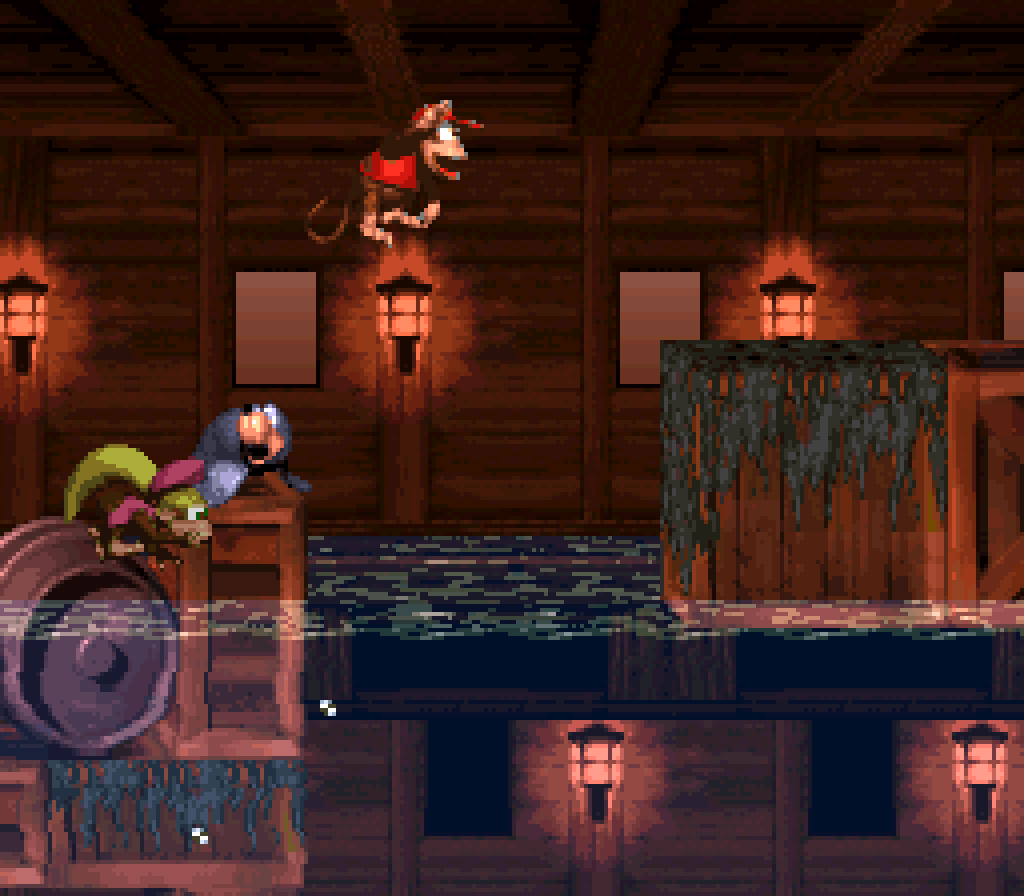
This is perhaps an example o’ a downside to having this gimmick be a seal squirting water @ lava rather than, say, a switch block: I’d say that they should’ve a’least had a section where you had to go out o’ your way to turn the lava to water & then rush back to where the water is & rush thru, but that probably couldn’t be done if the seal needs to be right next to the lava to squirt into it.
Luckily, these sections don’t go on nearly as long as some o’ the worst water levels & this level does a better job o’ balancing these sections out with a variety o’ subtly clever li’l platforming sections: things as simple as a rat going down steps @ the beginning to Click-Clacks under a low ceiling, to a single hopping Kaboing surrounded by hot water. I also like the spiral shape o’ this level’s path upward, such as the way you drop down & go left in the aforementioned Click-Clacks section.
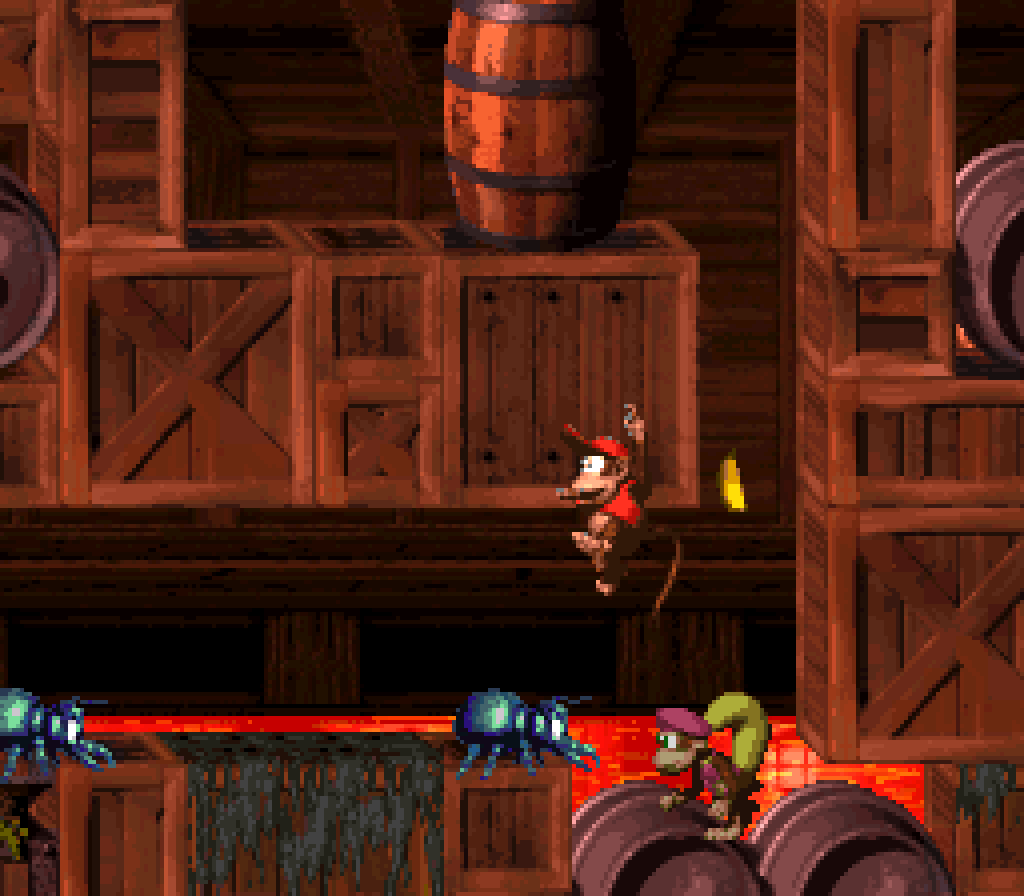
Perhaps a better setpiece is right @ the end where there’s a Klobber hiding, ready to try bumping you into the red-hot water. Granted, if you got the invincibility while getting the hero coin, you’re likely to still have it & be able to just ram thru him. Then ’gain, maybe that’s an intentional extra bonus.
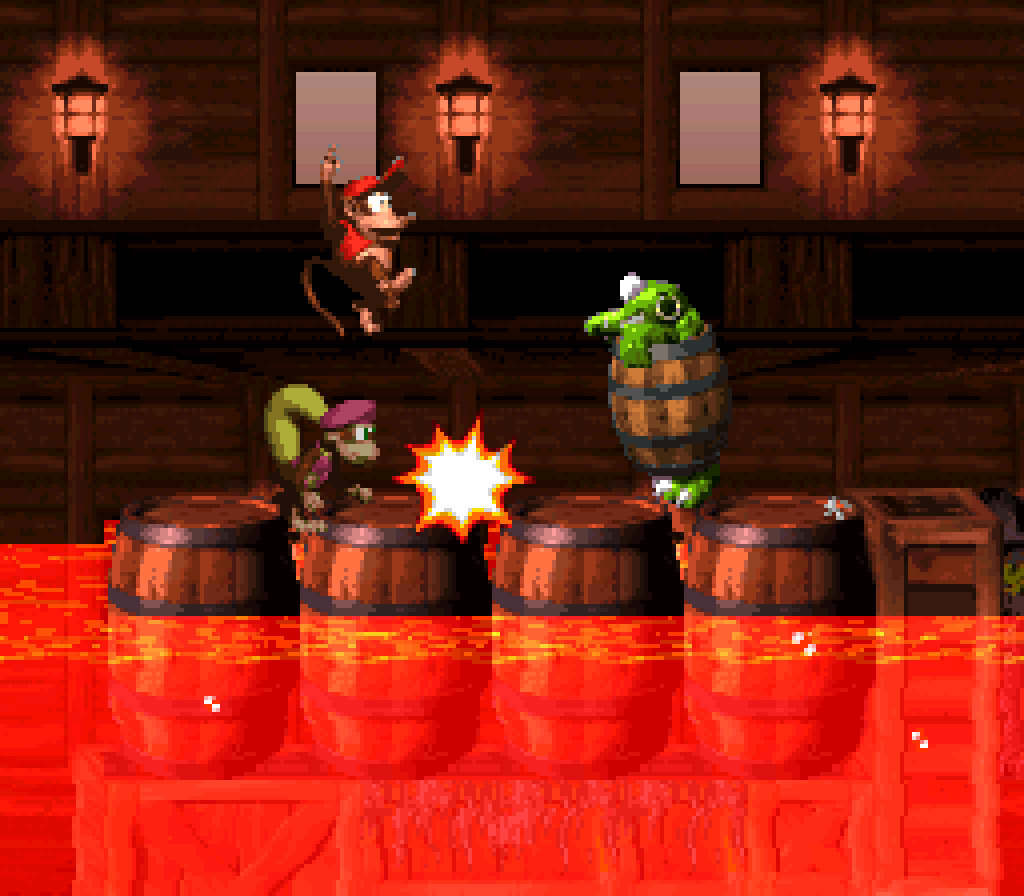
Granted, there are also some awkward sections, usually revolving round Enguarde & the finicky way the water’s rising triggers were programmed. I’m talking particularly ’bout the Clapper just after the up arrow & the midway point: the water doesn’t rise past Clapper, — which, to be fair, was probably to make it safe to stay here without getting burned by the hot water — so if you have Enguarde you need to dismount, jump up to hit Clapper, & then mount Engaurde ’gain. It doesn’t help that you sometimes remount Enguarde when trying to jump out o’ the water, which is not something you want happening while trying to rush before the water boils ’gain. & on some rare occasions the water won’t rise, e’en if you hit Clapper. The trigger seems to be higher up than Clapper, so if you make too small a jump, the scripted event doesn’t happen. Interestingly, in contrast, on the GBA version, the water rises too quickly, making it virtually impossible to not get hit by the lava as it rises before getting the chance to jump on the seal.
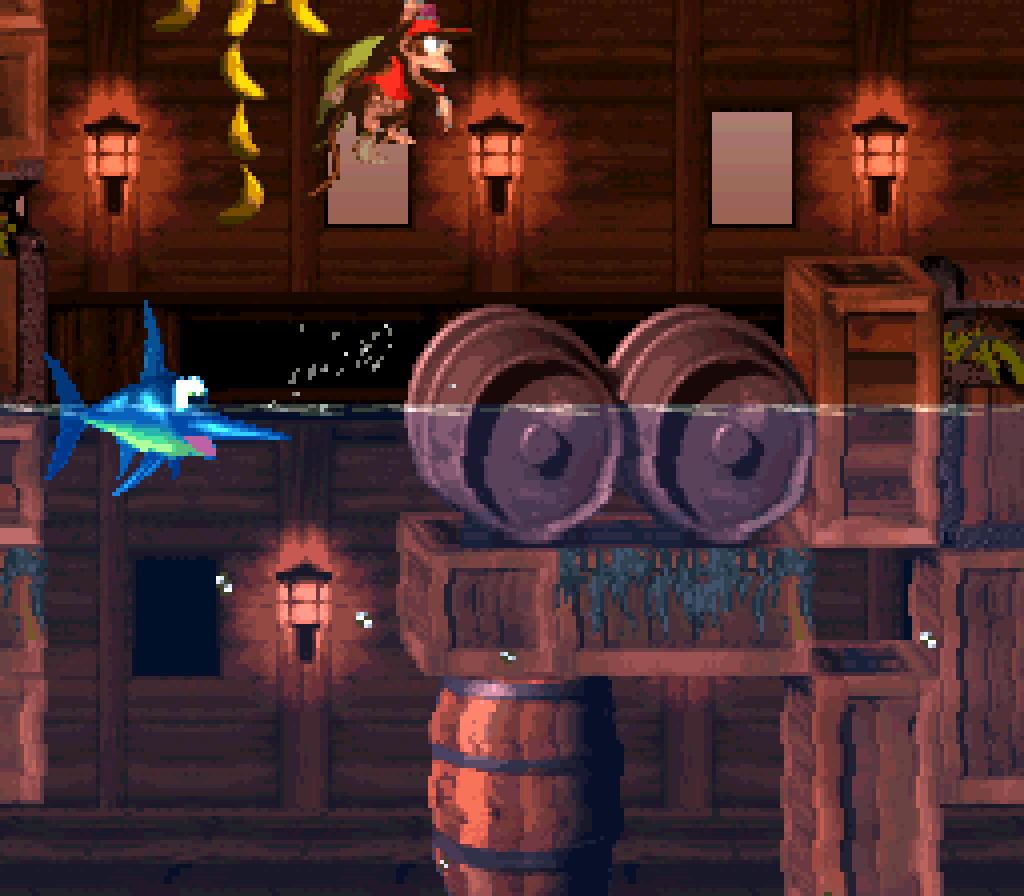
Speaking o’ bonuses, this level’s 1 bonus is very weak. The bonus is inside a crate brilliantly telegraphed by putting a banana in front o’ it & a barrel just ’bove it. I s’pose it’s better than the alternative o’ not hinting that there’s a bonus there; but in a level that zigzags all round & allows you greater movement thru swimming, not limited by gravity, which should allow for plenty o’ secret crevices, with the extra challenge o’ needing to explore while not taking too long & letting the water turn back to lava, it feels like such a missed opportunity to not hide secrets in some subtle nook rather than this lame crate that feels like it has no relevance to the level’s theme. The bonus itself is just ramming thru e’ery enemy with Enguarde. It’s not the most irrelevant bonus, but feels like it could be in any water level.
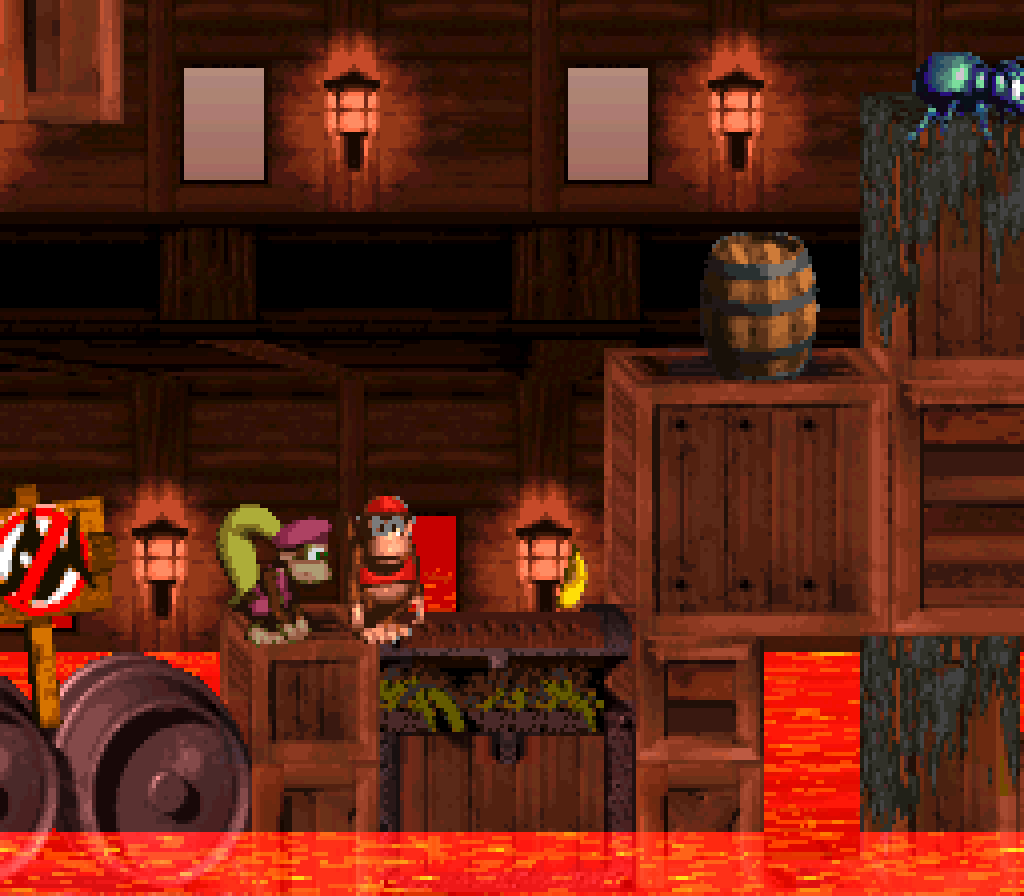
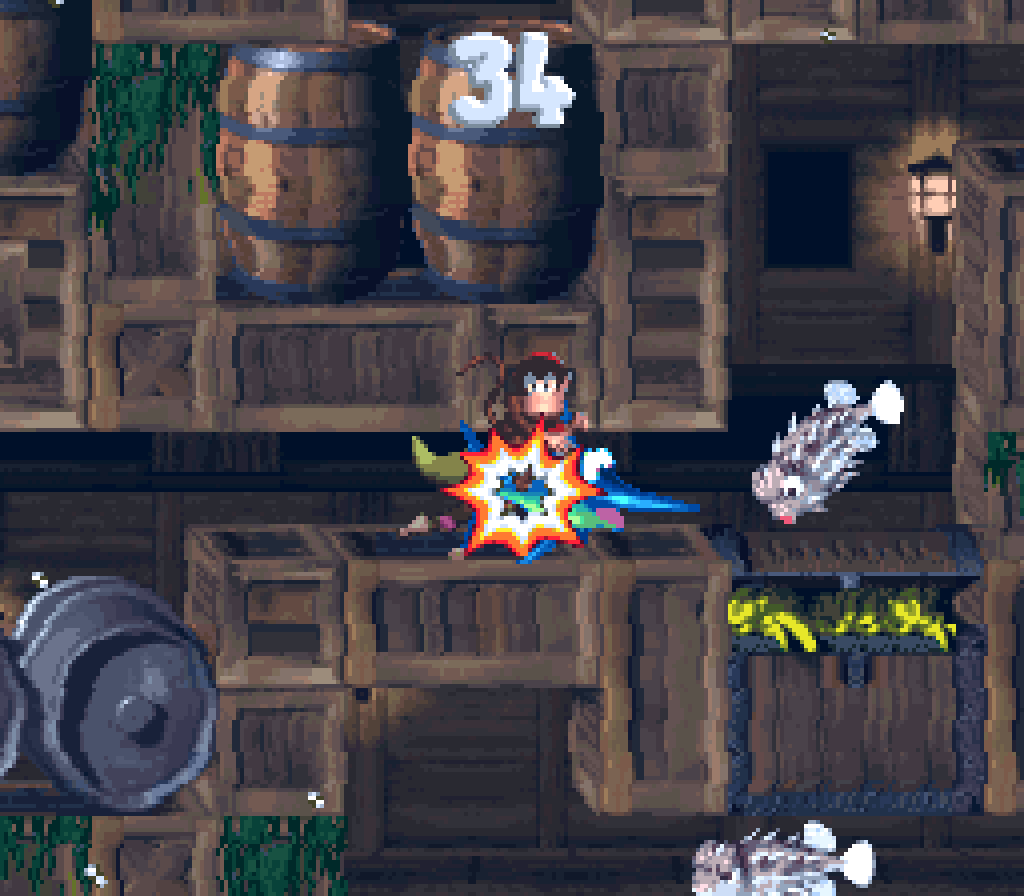
In contrast, the hero coin is hidden in a nook… ’hind magical move-thru crates that look solid. This is ’nother case where I ask, ¿why did we need the crate graphics? ¿Why not just have a thin hole here? Players likely feel an urgency to hurry & get out o’ the water before it turns back to lava, so it’s likely they’ll miss this nook, e’en if it didn’t have visuals that deliberately lied to them. The magical move-thru blocks merely changes a fine secret to a BS unintuitive 1. They do this same thing for many other hidden goodies, including Enguarde’s location, so it’s not e’en a special use o’ it, but, like, the 4th time they do this in this level ’lone. I do like the way they use the invincibility barrel here & time it so that you’re guaranteed to be swimming thru molten red water as you get the hero coin, which feels cool.
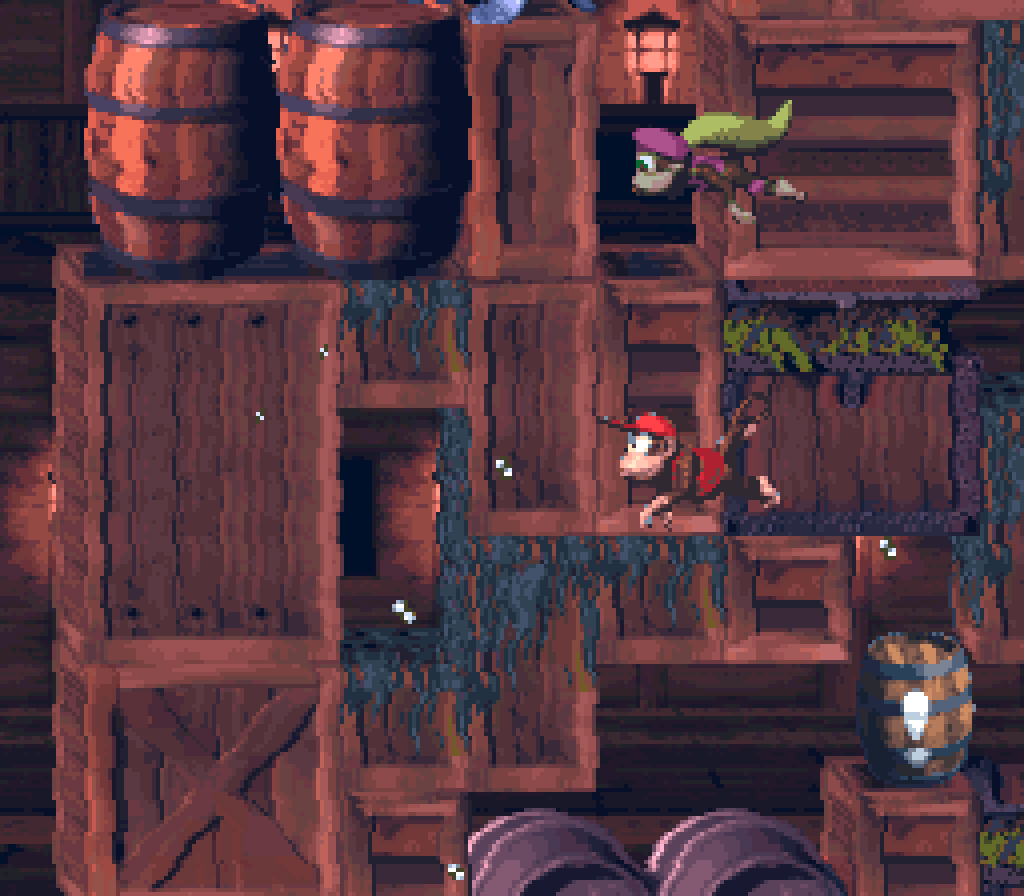
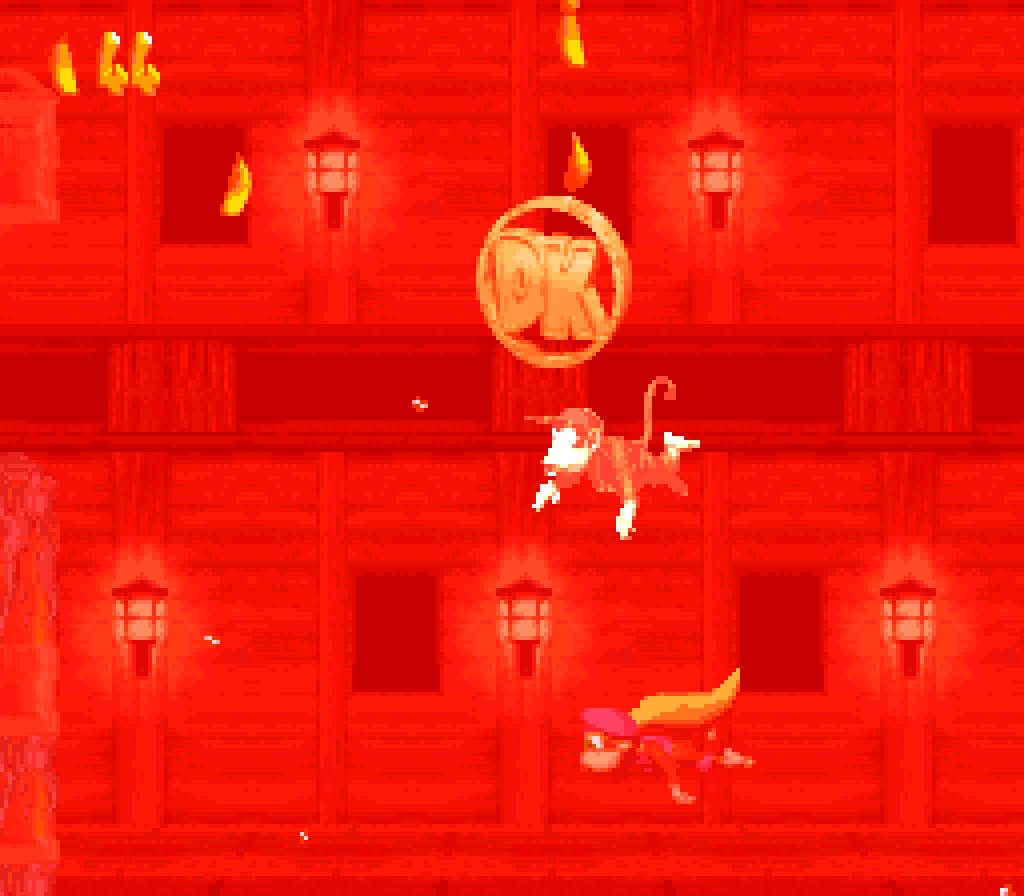
This is not the 1st use o’ the invincible barrel in this level: there’s 1 hidden up some crate formation that can be tricky to jump up halfway thru the level. Being hidden, this 1 isn’t necessary, but is mo’ utilitarian than aesthetics: while it doesn’t give you much extra time to linger in the water, since it’s also temporary, it does allow you to plow thru the ensuing onslaught o’ Flotsams. This adds a bit o’ much-needed variety to the constant pattern o’ cooling water & racing thru before it goes hot ’gain & meshes well specifically with the setpiece, unlike its earlier uses.
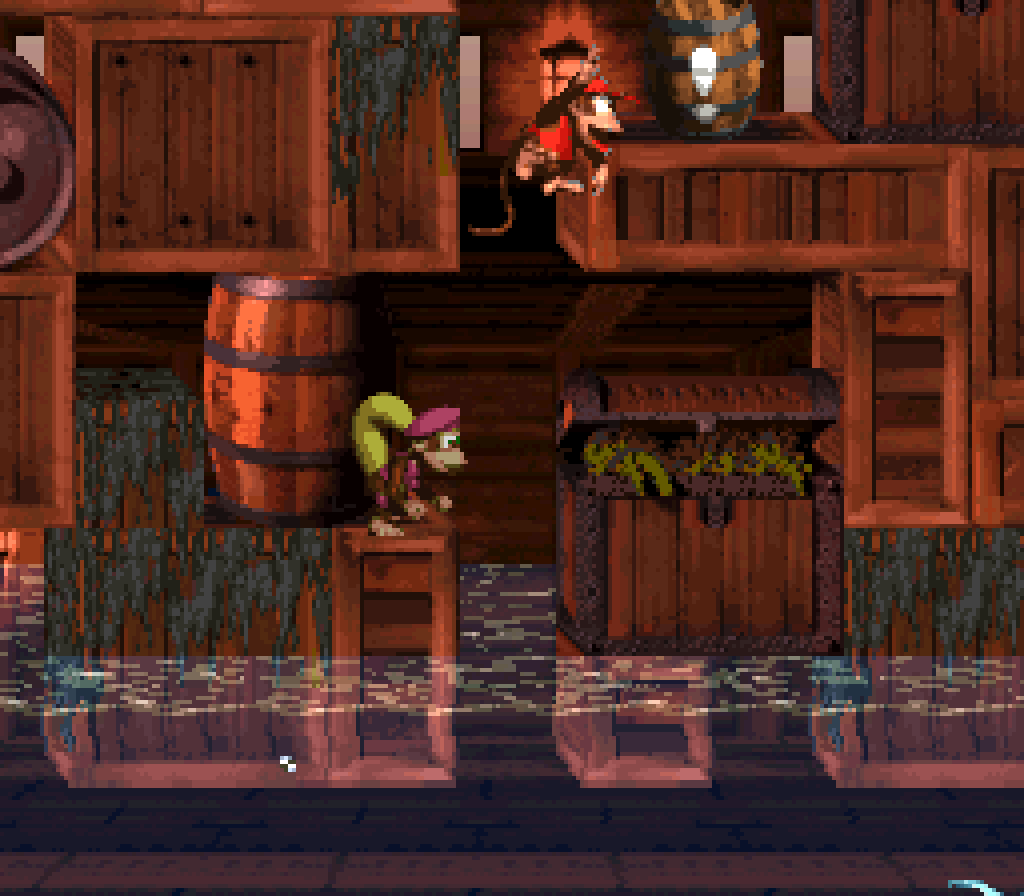
The feather is ’hind magical move-thru terrain, but it’s shown to the side o’ the part where you drop down with the Click-Clacks, so it’s mo’ clever than most.
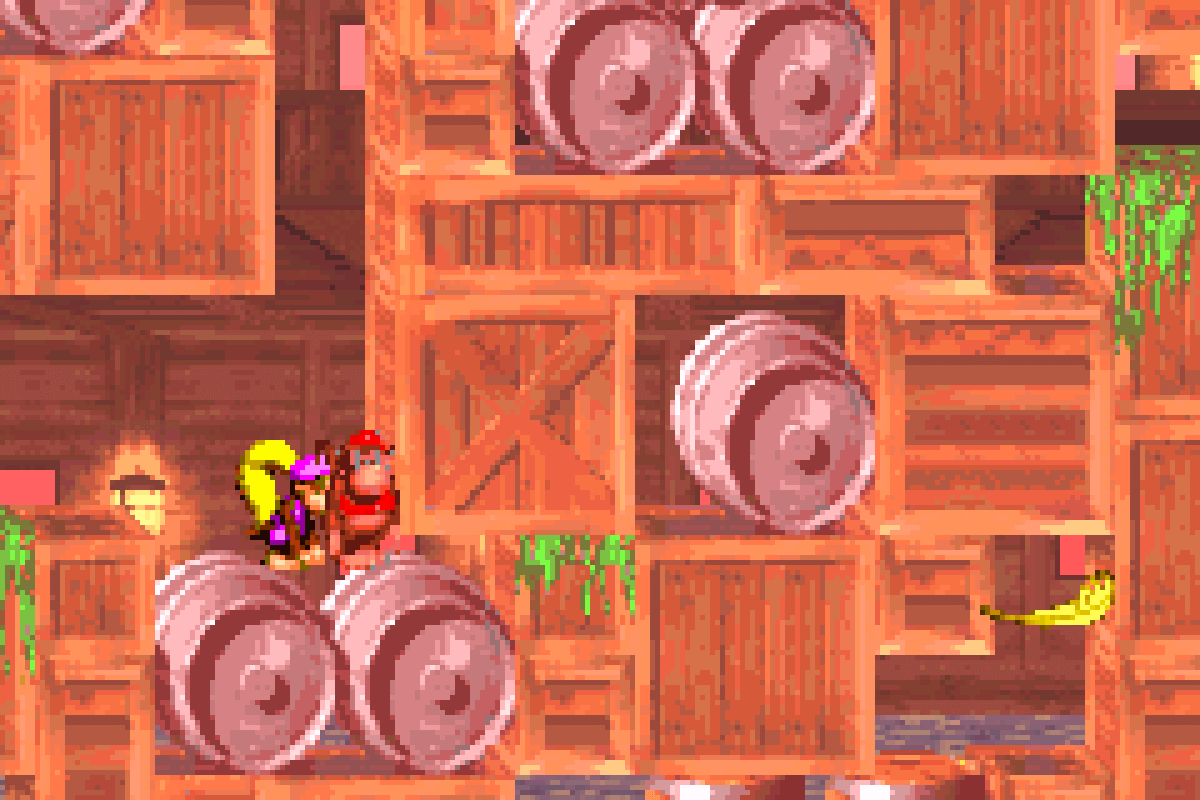
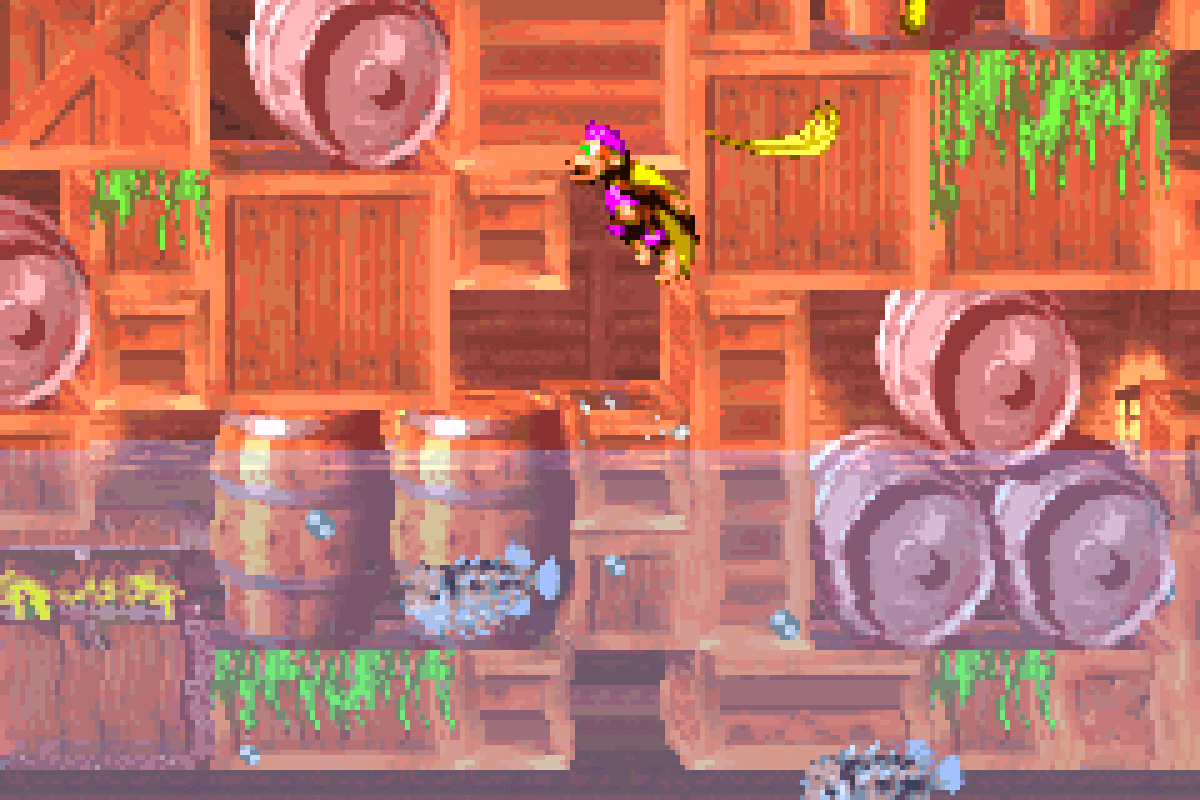
The photo isn’t bad, either, given to a Lockjaw hidden up in the secret skip @ the top left o’ the level. Granted, part o’ me thinks it would’ve made mo’ sense to have the Lockjaw photo in the level with Lockjaw’s name in it — but then maybe ’twas better to keep having to defeat the harder underwater enemy for a later level.
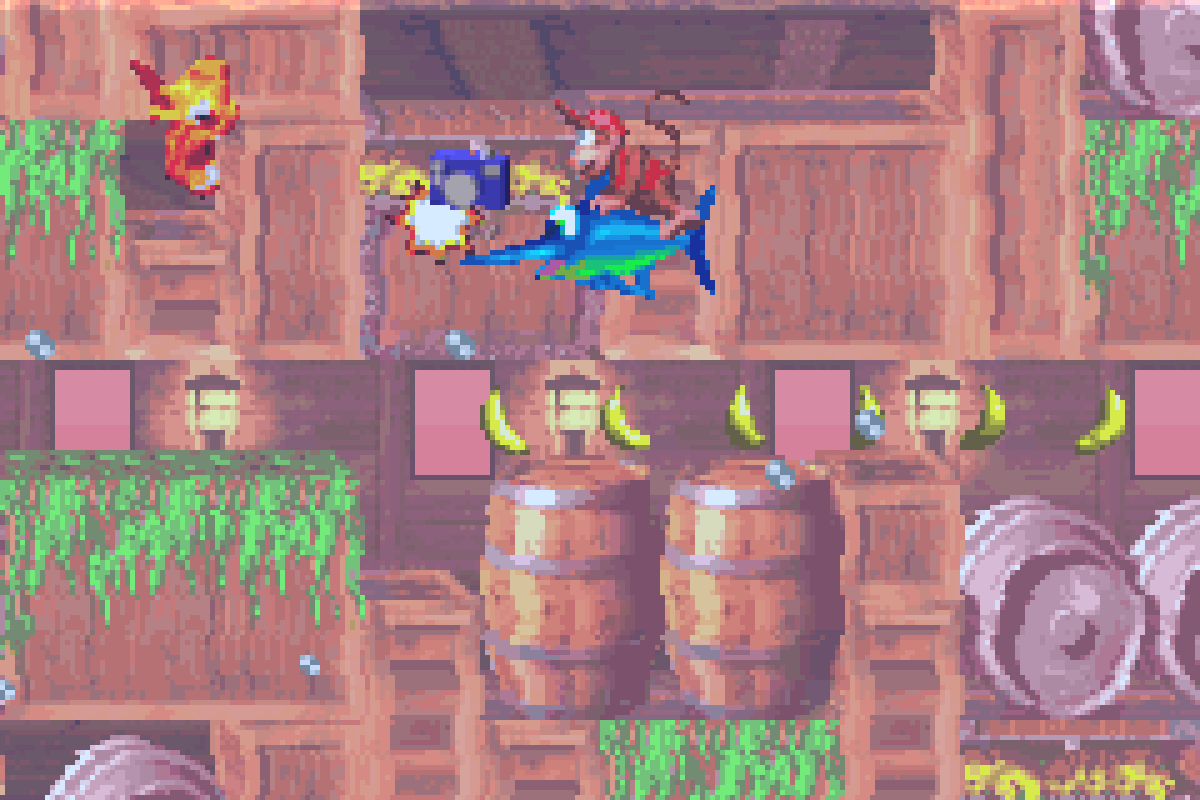
24. Mainbrace Mayhem
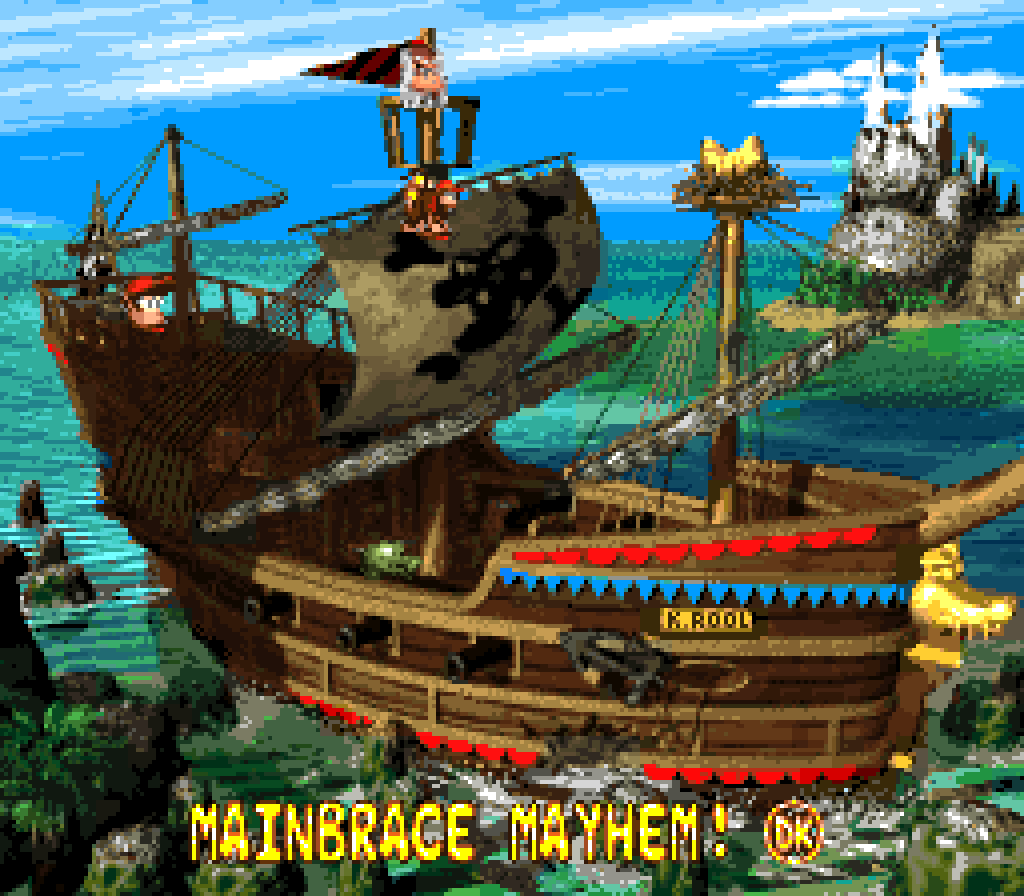
Odd trivia: every DKC game seems to have their 2nd level focus on hanging onto things in some way, whether it be the swinging ropes in DKC1’s “Ropey Rampage”, the door-opening pulleys in DKC3’s “Doorstop Dash”, or the moss in the Returns games’s 2nd level. My best guess is that this association was build by Donkey Kong Jr., the 2nd game in the classic Donkey Kong trilogy, focusing so much on hanging onto vines. In this level’s case, it’s net hung ’long the ship masts with up-&-down-climbing Klingers. It’s the best integration o’ gameplay mechanic with theme & visuals ’mong the games, but a fairly basic mechanic in itself.
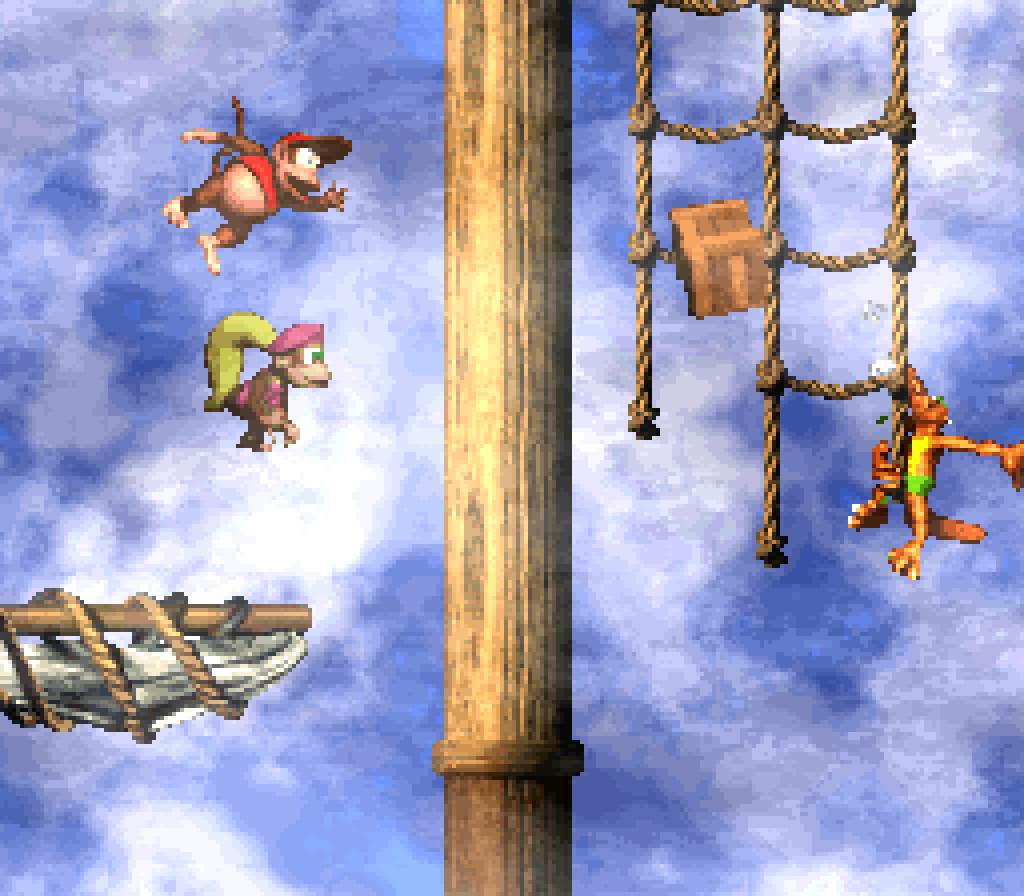
Thankfully, this mechanic doesn’t o’erpower the entire level, but only takes up ’bout half, if e’en that much, & is balanced out with sections designed to test out your ability to defeat enemies in long columns, as well as providing subtly-integrated setpieces for testing mechanics, such as the bonus far off in the distance near the start as a way to test your ability to use Dixie’s ponytail glide ( which was not tutorialized @ all in the 1st level ), the barrel a li’l afterward just before the row o’ Neeks, the cannon ball & bonus cannon near the middle ( full o’ enemies, who, when the player attacks them, teaches them they drop their cannonball if they jump on said enemies & teaches them they can attack enemies with the cannonball itself, specially if they remembered the barrel tutorial earlier ), & a crate just before a Klinger, which the player can throw @ them to make the next path safer. Unlike “Pirate Panic” before this level, “Mainbrace Mayhem” doesn’t shout its tutorials right @ the player, & it certainly doesn’t force players to engage in them, but just subtly integrates them into the level as if natural, rather than insulting the players’ intelligence by hammering them in. I would suspect that most players probably ne’er e’en considered this level to be much o’ a “tutorial” level, but just a series o’ neat obstacles, the lessons they learned ’bout the game coming to them almost subconsciously.
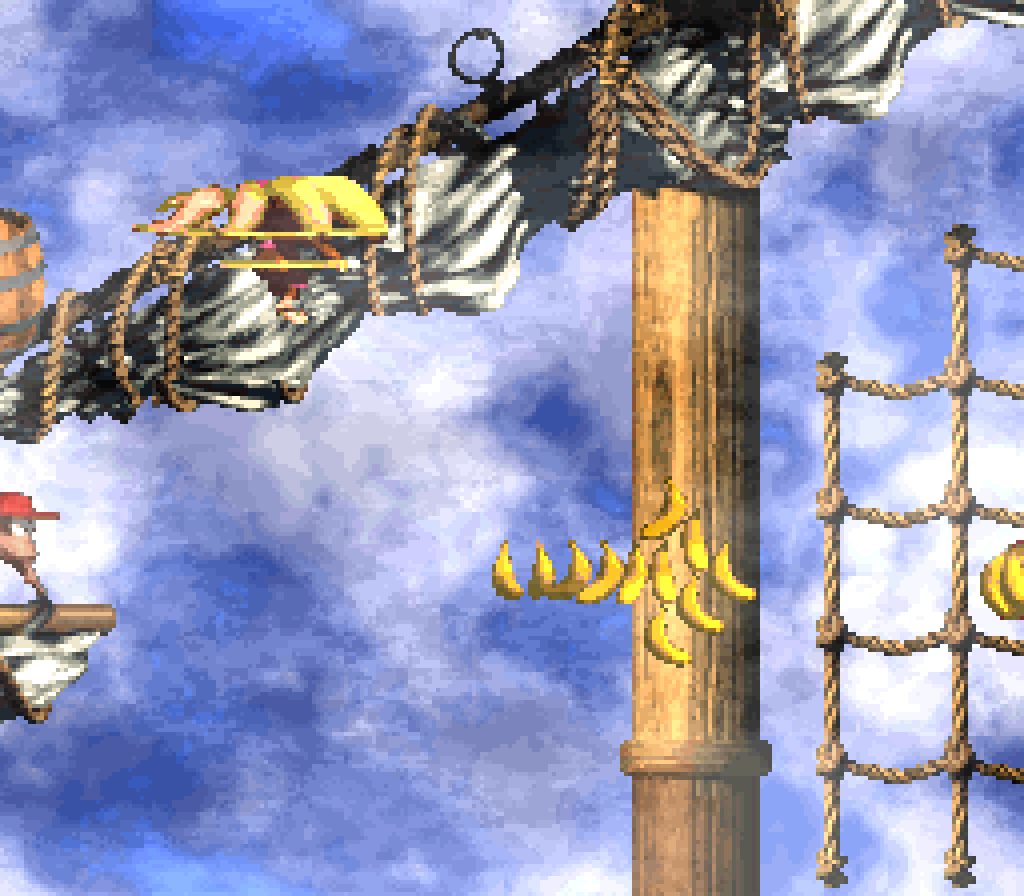
& all o’ this is wrapped up in a mo’ vertical layout that breaks ’way from the heavy pattern o’ left-to-right that most levels in this series have, weaving right & left as you go upward, with plenty o’ secret niches going down nets off the main path, allowing for plenty o’ extra niches full o’ bananas & extra lives.
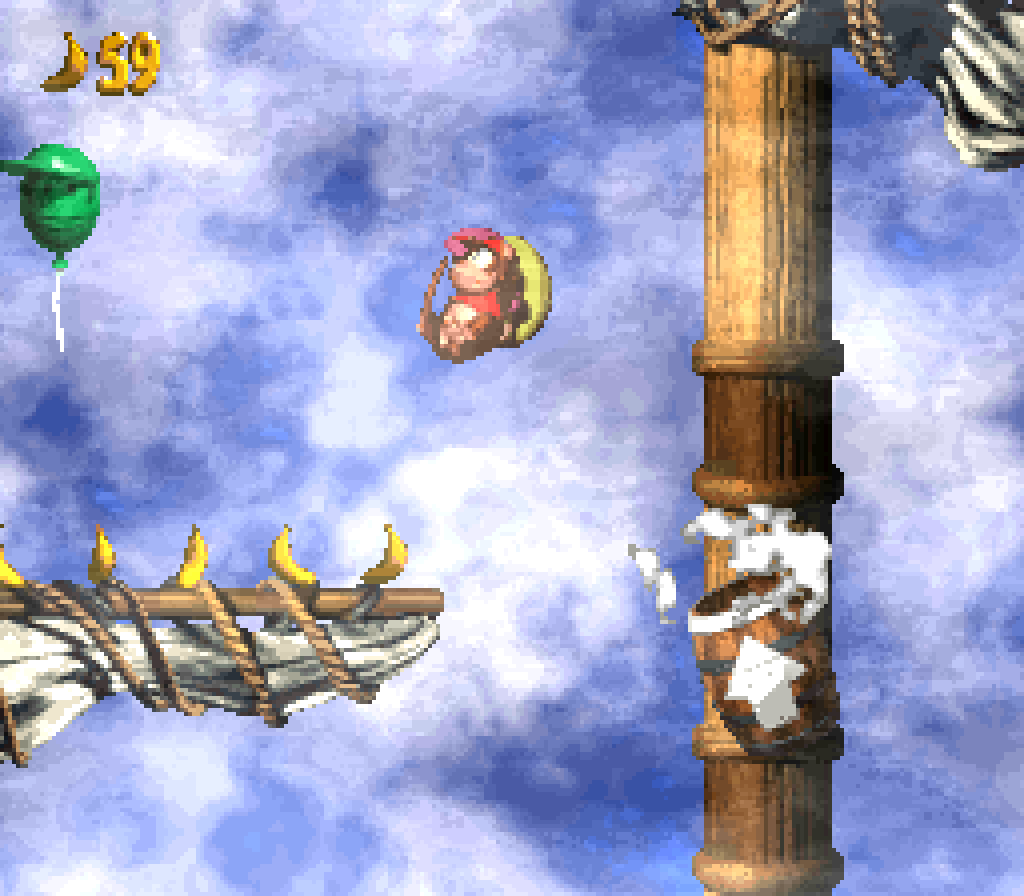
Despite all these niches, this level’s hero coin location isn’t all that imaginative: to the right o’ the secret top area you get warped to after the final bonus, basically guaranteeing you get this if you get the final bonus. ’Gain, considering all the extra areas in this level, surely there was a better place to put this. In fact, I can say definitively that swapping the hero coin & the green balloon near the middle would’ve made mo’ sense. It does show, howe’er, the carefully crafted timing o’ these levels that if you drop down from up on those sails down to the goal it’ll always be timed to be on the 1-up balloon.
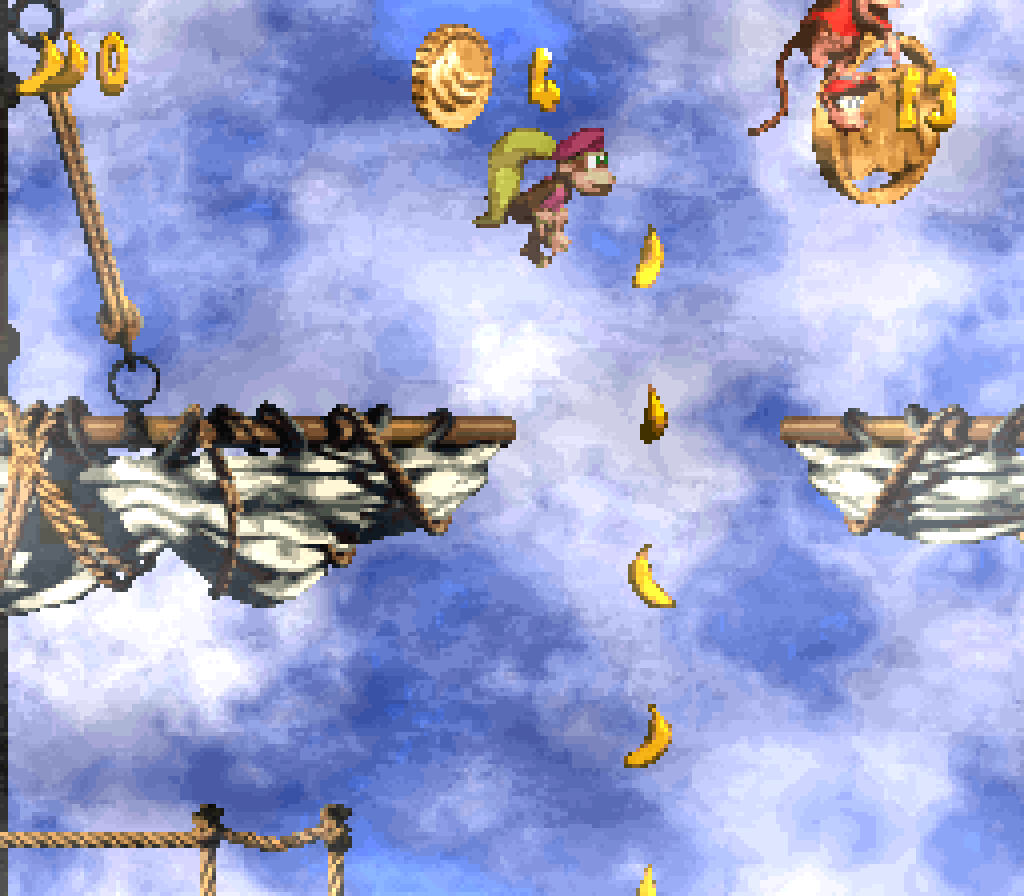
In fact, they used a similar hiding place for the feather in the GBA version, up on a platform off to the side that requires Dixie’s ponytailglide to reach.
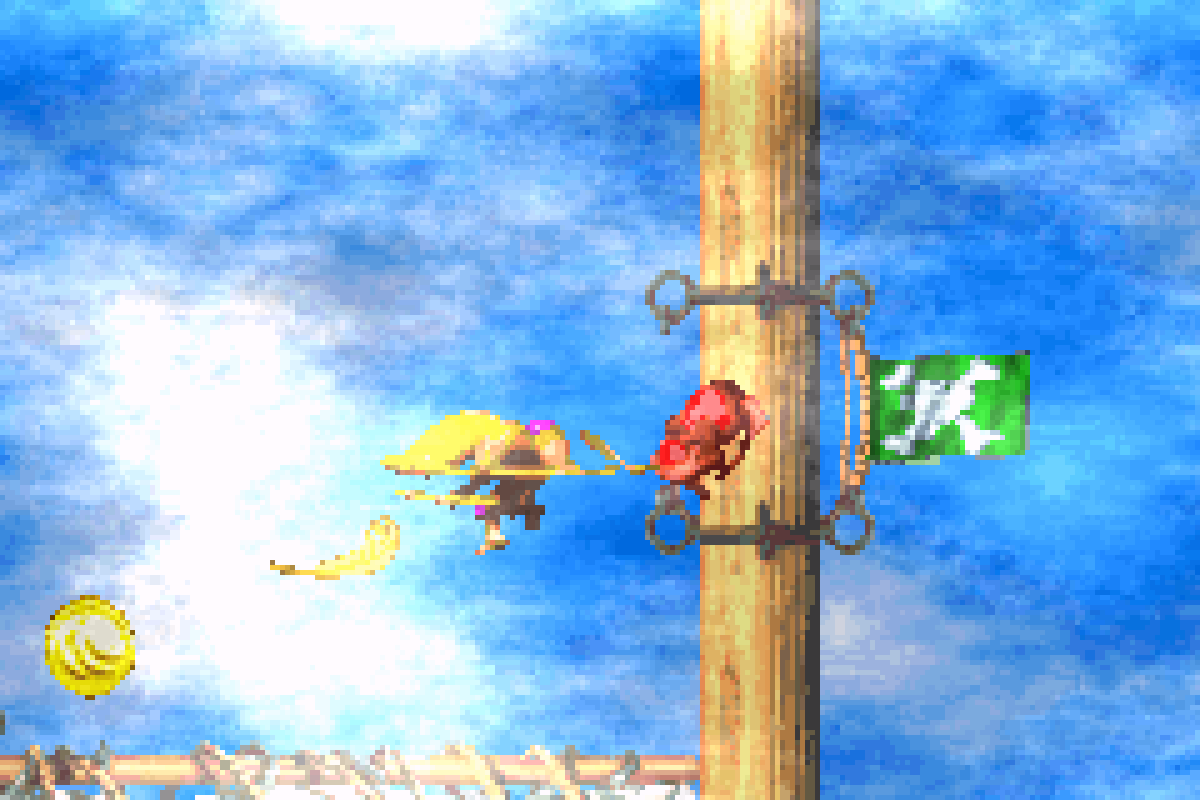
I do question the need for having all 3 bonuses, specifically both the bonuses revolving round climbing rope nets, with the 1st just having you go in a straight path to the end & the 3rd having you collect stars. The latter is a good way to introduce this type o’ bonus while integrating it with the net-climbing mechanic, but the former feels redundant. Then ’gain, I do like all their hiding places: the 1st tests out your knowledge o’ Dixie’s hair twirl, the 2nd shows off the cannon ball/cannon bonus mechanic, & the 3rd is hidden in an out-o’-the-way area, indicated only by a lone banana off to the side.
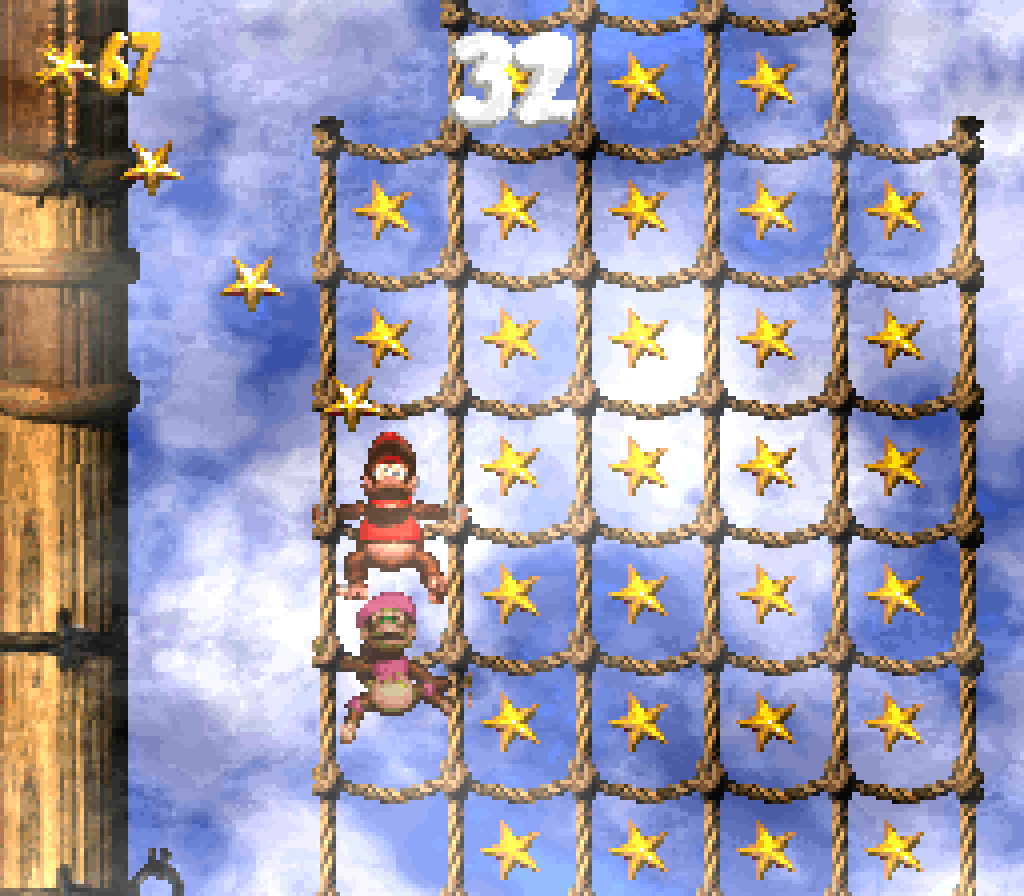
Thinking ’bout it, it makes me wonder if this level perhaps has too many elements that distract from the rope-climbing mechanic, as basic as it is. ¿Did we need to show off both the hair twirl & cannon ball/canon mechanic in the same level? This is specially considering how lacking the level after this, “Gangplank Galley” feels. It might’ve been better to spread out some o’ the mechanics in this level to that one.
I like how they went thru the extra trouble to add this 2nd pirate theme, alternating ’tween this & the 1st level’s on-ship theme to create better variety, while still keeping to the world’s theme better than any other world. The visuals are simpler, specially the background, which is just clouds, but the layouts tend to be mo’ intricate, trading flat horizontal paths for zigzagging vertical paths. The music, “Jib Jig”, is also much better, being catchier & mo’ fast-paced, with its wind sounds far mo’ pleasant on the ears than the squeaky wood clanking o’ “Klomp Romp”.

